Hey Secrets readers, it’s time once again for our annual Capital Audiofest coverage. This year, Secrets reviewer Craig Chase will be filing reports from the Hilton Hotel in Rockville, Maryland where the show will be held once again from Friday, Nov 8 to Sunday, Nov 10th. This premier show has been steadily growing year over year to become one of the major HiFi events on the North American calendar.
There have already been several important announcements ahead of the show. Be sure to check in regularly on this page along with our Facebook and Instagram feeds to get the latest updates from the show. We hope you enjoy our continuing coverage.
All the best.
Carlo Lo Raso
Editor-In-Chief.
The Capital Audiofest or “CapFest” is running from Friday, November 8 until Sunday, November 10 in the year of our Lord 2024. It’s a different show in contrast to years past. A lot of the audio companies that used to have their own dedicated suites are going to a new model for the shows in which they partner with audio stores that bring multiple companies into each listening room. This trend will likely bring benefits in future shows as the companies involved get some experience with putting together systems that are well balanced from top to bottom. There were a lot of dedicated manufacturer’s rooms as well, so let’s take a look, over the next three days, at both some new models and old friends!
Day One: Friday
Teac introduces new headphone amps
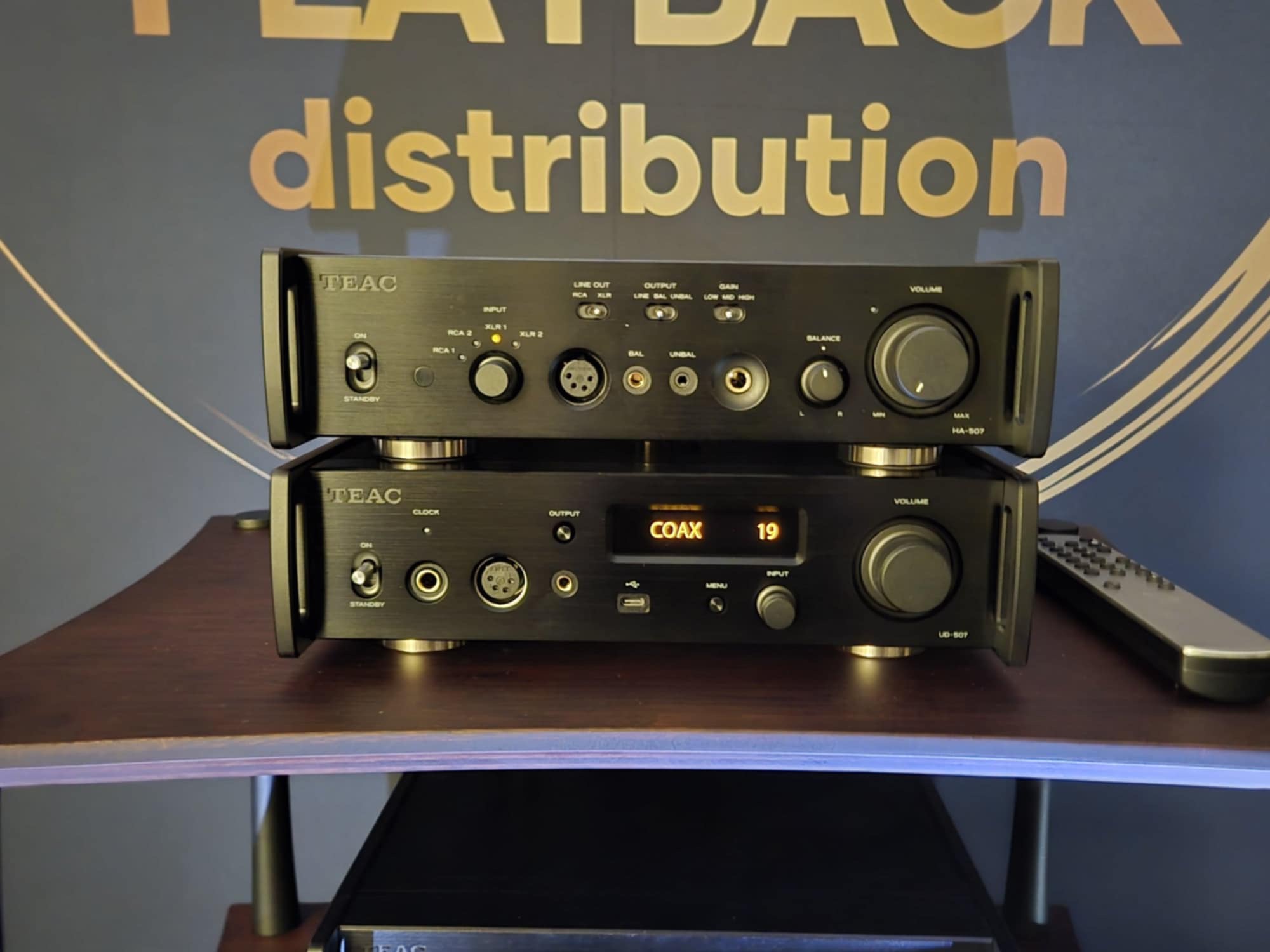 TEAC was introducing two new headphone amps. The first is the UD-507 Fully Balanced Dual Monaural Headphone Amplifier. The UD-507, which is equipped with an in-house built, proprietary discrete DAC (the TRDD 5), is meant to be the ‘hub’ of the system.
TEAC was introducing two new headphone amps. The first is the UD-507 Fully Balanced Dual Monaural Headphone Amplifier. The UD-507, which is equipped with an in-house built, proprietary discrete DAC (the TRDD 5), is meant to be the ‘hub’ of the system.
The UD-507 is a headphone amplifier featuring the TEAC-HCLD2 high current line driver, which is characterized by its high current supply capability as part of a fully Balanced Dual Monaural Headphone Amplifier. The UD-507 improves on previous models with a new power supply, resulting in a generous driving power of 1,200mW + 1,200mW (balanced output at 100-ohm load). The power amplifier gain can be switched between 3 positions (Low/Mid/High) to fine-tune the output to best match the sensitivity and impedance of the headphones.
The UD-507 also includes a High-Quality Preamplifier with Multiple Analog/Digital Inputs. There are five digital inputs and two analog inputs (unbalanced and balanced) so a wide variety of devices can be connected. Multiple Bluetooth connections are supported, and the unit even has XLR (balanced) and RCA (unbalanced) outputs, making the UD-507 into a versatile pre-amp as well as a high-quality headphone amp. For the $2099 asking price, it offers a LOT of value.
Also on display was the new HA-507 ANALOG headphone amp. At $1999, the HA-507 features dual RCA (unbalanced) inputs and dual XLR (balanced) inputs. Of note is the built-in 6.5 watt per channel (32 ohms) power output that is designed to drive even the most difficult headphone loads. As with the UD-507, the HA-507 would make a worthy system pre-amp as well as a headphone amp with XLR and RCA line outputs.
PMC TWENTY5 22i MONITORS
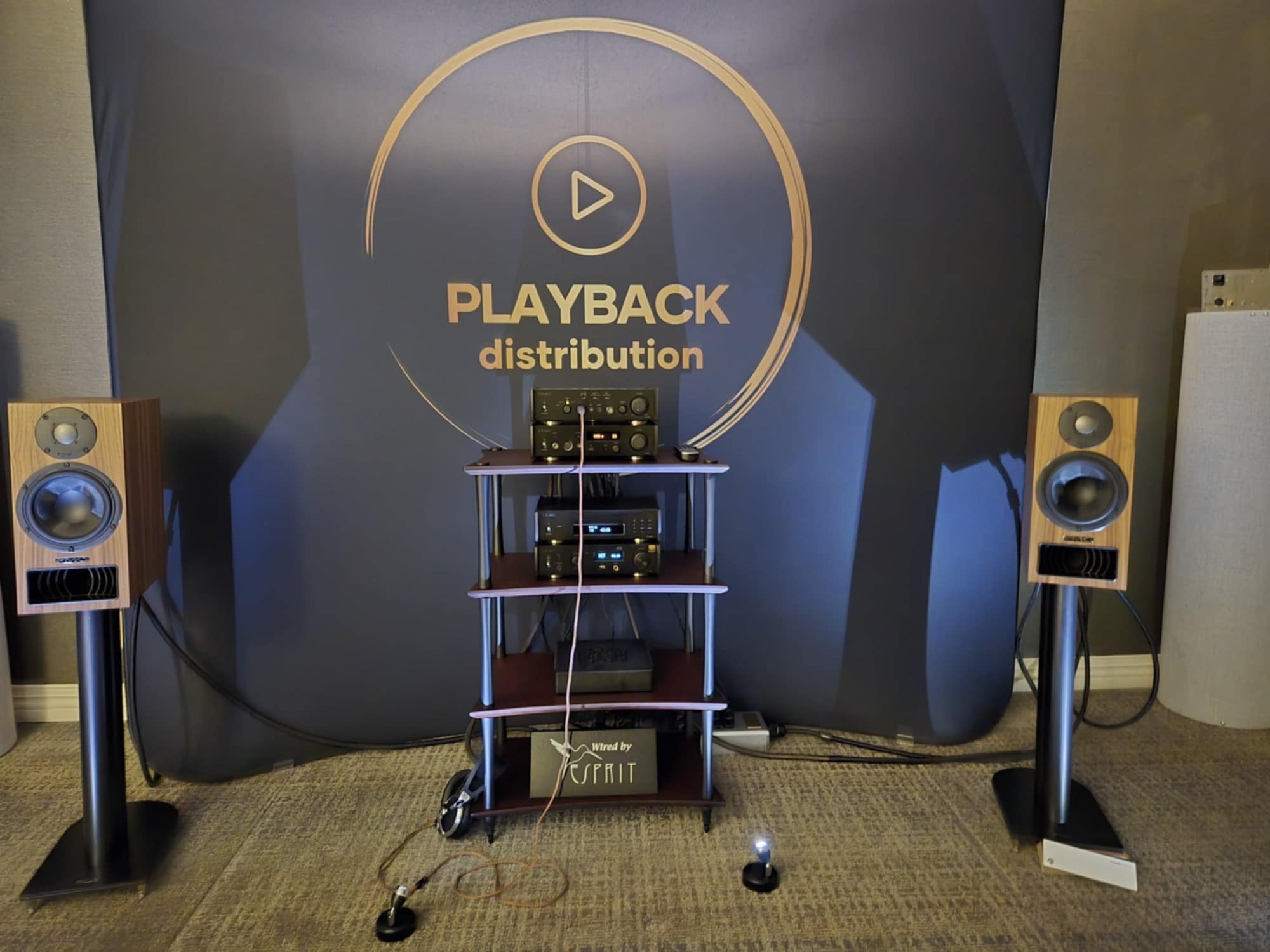 In the USA, both TEAC and PMC are distributed by Playback Distribution, so it is only fitting that the above-mentioned TEAC UD-507 was controlling a pair of PMC TWENTY5 22i monitors @ $4999 per pair (optional stands are $599). Featuring ATL Bass-Loading – which PMC states will deliver a natural, realistic sound and deeper bass from a smaller cabinet. The Laminair Ports are designed to deliver faster, cleaner bass with less air noise due to reduced turbulent airflow.
In the USA, both TEAC and PMC are distributed by Playback Distribution, so it is only fitting that the above-mentioned TEAC UD-507 was controlling a pair of PMC TWENTY5 22i monitors @ $4999 per pair (optional stands are $599). Featuring ATL Bass-Loading – which PMC states will deliver a natural, realistic sound and deeper bass from a smaller cabinet. The Laminair Ports are designed to deliver faster, cleaner bass with less air noise due to reduced turbulent airflow.
The drive units are a 6.5-inch woofer and 0.75-inch dome tweeter sourced from SEAS. Driven by a TEAC power amplifier, the PMC monitors impressed with solid bass and excellent overall tonal balance in a difficult room.
Audiovector Trapeze RI – J. Sikora Max Supreme Turntable – Doshi Mono-Block Amplifier
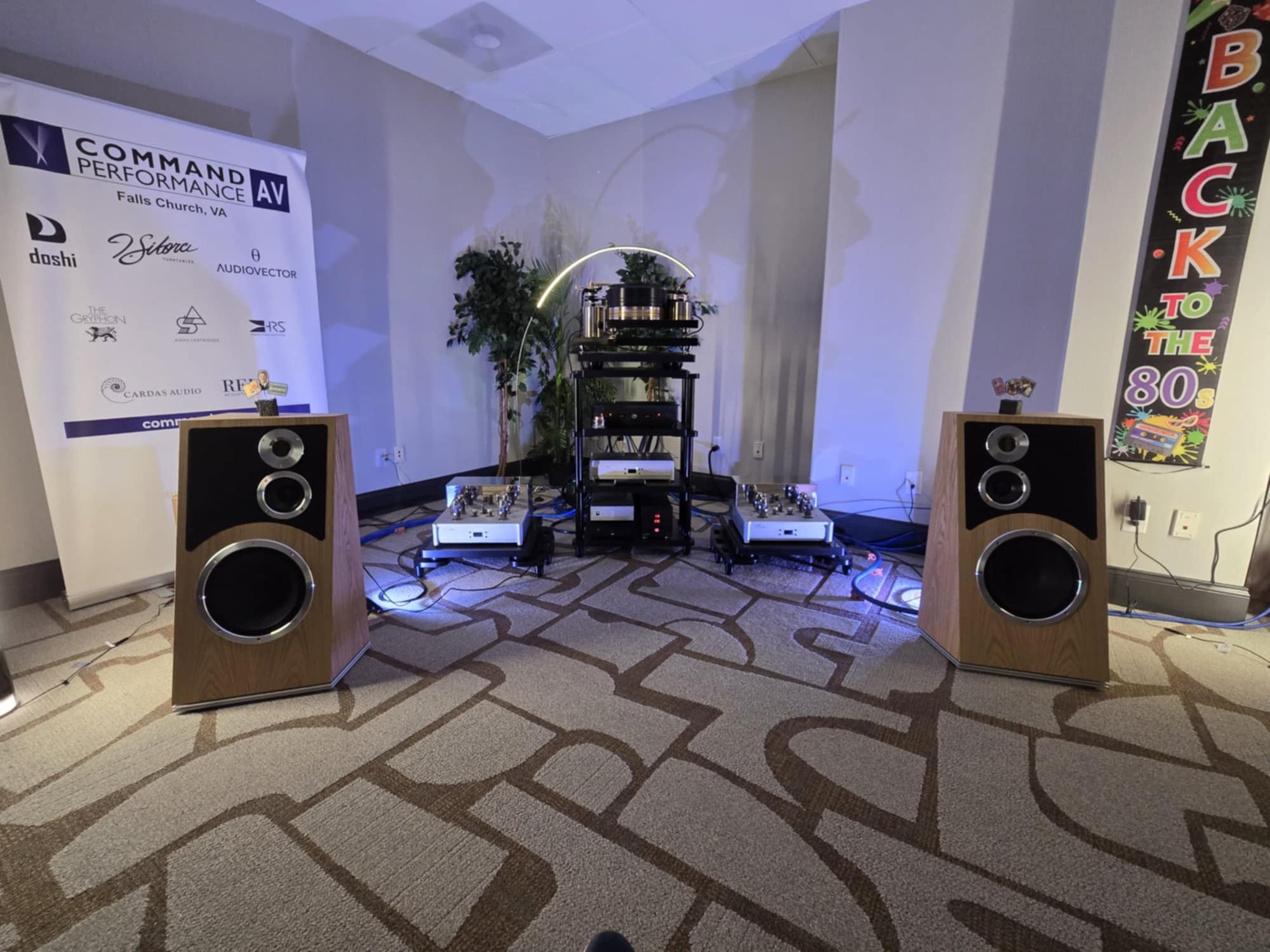 One of the more popular rooms on day one of the show was the room featuring the new Audiovector Trapeze RI floor-standing speakers. The ‘RI’ in Trapeze RI stands for ‘re-imagined,’ as the speakers are the 2024 version of Audiovector’s original speakers from 1979, the Trapeze. They are somewhat larger and more capable than the originals yet retain the retro ‘feel good’ look of those classic speakers.
One of the more popular rooms on day one of the show was the room featuring the new Audiovector Trapeze RI floor-standing speakers. The ‘RI’ in Trapeze RI stands for ‘re-imagined,’ as the speakers are the 2024 version of Audiovector’s original speakers from 1979, the Trapeze. They are somewhat larger and more capable than the originals yet retain the retro ‘feel good’ look of those classic speakers.
None other than Michael (Mr. Vinyl) Fremer was the guest DJ, and he was firing up a lot of retro tunes from the late 70’s and 80’s. Of course, it was all vinyl, all the time, and the Trapeze had no problem filling a small ballroom with excellent sound. Bass was powerful when it was present. For example, Mr. Fremer fired up some classic Billy Idol and Steely Dan, and kick drums from both were felt in the chest. The Trapeze RI seems to have put together a combination of accuracy and fun in a loudspeaker, which is not an easy combination to hit. Secrets of Home Theater and High Fidelity are slated to get in a review pair, so look for a thorough write-up with measurements in early 2025.
Acora Acoustics MRC line of Speakers
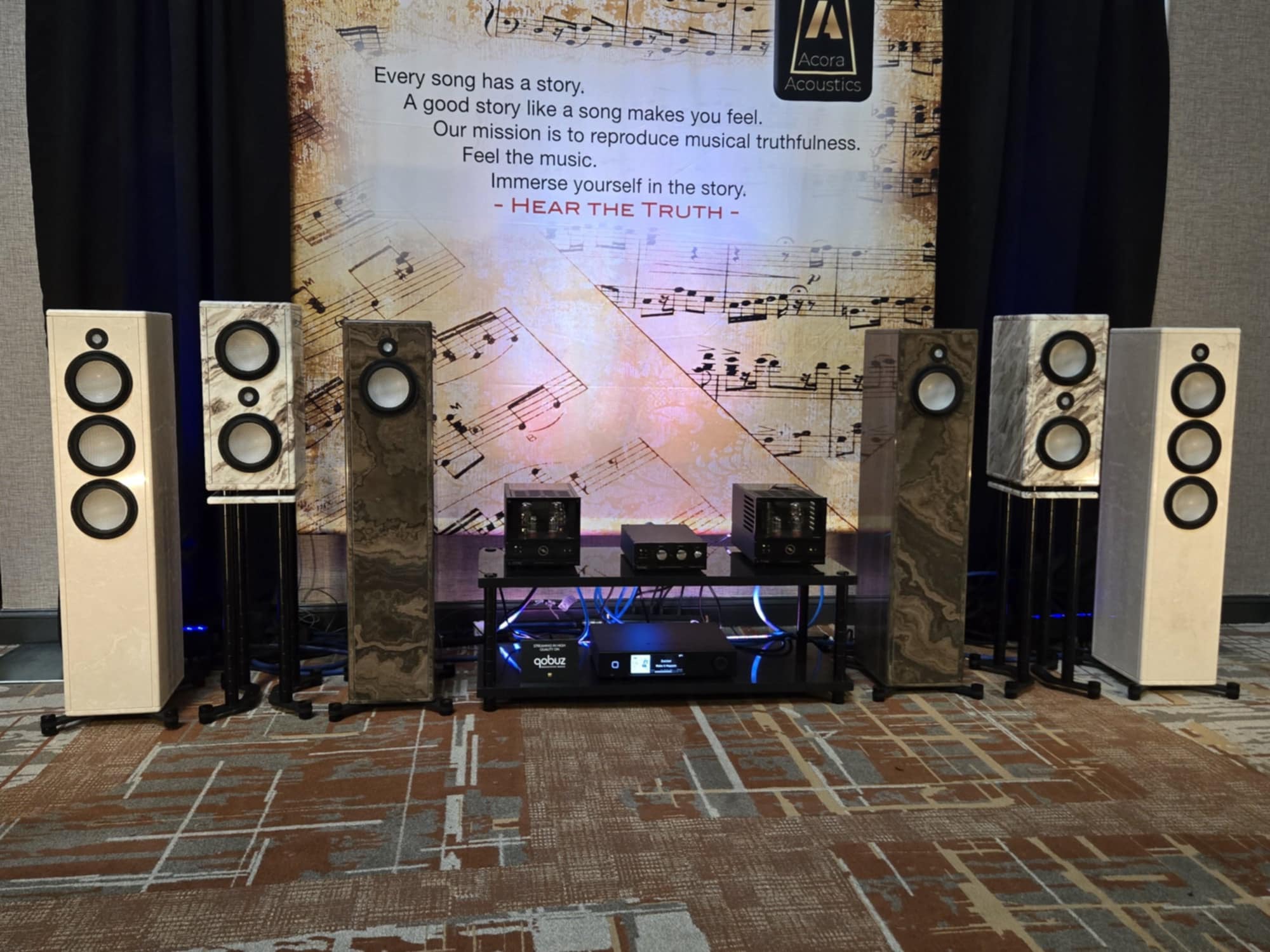 Acora Acoustics (located in Ontario, Canada) introduced their newest line of speakers that are more approachable in price to appeal to a wider audience of music lovers. Compared to their original lines, this new MRC line represents new territory for Acora. The cabinets are a more traditional rectangle shape (while still being quite elegant)
Acora Acoustics (located in Ontario, Canada) introduced their newest line of speakers that are more approachable in price to appeal to a wider audience of music lovers. Compared to their original lines, this new MRC line represents new territory for Acora. The cabinets are a more traditional rectangle shape (while still being quite elegant)
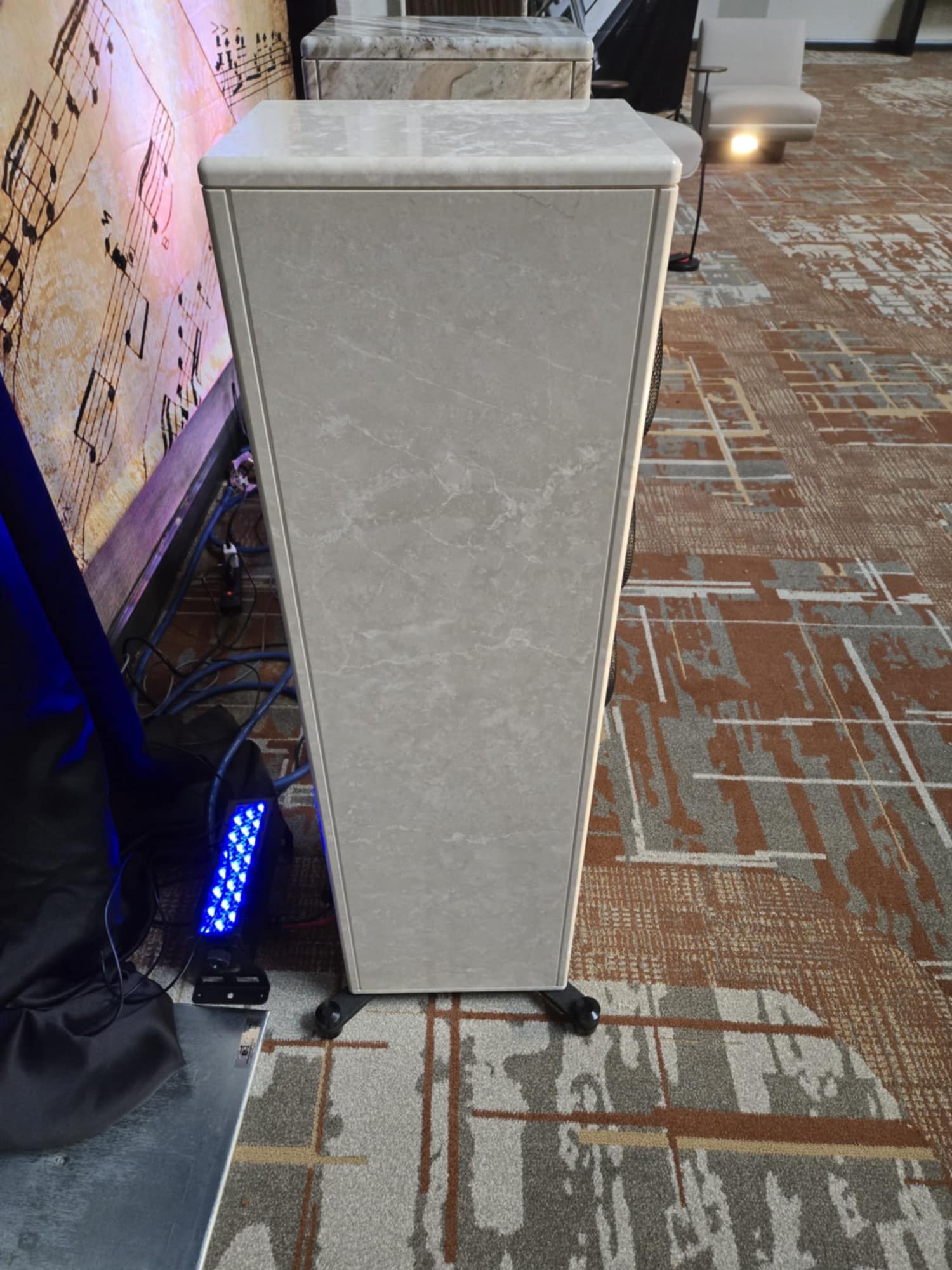 The new speakers use fine marble in the cabinet construction and feature Accuton drivers exclusively. The full line has 5 models: – MRB-1 Stand Mount – ($7990 USD/$9740 CAD Pair) 2 Driver, 2-way design- MRC-1 Floor Standing – ($9990 USD/$12990 CAD Pair) 2 Driver, 2-way design- MRC- 2 Floor Standing – ($12990 USD/$16990CAD Pair) 3 Driver, 2 1/2-way design- MRC-3 Floor Standing – ($15990 USD/ $19990 CAD Pair) 4 Driver, 2 1/2-way design- MRM-1 Monitor – ($5490 USD/$7140 CAD Each) 3 Driver, 2-way design.
The new speakers use fine marble in the cabinet construction and feature Accuton drivers exclusively. The full line has 5 models: – MRB-1 Stand Mount – ($7990 USD/$9740 CAD Pair) 2 Driver, 2-way design- MRC-1 Floor Standing – ($9990 USD/$12990 CAD Pair) 2 Driver, 2-way design- MRC- 2 Floor Standing – ($12990 USD/$16990CAD Pair) 3 Driver, 2 1/2-way design- MRC-3 Floor Standing – ($15990 USD/ $19990 CAD Pair) 4 Driver, 2 1/2-way design- MRM-1 Monitor – ($5490 USD/$7140 CAD Each) 3 Driver, 2-way design.
In listening tests in a MASSIVE lobby area of the Rockville Hilton, these modest-sized towers managed to deliver an excellent sound stage and bass that was incredibly well done in such a large room. Acora seems to have hit a sweet spot for a relatively affordable, high-end speaker line.
Secrets of Home Theater and High Fidelity is looking to get a pair in for review when they are introduced for sale in early 2025.
SVS
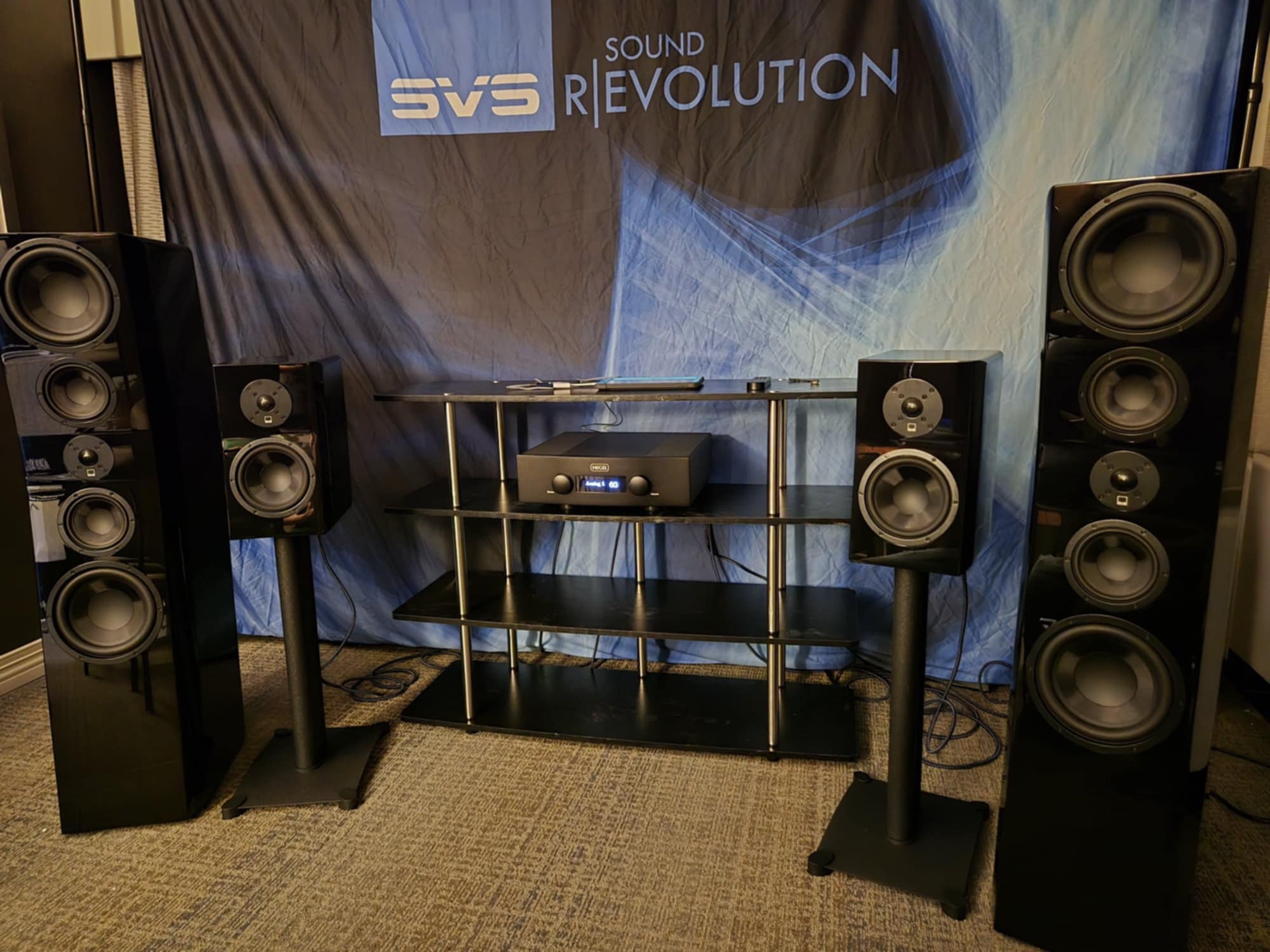 SVS was doing two separate demos in their suite. The first was a 2.1 system featuring the new Ultra Evolution Bookshelf speaker ($1200 per pair) matched to the even newer SB-17 Ultra R/Evolution subwoofer. The second demo system featured a pair of SVS Ultra Evolution Pinnacle towers. Both systems were being driven by a simple Hegel integrated amplifier with built-in streamer.
SVS was doing two separate demos in their suite. The first was a 2.1 system featuring the new Ultra Evolution Bookshelf speaker ($1200 per pair) matched to the even newer SB-17 Ultra R/Evolution subwoofer. The second demo system featured a pair of SVS Ultra Evolution Pinnacle towers. Both systems were being driven by a simple Hegel integrated amplifier with built-in streamer.
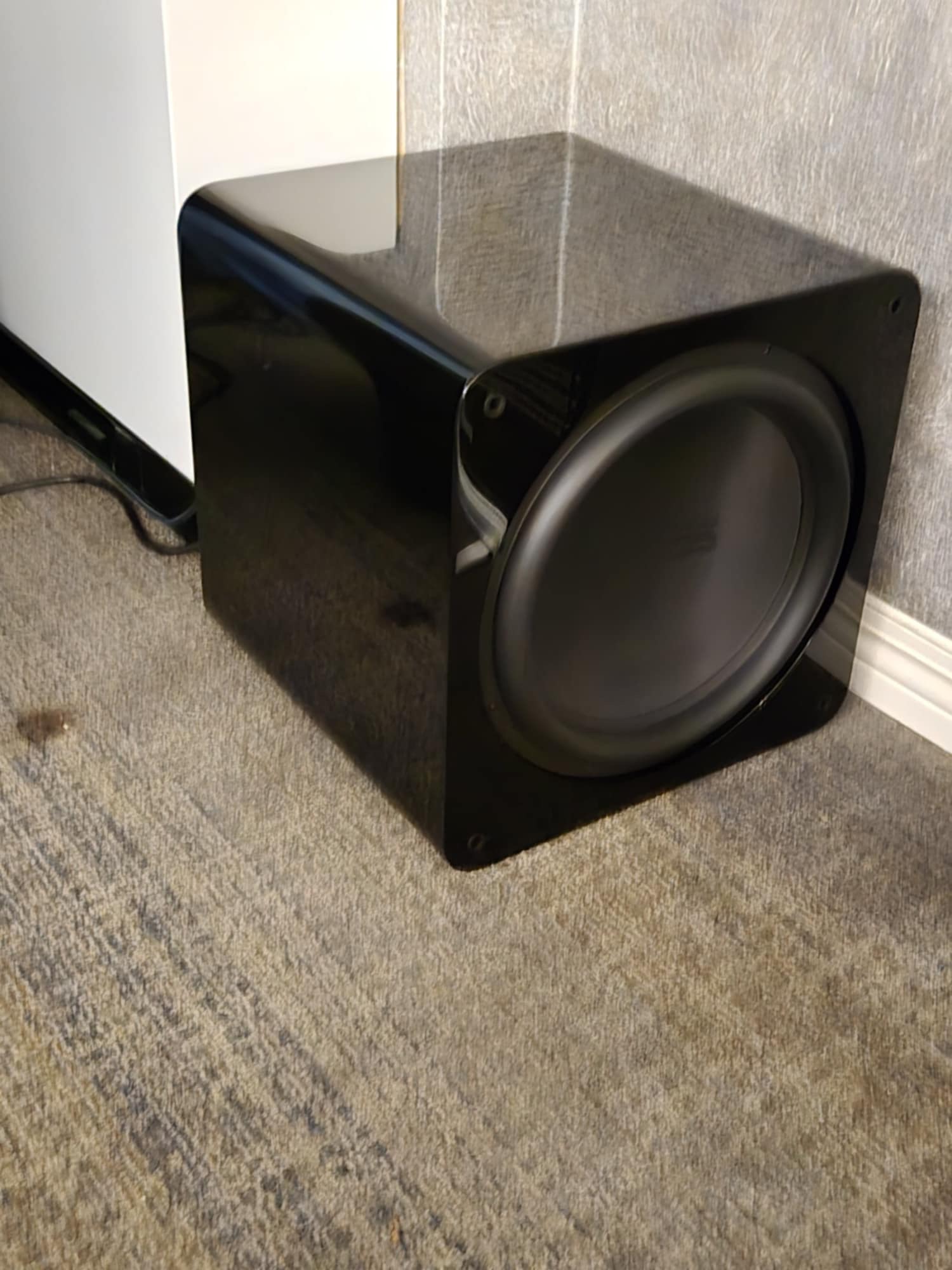 The Bookshelf Evolution features a 6.5-inch woofer and a 1-inch dome tweeter. The SB17 Ultra subwoofer sports a 17-inch driver in a sealed cabinet. The subwoofer notably offers a 17-inch SVS-proprietary driver with dual voice coil design, a first-ever dual-mono subwoofer amplifier, and the extreme processing power of a 295MHz Analog Devices DSP. The 2800-watt amplifier system combines with a 55 lbs four-piece toroidal ferrite electromagnetic motor in the driver to offer up a response to below 15 Hz.
The Bookshelf Evolution features a 6.5-inch woofer and a 1-inch dome tweeter. The SB17 Ultra subwoofer sports a 17-inch driver in a sealed cabinet. The subwoofer notably offers a 17-inch SVS-proprietary driver with dual voice coil design, a first-ever dual-mono subwoofer amplifier, and the extreme processing power of a 295MHz Analog Devices DSP. The 2800-watt amplifier system combines with a 55 lbs four-piece toroidal ferrite electromagnetic motor in the driver to offer up a response to below 15 Hz.
The combination of the Bookshelf Evolution speakers and SB17 Ultra subwoofer retails for $3700. The sound quality was first-rate, with the favorite cut played having to be Steely Dan’s ‘Black Cow’ from the 1977 ‘Aja’ album. The smack in the chest from the bass line in ‘Black Cow’ felt like it was coming from a cost-no-object system.
Then we switched to the Ultra Evolution Pinnacle Towers. The ‘slanted cabinet’ is designed to place the acoustic center of all 5 drivers on the front of the cabinet on the same plane. For $5000 per pair, we are treated to FOUR 8-inch bass drivers, with two on the rear of the cabinet, which aids in keeping resonance to a minimum with what is known as opposing forces. There are also dual 5.25-inch midranges flanking an aluminum dome tweeter. While the towers won’t dig ‘quite’ as deep as the above-mentioned SB17 Ultra subwoofer, above 25 Hz, the total of eight of the 8-inch woofers delivered powerful dynamics.
The entire concept of a $10,000 system – a pair of the towers plus a pair of the subs – that would compete with a lot of cost-no-object systems – was quite the topic of conversation with Gary Yacoubian, the CEO of SV Sound. He is quite rightly proud of his products, and based on today’s demo, with good reason.
Alta Audio Aphrodite
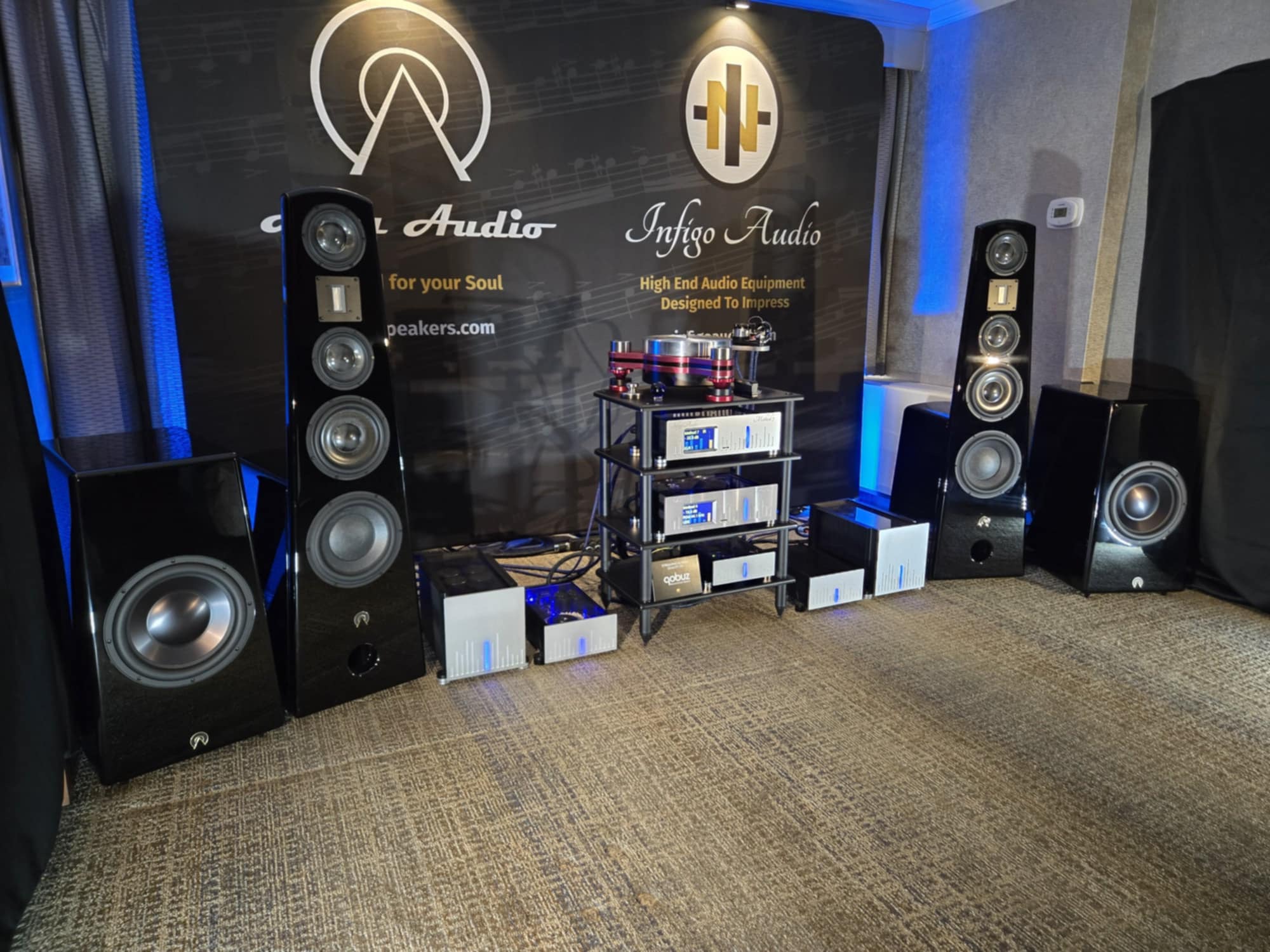 Alta Audio was showing off their mighty Aphrodite towers ($50,000 per pair) with new matching subwoofers that feature 12-inch drivers in a rather large, sealed enclosure. Alta states this subwoofer will enhance any of their models, with a price to be determined in early 2025.
Alta Audio was showing off their mighty Aphrodite towers ($50,000 per pair) with new matching subwoofers that feature 12-inch drivers in a rather large, sealed enclosure. Alta states this subwoofer will enhance any of their models, with a price to be determined in early 2025.
Driven by a pair of $55,000 Infigo Method 3 mono-block amplifiers and a $20,000 Infigo Method 7 pre-amp, this no-holds-barred system proved to be squarely into the ultra-high-end territory. A variety of classical and jazz music (think unamplified and wonderful) filled the room with concert levels without a hint of harshness. It was the type of performance that leads one to wonder how well this system would be in a proper, dedicated listening room.
The piano gloss finish was also flawless, and Alta/Infigo delivered the type of sound that offers a lot of hope for the music lover at a price that is actually quite reasonable in today’s high-end scene.
Linkwitz LX521.4MG Dipole Speaker
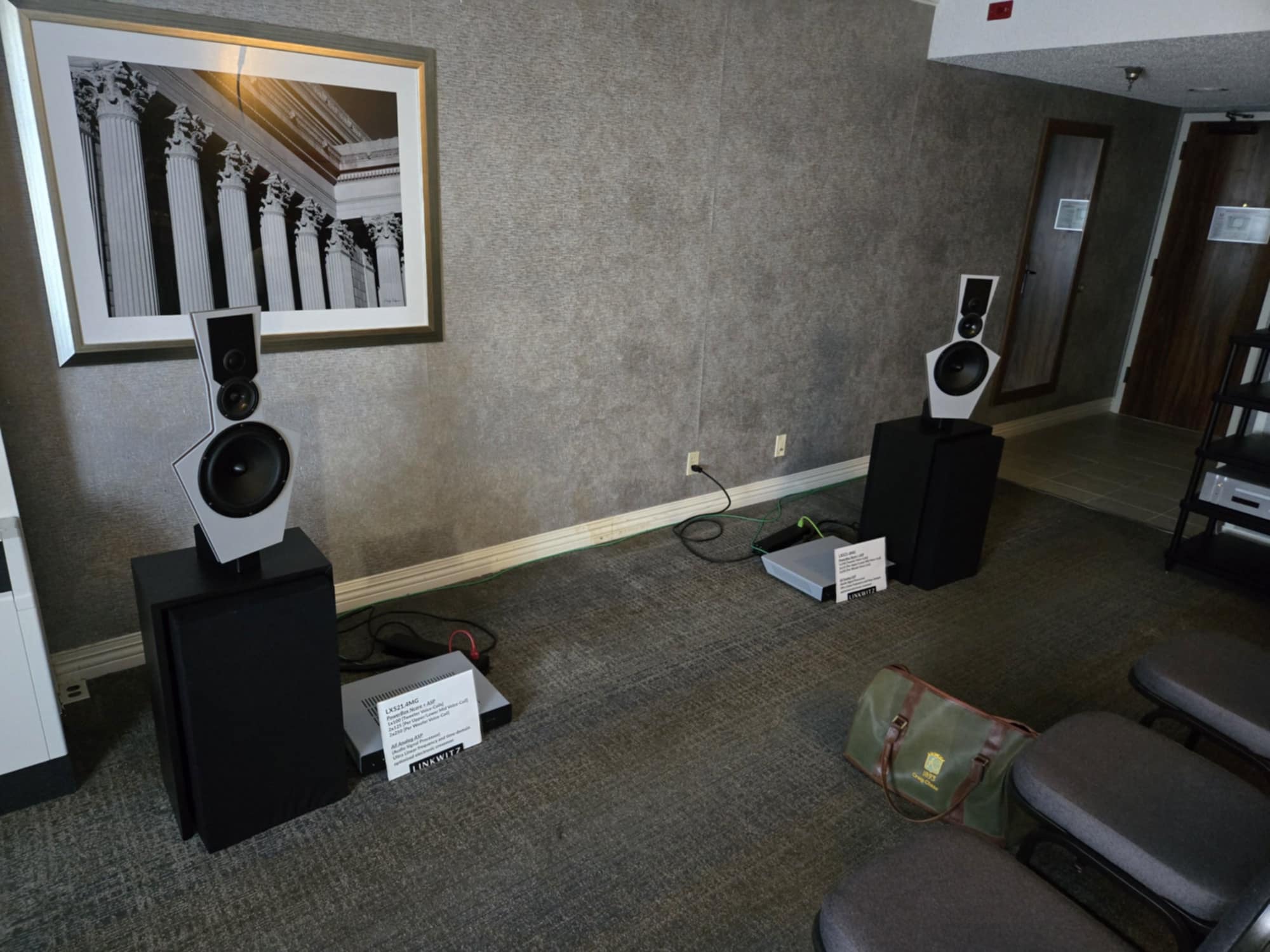 This unique ‘quasi-active’ loudspeaker offers a lot for the $26,000 asking price. Included is a pair of boxes that contain a 100-watt amp for the tweeter, two 125-watt amps for the upper and lower midrange, and two 250-watt amps for each of the woofers.
This unique ‘quasi-active’ loudspeaker offers a lot for the $26,000 asking price. Included is a pair of boxes that contain a 100-watt amp for the tweeter, two 125-watt amps for the upper and lower midrange, and two 250-watt amps for each of the woofers.
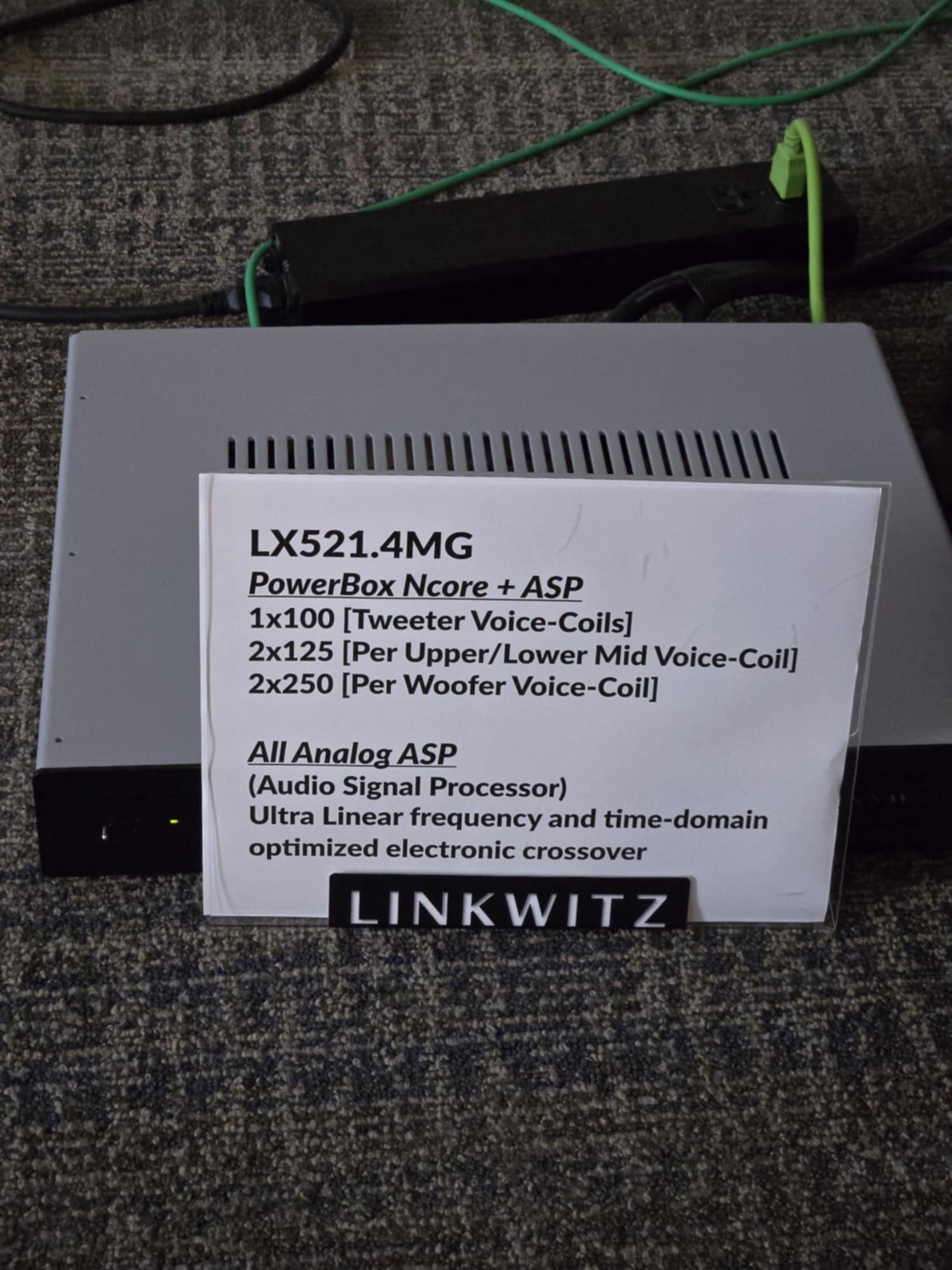 For demo purposes, a simple CD player was connected to the amp/dsp/crossover boxes which then fed the speakers. The bass was quite deep and exceptionally tight. The soundstage was huge! Our own Editor-in-Chief, Carlo Lo Raso, did a complete review of these speakers earlier this year, and it was easy to ascertain why he liked them so much. The look is definitely in the ‘form follows function’ camp, and the sound quality is first-rate. Even in a tough room, they delivered the goods with aplomb.
For demo purposes, a simple CD player was connected to the amp/dsp/crossover boxes which then fed the speakers. The bass was quite deep and exceptionally tight. The soundstage was huge! Our own Editor-in-Chief, Carlo Lo Raso, did a complete review of these speakers earlier this year, and it was easy to ascertain why he liked them so much. The look is definitely in the ‘form follows function’ camp, and the sound quality is first-rate. Even in a tough room, they delivered the goods with aplomb.
Lone Mountain Audio / ATC Speakers
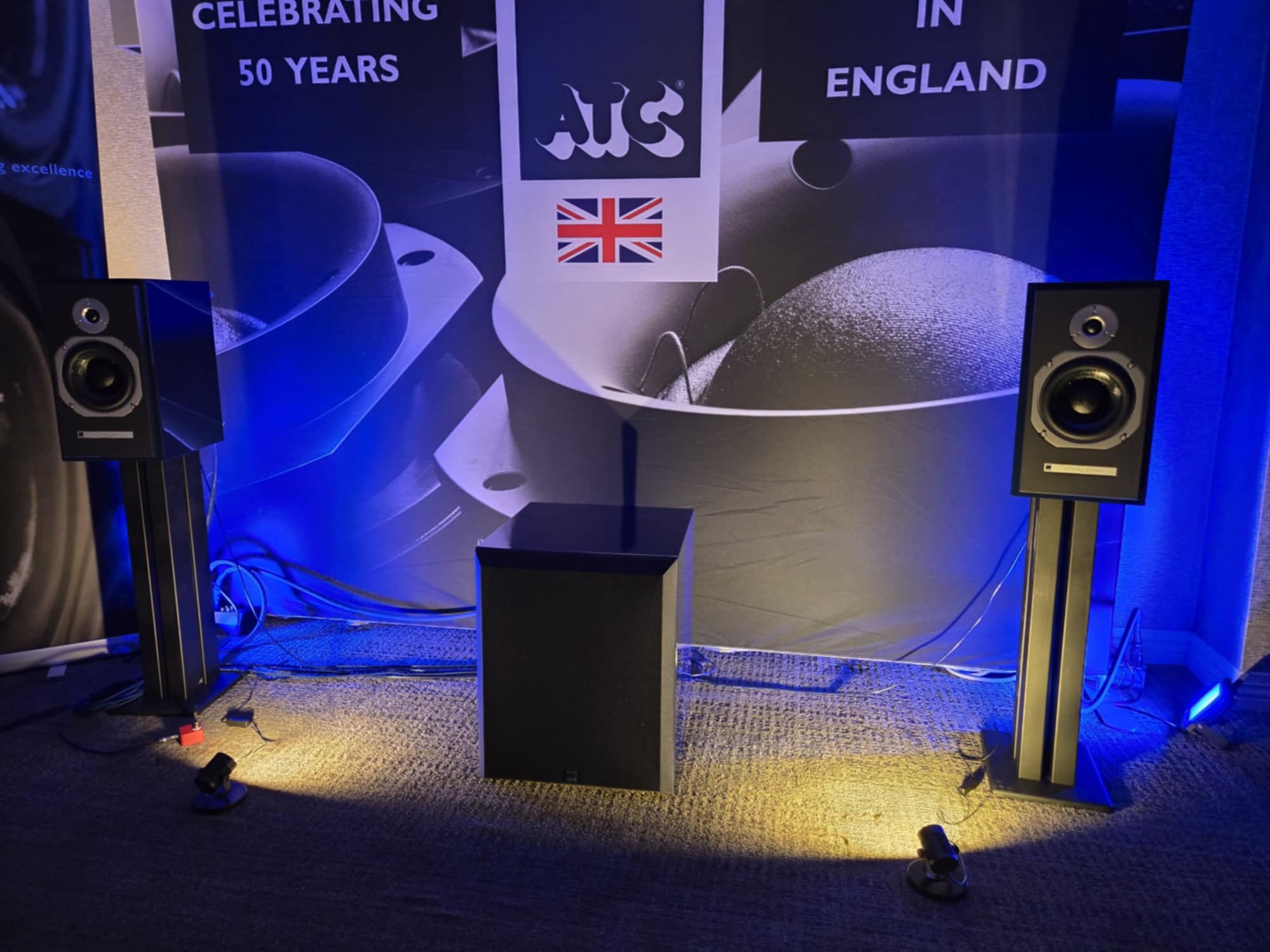 Lone Mountain was showing off the ATC SCM20ASL active monitors ($13,999 per pair) and the C4 Mk2 subwoofer ($9999), making for a full range, fully active $23,998 system. Both are limited edition products, with the monitors having 150 pairs built and the subwoofer @ a mere 20 units.
Lone Mountain was showing off the ATC SCM20ASL active monitors ($13,999 per pair) and the C4 Mk2 subwoofer ($9999), making for a full range, fully active $23,998 system. Both are limited edition products, with the monitors having 150 pairs built and the subwoofer @ a mere 20 units.
The system itself could play at borderline extreme volume levels with no audible stress. Of more importance was how coherent this system was at normal levels. On a variety of rock, jazz, and classical, the ATC 2.1 system never flinched. The soundstage was of high-end DNA, and the tonal quality was neutral. They seemed to be (with the usual caveat we were in a hotel suite) a speaker system that would thrill in a proper room.
VPI turntable/The Gryphon/Stenheim Loudspeaker
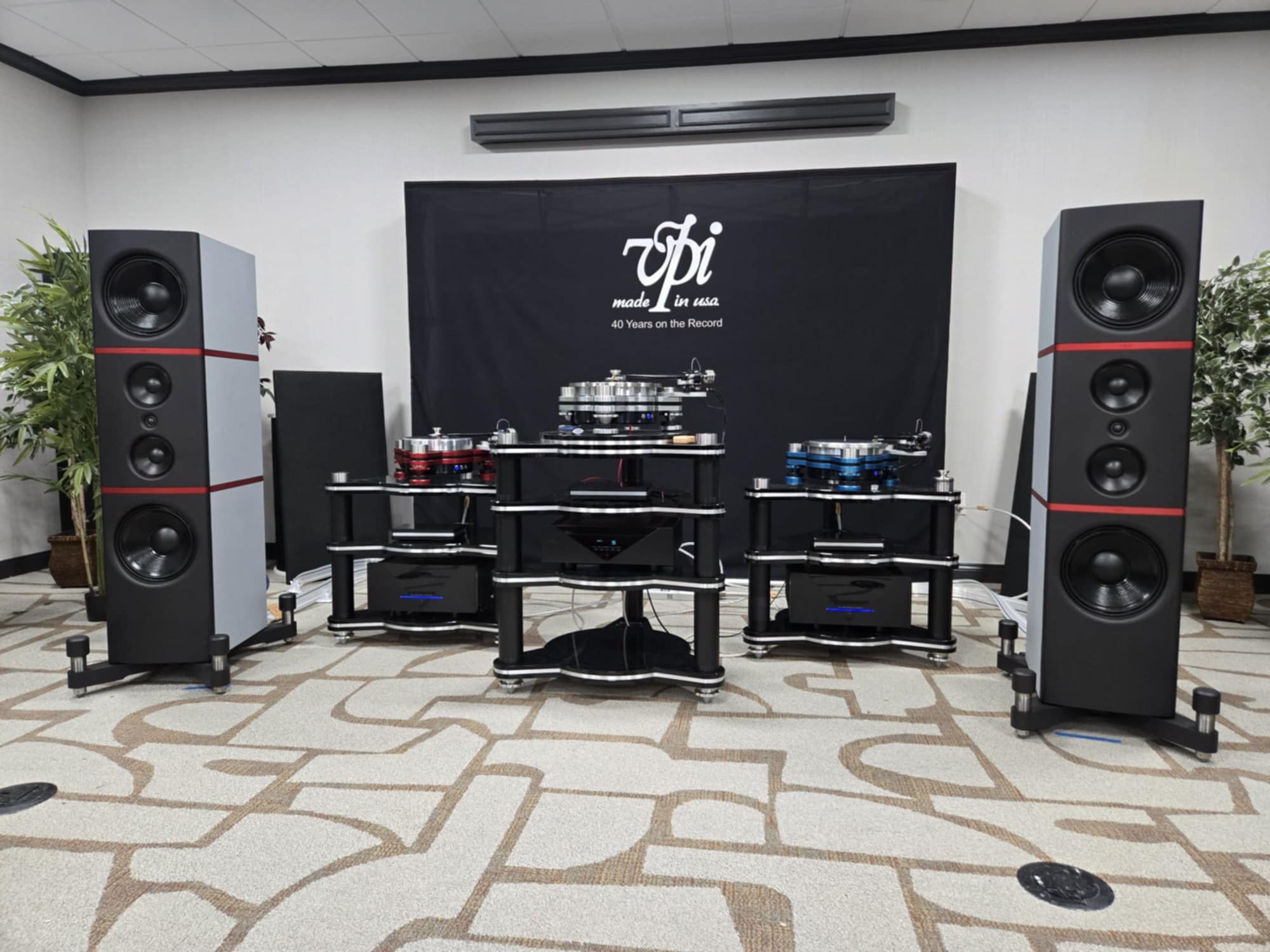 The last system for today was also the most expensive. We had the $80,000 Vanquish Turntable from VPI driving the $70,000 Gryphon Essence pre-amp/mono block power amp which in turn drove the $235,000 per pair Stenheim Reference Ultime Three tower speakers.
The last system for today was also the most expensive. We had the $80,000 Vanquish Turntable from VPI driving the $70,000 Gryphon Essence pre-amp/mono block power amp which in turn drove the $235,000 per pair Stenheim Reference Ultime Three tower speakers.
The listening room was a pretty large hotel ballroom, and even in this, the speakers from Stenheim somehow managed to shake the room with incredible, detailed bass. VPI Industries Mat Weisfeld was in rare form, holding his precious daughter while being the lively host and emcee. For almost an hour, it was a lot of fun to hang with Anthony Chiarella (The Gryphon’s US rep) while his company’s amps took all the music from Mat’s turntable and made the ballroom into a proper studio, delivering Class A watts into the huge Stenheims.
All too often, extreme systems lack fun, but this isn’t the case today. Mat and Harry were taking turns with jazz, rock, and classical tracks. The sound was so good in this impossible room that no one even paid attention to the band playing, but instead, everyone just grooved to the tunes. Having attended quite a few audio shows, I don’t remember one in which people in back were dancing. This was a special system. It was also a fine end to a better-than-expected day.
Day Two: Saturday
Altec-Lansing plans a comeback
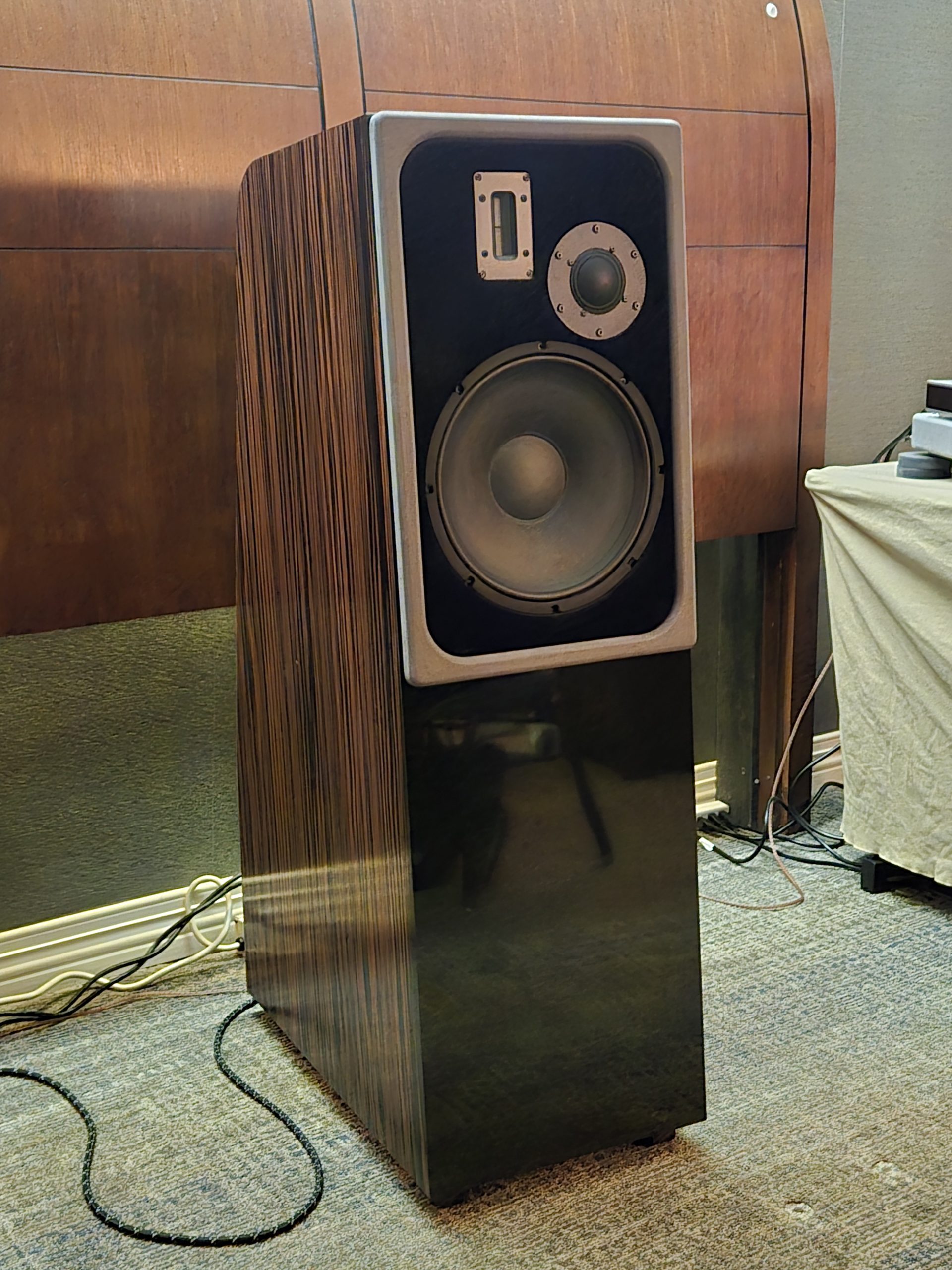 Altec- Lansing was one of the premier loudspeaker companies for both pro audio and home audio for decades. In the world of audio, they have been the source of a serious case of ‘missing you,’ as they are now primarily an importer of Bluetooth speakers with the Altec name on them. This is about to change in 2025!
Altec- Lansing was one of the premier loudspeaker companies for both pro audio and home audio for decades. In the world of audio, they have been the source of a serious case of ‘missing you,’ as they are now primarily an importer of Bluetooth speakers with the Altec name on them. This is about to change in 2025!
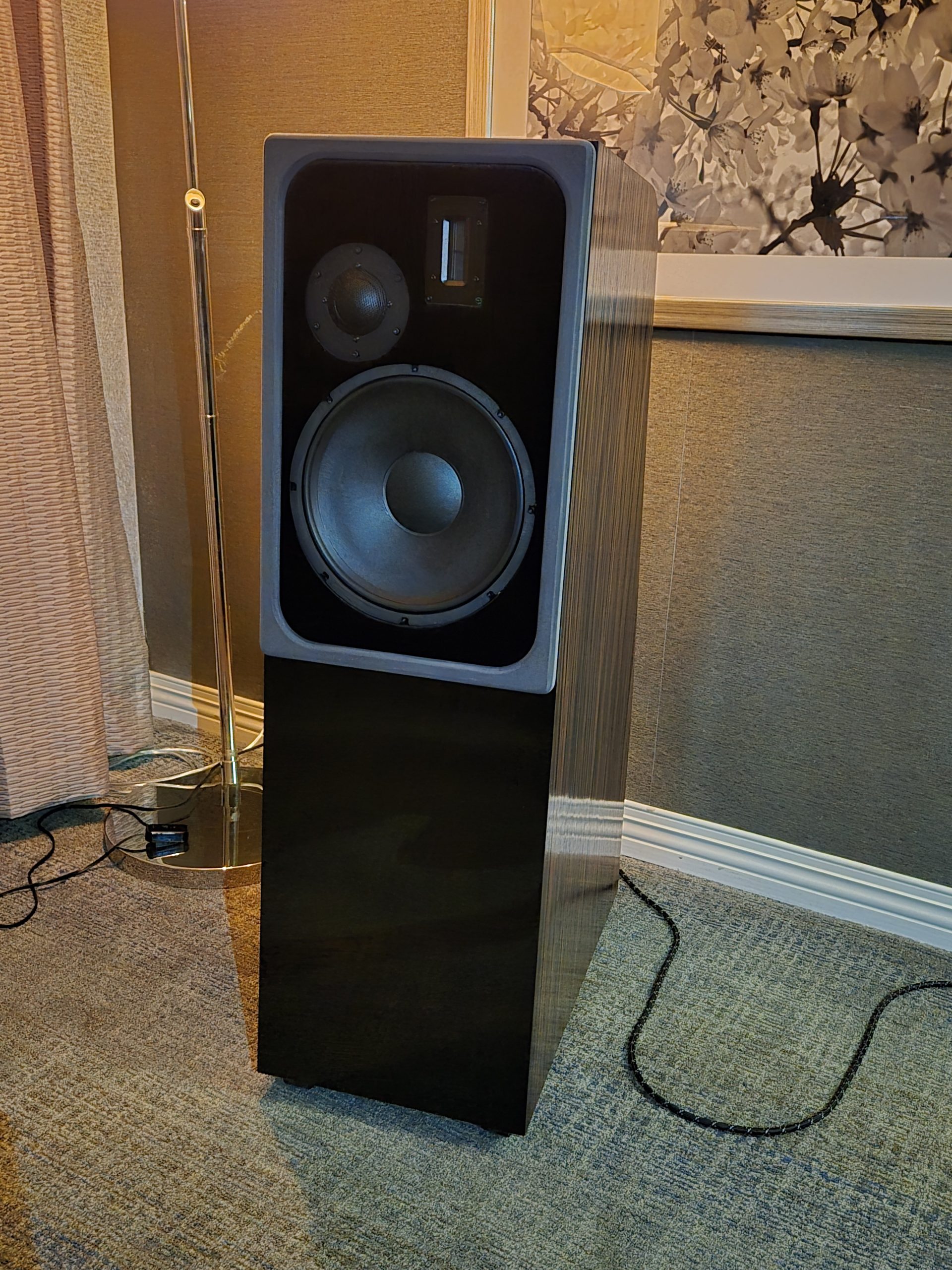 Altec-Lansing brought a ‘production quality’ pair of demonstration speakers to CapFest, and I got to audition this pair this morning. The speakers consist of a 12-inch pro-audio style woofer in a very large cabinet that is tuned to about 28 Hz. Midrange duties are handled by a stout 2-inch dome driver which then hands off to an Air Motion tweeter above 5000 Hz. The company also plans on introducing a mono-block tube amplifier (32 watts per channel) to drive these 96 dB (2.83 volts/one meter) towers, and this amplifier was used in the demo room.
Altec-Lansing brought a ‘production quality’ pair of demonstration speakers to CapFest, and I got to audition this pair this morning. The speakers consist of a 12-inch pro-audio style woofer in a very large cabinet that is tuned to about 28 Hz. Midrange duties are handled by a stout 2-inch dome driver which then hands off to an Air Motion tweeter above 5000 Hz. The company also plans on introducing a mono-block tube amplifier (32 watts per channel) to drive these 96 dB (2.83 volts/one meter) towers, and this amplifier was used in the demo room.
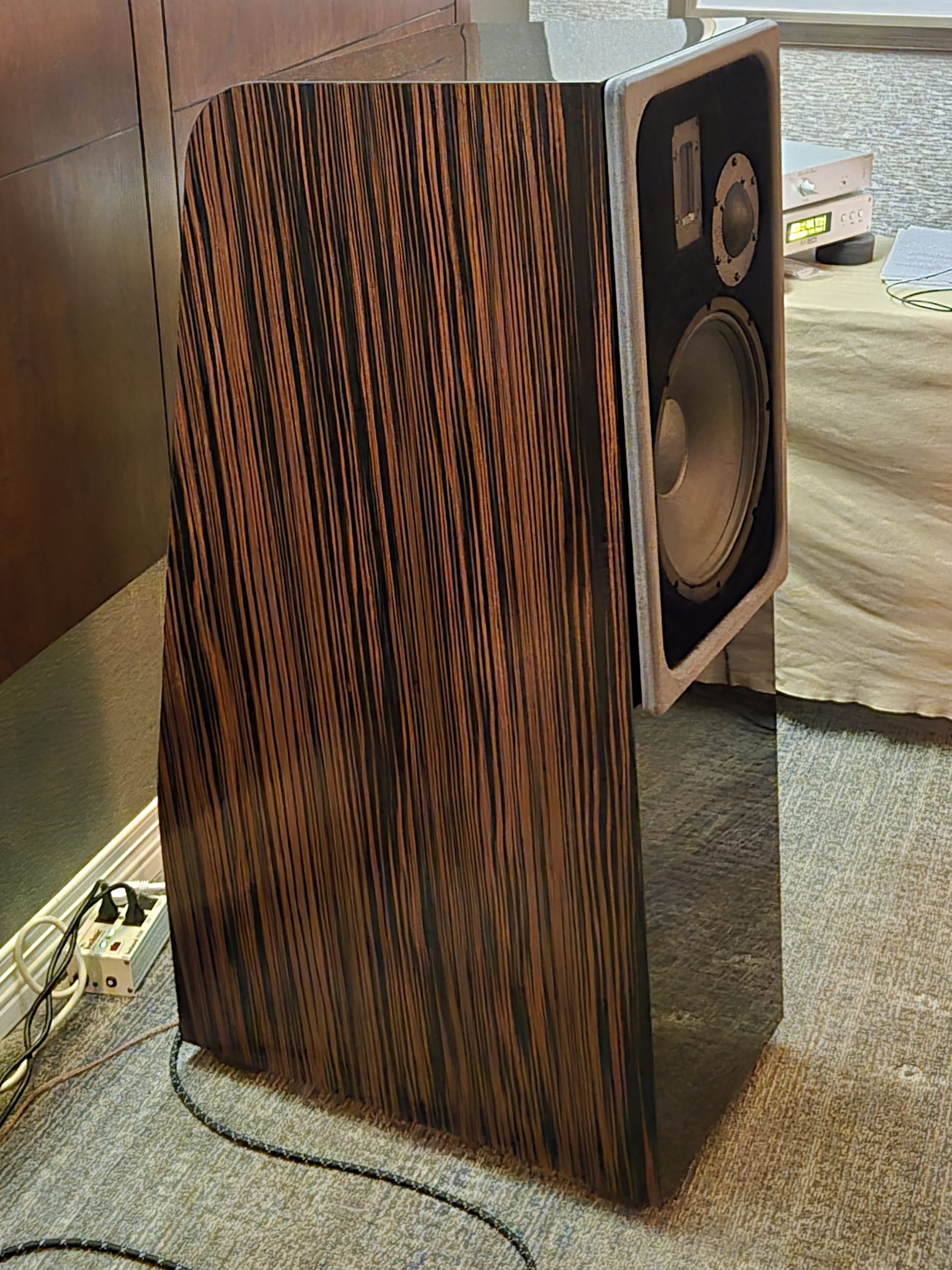
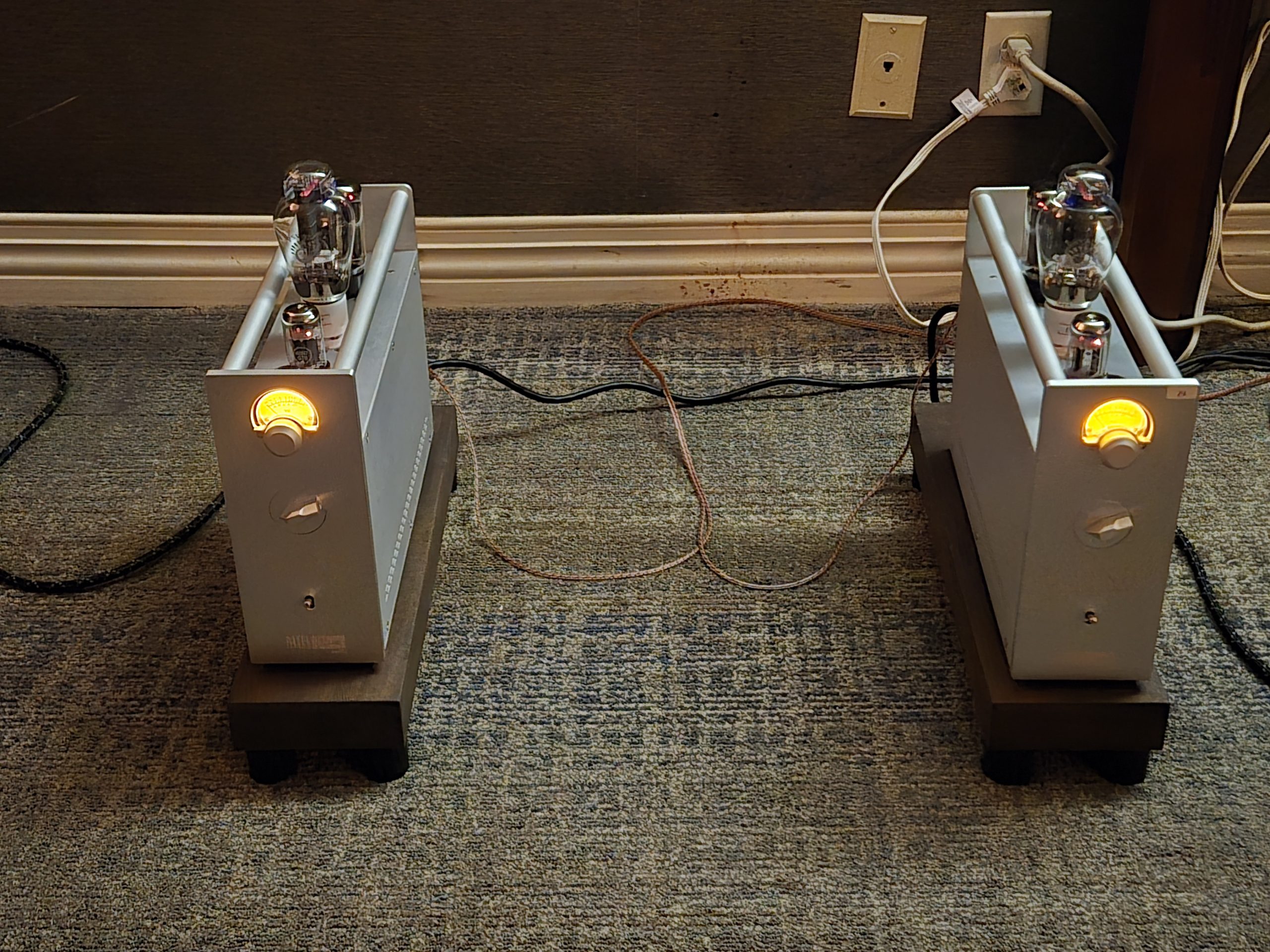 The speakers are huge – almost 4 feet tall, about 18 inches wide, and 3 feet deep – which is what allows such a deep tuning point. The sound quality in a less-than-great room was excellent, with deep bass (as designer James Harvell stated, no subwoofer needed) combined with effortless dynamics. Considering both speakers AND amplifiers will come in for under $18,000 complete, this new Altec system shows a lot of promise. Look for a review of a production pair in early 2025.
The speakers are huge – almost 4 feet tall, about 18 inches wide, and 3 feet deep – which is what allows such a deep tuning point. The sound quality in a less-than-great room was excellent, with deep bass (as designer James Harvell stated, no subwoofer needed) combined with effortless dynamics. Considering both speakers AND amplifiers will come in for under $18,000 complete, this new Altec system shows a lot of promise. Look for a review of a production pair in early 2025.
House of Stereo/FOCAL/T+A
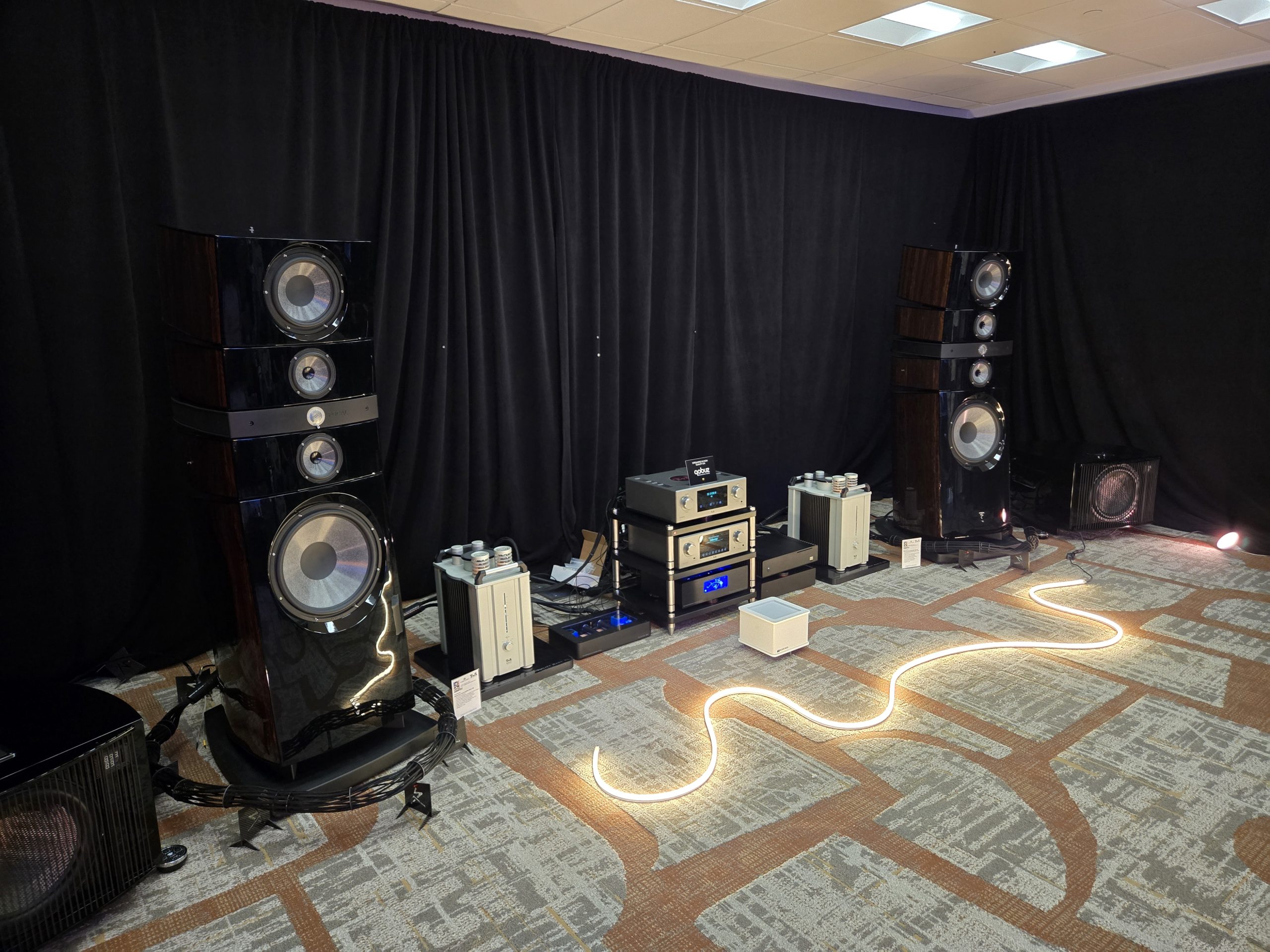 Dealer House of Stereo set up a very impressive room for CapFest this year. They set up a pair of FOCAL’s flagship Grand Utopia loudspeakers ($280,000 per pair) being driven by massive T+A M40 HV mono-block amplifiers, a P3100 HV preamp, and an SD3100 Reference DAC. Standing almost 7 feet tall, the Grand Utopias features a 16-inch ‘W’ woofer, 11-inch ‘W’ midbass, and a pair of 6.5-inch ‘W’ midrange drivers that flank a 1-inch Beryllium inverted dome tweeter. Each speaker weighs 584 pounds and is a serious challenger to the title of best speaker available, regardless of the price. As if they needed bass augmentation, HoS brought along a pair of REL No. 32 subwoofers ($10K each) to “guild the lily” as it were! All cabling was courtesy of Synergistic Research’s SRX XL cable line.
Dealer House of Stereo set up a very impressive room for CapFest this year. They set up a pair of FOCAL’s flagship Grand Utopia loudspeakers ($280,000 per pair) being driven by massive T+A M40 HV mono-block amplifiers, a P3100 HV preamp, and an SD3100 Reference DAC. Standing almost 7 feet tall, the Grand Utopias features a 16-inch ‘W’ woofer, 11-inch ‘W’ midbass, and a pair of 6.5-inch ‘W’ midrange drivers that flank a 1-inch Beryllium inverted dome tweeter. Each speaker weighs 584 pounds and is a serious challenger to the title of best speaker available, regardless of the price. As if they needed bass augmentation, HoS brought along a pair of REL No. 32 subwoofers ($10K each) to “guild the lily” as it were! All cabling was courtesy of Synergistic Research’s SRX XL cable line.
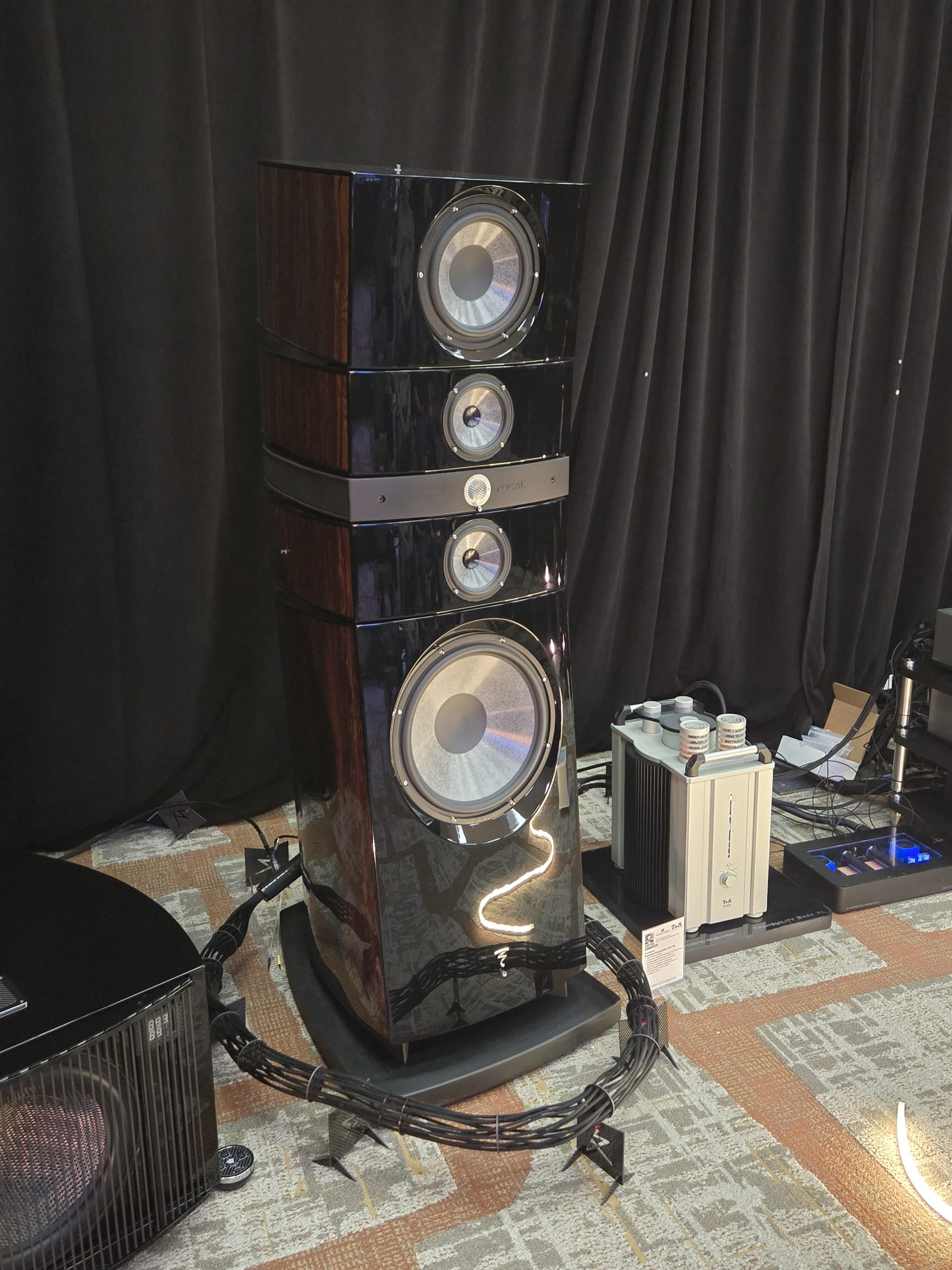 The Grand Utopias did not disappoint at any level. Every track, from full scale orchestra to rock with incredible deep bass tracks, was thrilling the audience with concert level volume and not a hint of the speaker being taxed. There was no feeling that the speakers were even in the room: close your eyes, and you experience a wall of pure audio.
The Grand Utopias did not disappoint at any level. Every track, from full scale orchestra to rock with incredible deep bass tracks, was thrilling the audience with concert level volume and not a hint of the speaker being taxed. There was no feeling that the speakers were even in the room: close your eyes, and you experience a wall of pure audio.
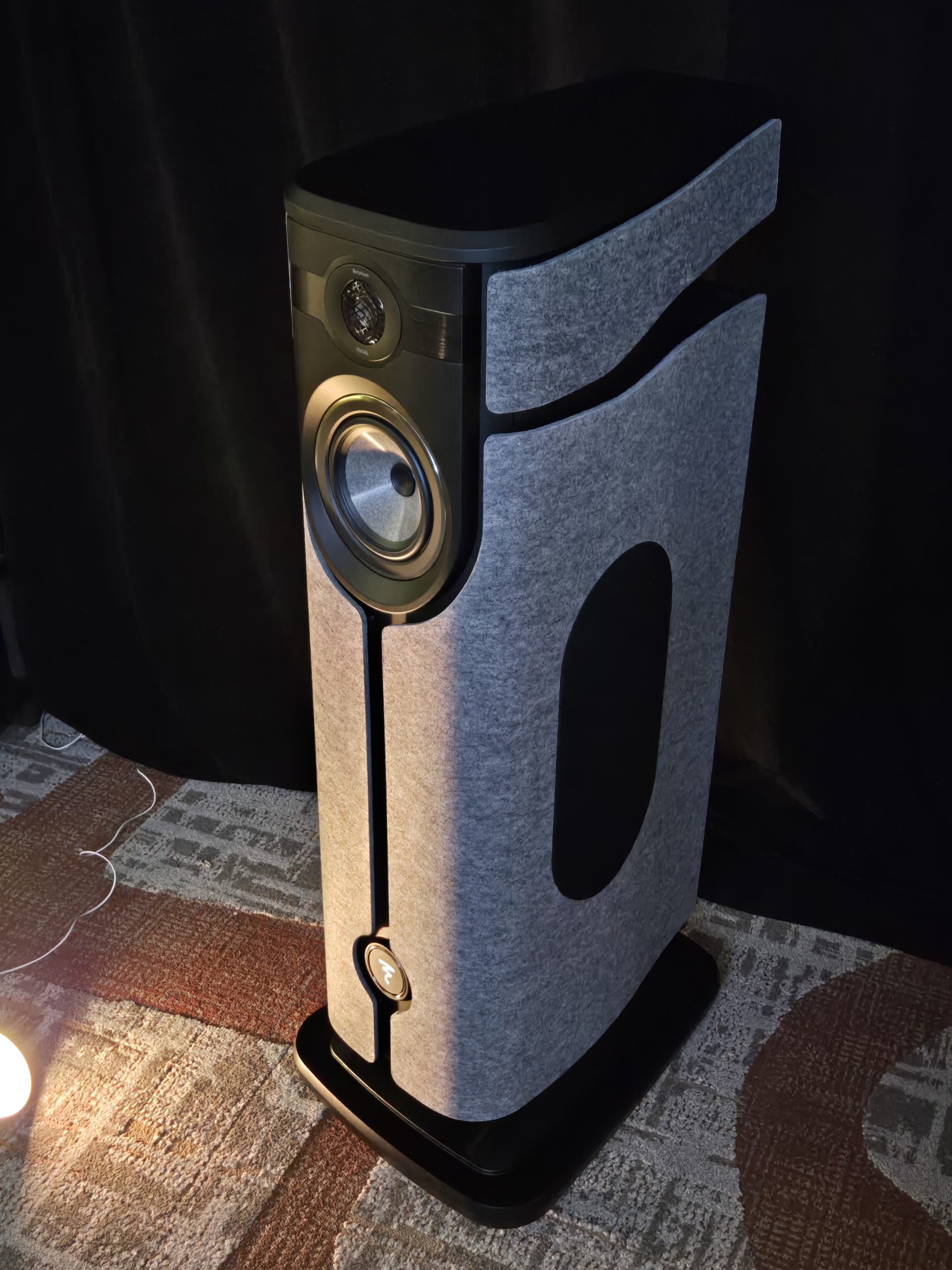 Also present, but not hooked up, were the new Diva Utopia active speakers ($40,000 per pair) which look to offer a lot of high-end value at the asking price. The four 6.5-inch woofers get a dedicated 250-watt class AB amplifier while the 6.5-inch midrange and 1-inch Beryllium inverted dome tweeter each get 75 watts of Class-AB power. Connectivity includes AirPlay 2- Google Cast- UPnP™- Bluetooth® 5.3- Spotify via Spotify Connect- TIDAL via TIDAL Connect- QQ Music via QPlay and there are a variety of digital inputs. Focal packed a lot into these 4-foot tall, 141-pound towers. I will be stopping back on Sunday to see if they are allowing an audition!
Also present, but not hooked up, were the new Diva Utopia active speakers ($40,000 per pair) which look to offer a lot of high-end value at the asking price. The four 6.5-inch woofers get a dedicated 250-watt class AB amplifier while the 6.5-inch midrange and 1-inch Beryllium inverted dome tweeter each get 75 watts of Class-AB power. Connectivity includes AirPlay 2- Google Cast- UPnP™- Bluetooth® 5.3- Spotify via Spotify Connect- TIDAL via TIDAL Connect- QQ Music via QPlay and there are a variety of digital inputs. Focal packed a lot into these 4-foot tall, 141-pound towers. I will be stopping back on Sunday to see if they are allowing an audition!
Geshelli Wants to Meet Your Speakers
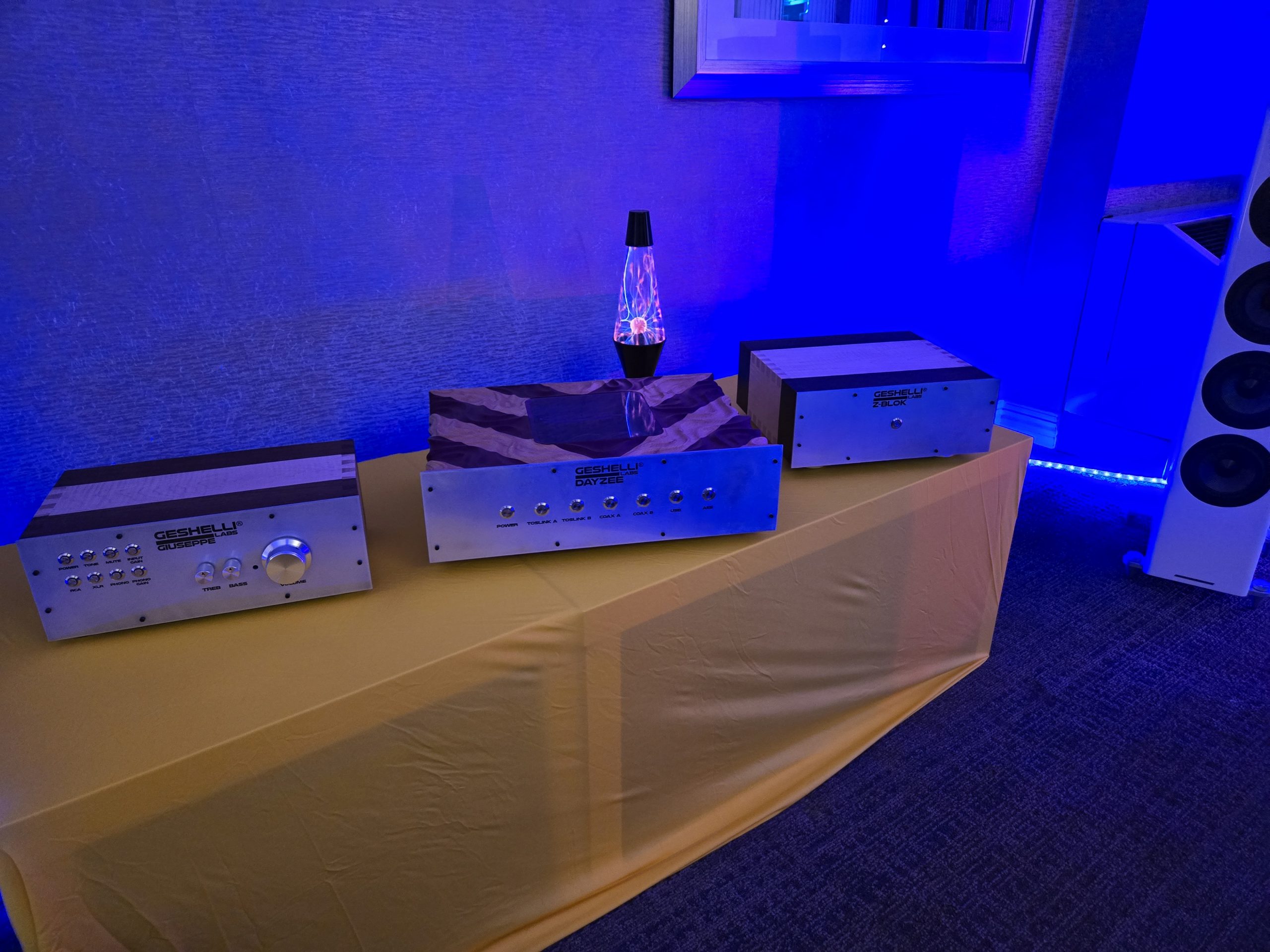 Known across the planet for their excellent headphone amps and DACS, Geshelli was showing off their new mono-block amplifiers with the clever name ‘Z-BLOK’ and the matching “Giuseppe” pre-amplifier. They will both be available with various custom wood finishes along with a soon-to-be-added (and more traditional) metal casing.
Known across the planet for their excellent headphone amps and DACS, Geshelli was showing off their new mono-block amplifiers with the clever name ‘Z-BLOK’ and the matching “Giuseppe” pre-amplifier. They will both be available with various custom wood finishes along with a soon-to-be-added (and more traditional) metal casing.
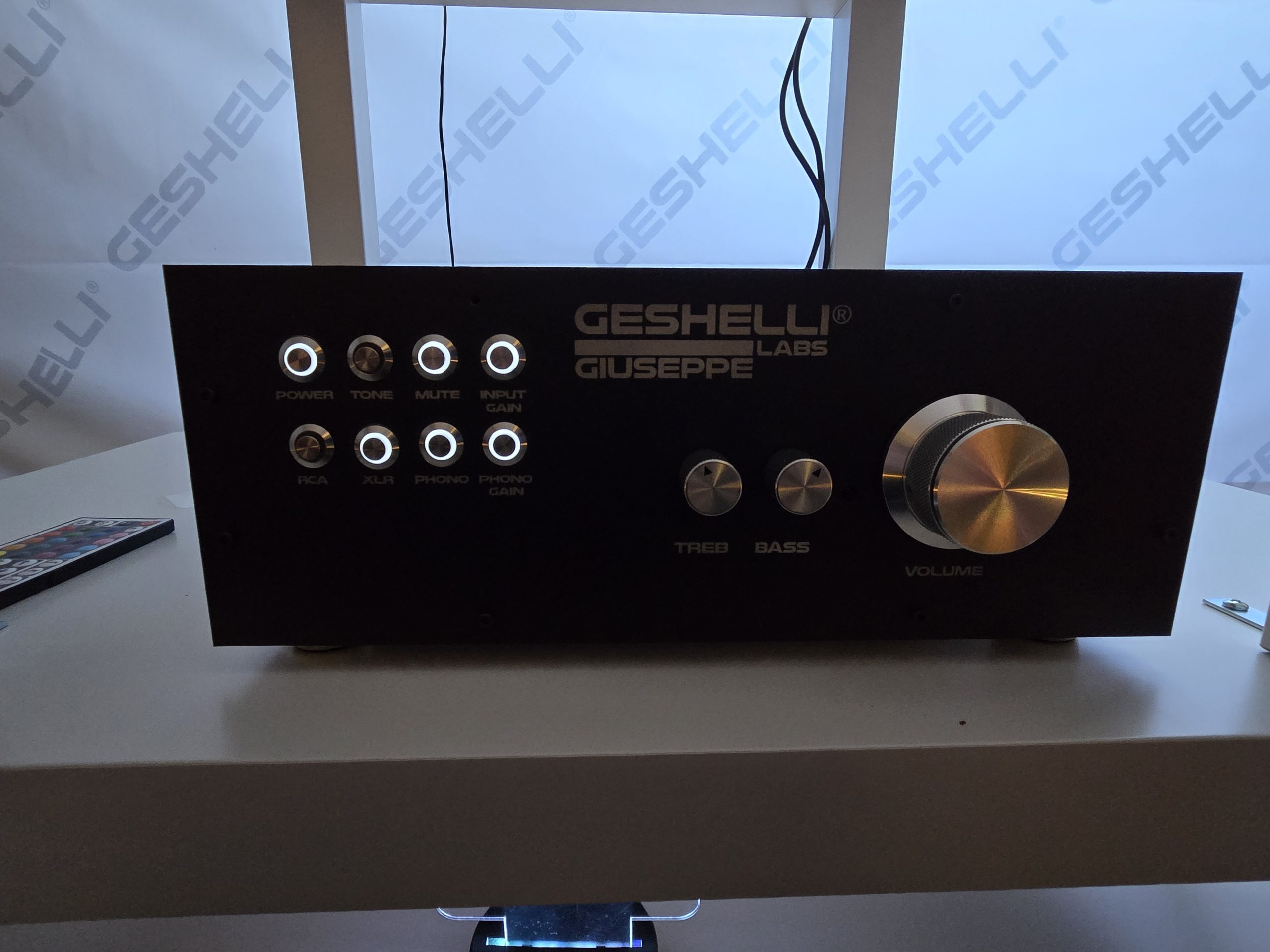 Geshelli is providing no specifications nor pricing at this time, but they did have the Giuseppe/Z-BLOK combination driving a pair of Acoustic Energy AE520 tower speakers. The sound quality was excellent, with a nice soundstage and extended bass for modest-sized and priced towers. The ‘look’ of the trio was of exceptional fit and finish, and with Geshelli’s reputation for value, these may be serious contenders for audiophiles who appreciate something unique.
Geshelli is providing no specifications nor pricing at this time, but they did have the Giuseppe/Z-BLOK combination driving a pair of Acoustic Energy AE520 tower speakers. The sound quality was excellent, with a nice soundstage and extended bass for modest-sized and priced towers. The ‘look’ of the trio was of exceptional fit and finish, and with Geshelli’s reputation for value, these may be serious contenders for audiophiles who appreciate something unique.
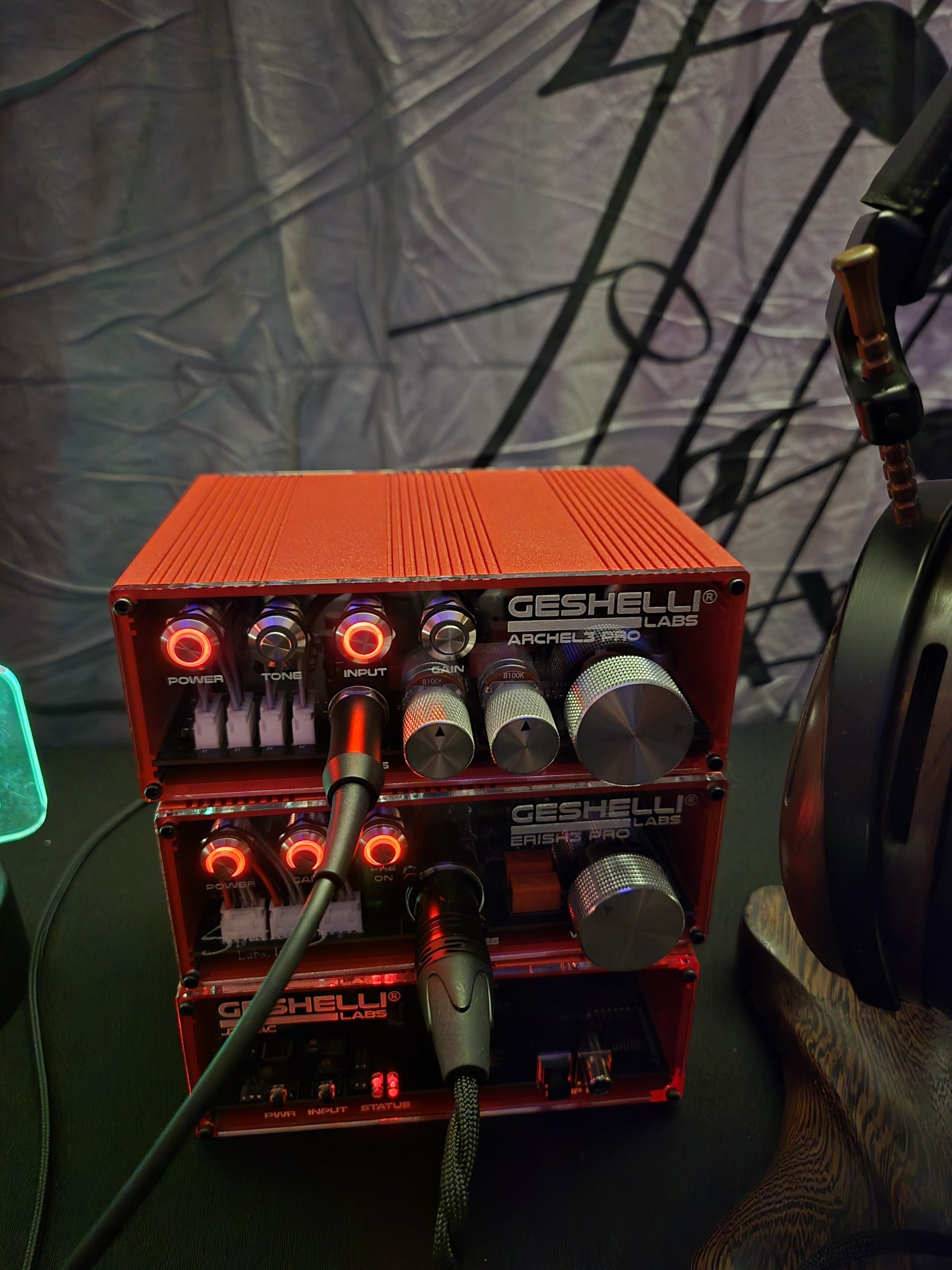 Geshelli also had on hand their new Archel 3 PRO and Erish 3 PRO “socketed” headphone amps which cater to the hobbyist who wants to swap out the stock op-amps for custom versions. Geshelli also has a great relationship with Sparkos’s Labs as they offer some Sparkos discrete op-amp choices when you place an order for a “socketed” head-amp. Look for more on this in the near future, but audio tweakers will have a home with Geshelli!
Geshelli also had on hand their new Archel 3 PRO and Erish 3 PRO “socketed” headphone amps which cater to the hobbyist who wants to swap out the stock op-amps for custom versions. Geshelli also has a great relationship with Sparkos’s Labs as they offer some Sparkos discrete op-amp choices when you place an order for a “socketed” head-amp. Look for more on this in the near future, but audio tweakers will have a home with Geshelli!
YG Acoustics
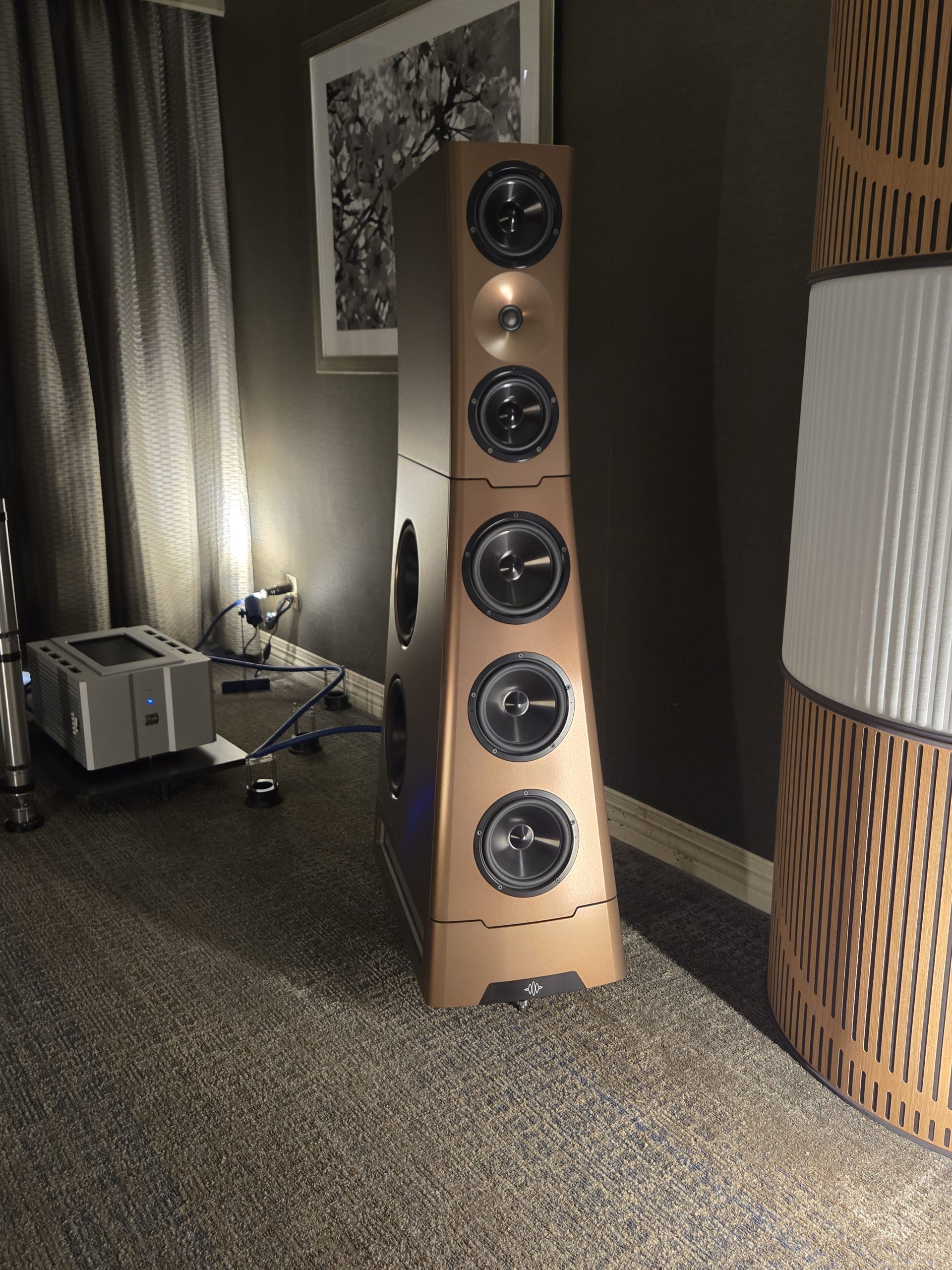 YG Acoustics was working with a local dealer in multiple rooms, which made having a conversation a bit on the difficult side. Their staff was BUSY! I did manage to spend some quality time with both the XX towers ($235,000) and the Vantage 3 ($41,700) in a green finish that definitely catches one’s eye!
YG Acoustics was working with a local dealer in multiple rooms, which made having a conversation a bit on the difficult side. Their staff was BUSY! I did manage to spend some quality time with both the XX towers ($235,000) and the Vantage 3 ($41,700) in a green finish that definitely catches one’s eye!
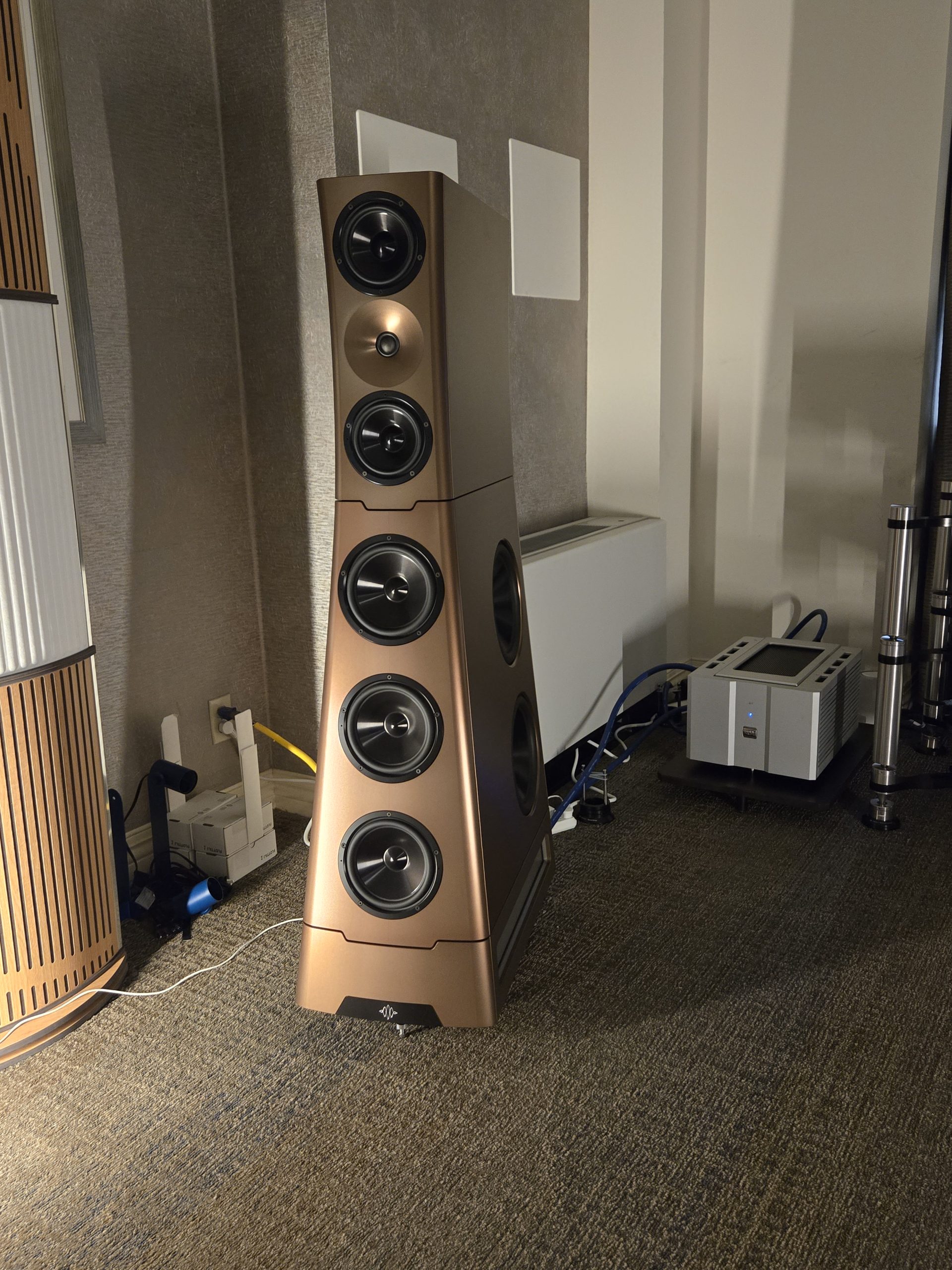 The XX is a 4-way design with dual 11-inch subwoofers, triple 7.25-inch mid-woofers, dual 6-inch midrange drivers, and a lattice hybrid tweeter. The finish is a matte copper, and in person, they are imposing-looking speakers. The sound quality was excellent and exceptionally neutral with an impressive coherence that one expects in this price range.
The XX is a 4-way design with dual 11-inch subwoofers, triple 7.25-inch mid-woofers, dual 6-inch midrange drivers, and a lattice hybrid tweeter. The finish is a matte copper, and in person, they are imposing-looking speakers. The sound quality was excellent and exceptionally neutral with an impressive coherence that one expects in this price range.
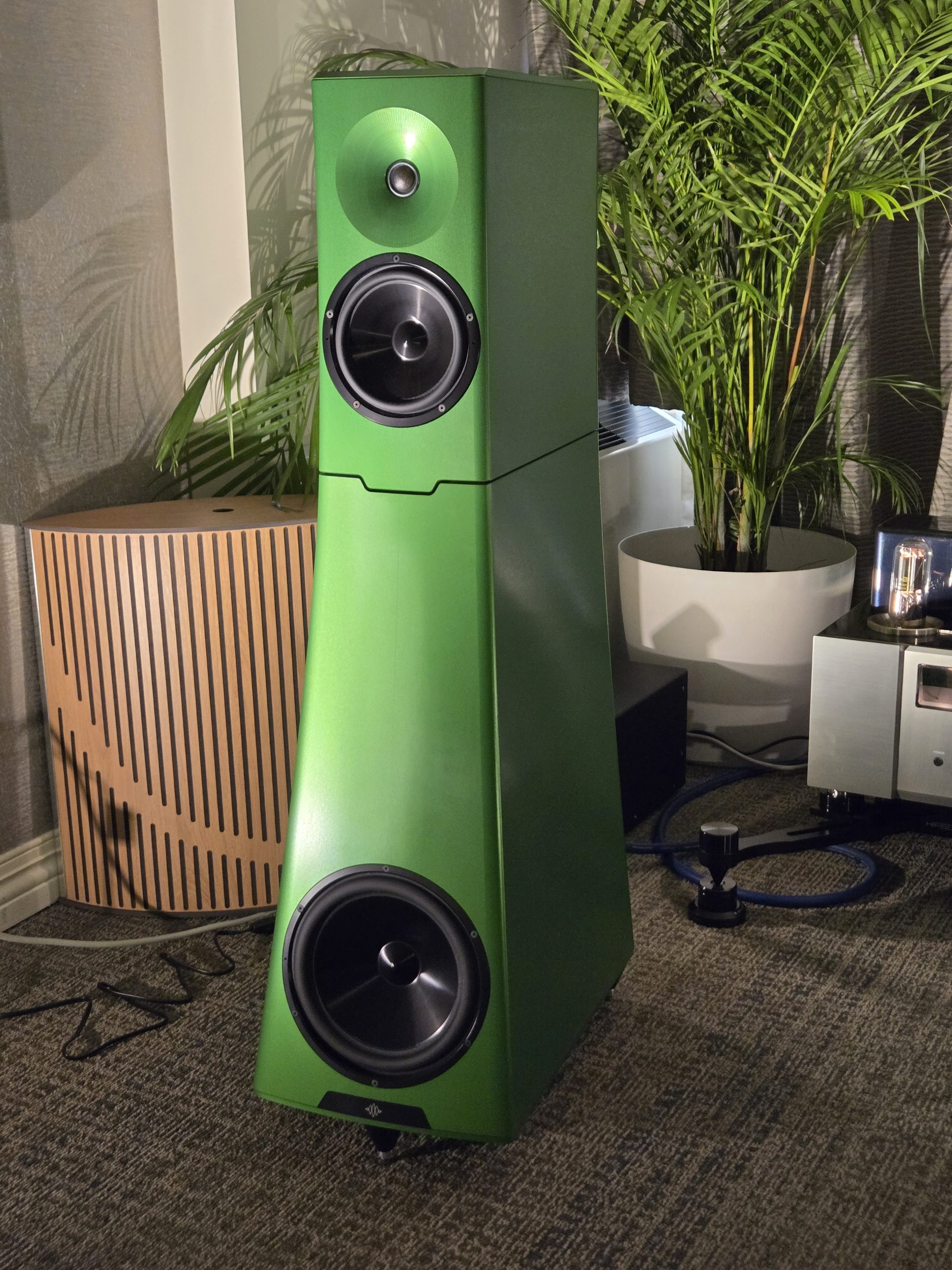 The Vantage 3 sounded quite close to their big brothers, with less bass and power, as one would expect. The finishes on all the YG Speakers are something one needs to see in person to appreciate. They exude ‘high end’ at every level. I only wish there was more time to get a better feel for both products.
The Vantage 3 sounded quite close to their big brothers, with less bass and power, as one would expect. The finishes on all the YG Speakers are something one needs to see in person to appreciate. They exude ‘high end’ at every level. I only wish there was more time to get a better feel for both products.
Paradigm / Anthem
Paradigm had on hand a pair of their top-of-the-line Persona 9H tower speakers ($37,500 per pair) being driven by (sister company’s) Anthem STR pre-amp @ $4300 and matching Anthem STR power amp ($6500 and delivering 400 WPC / 8 ohms.
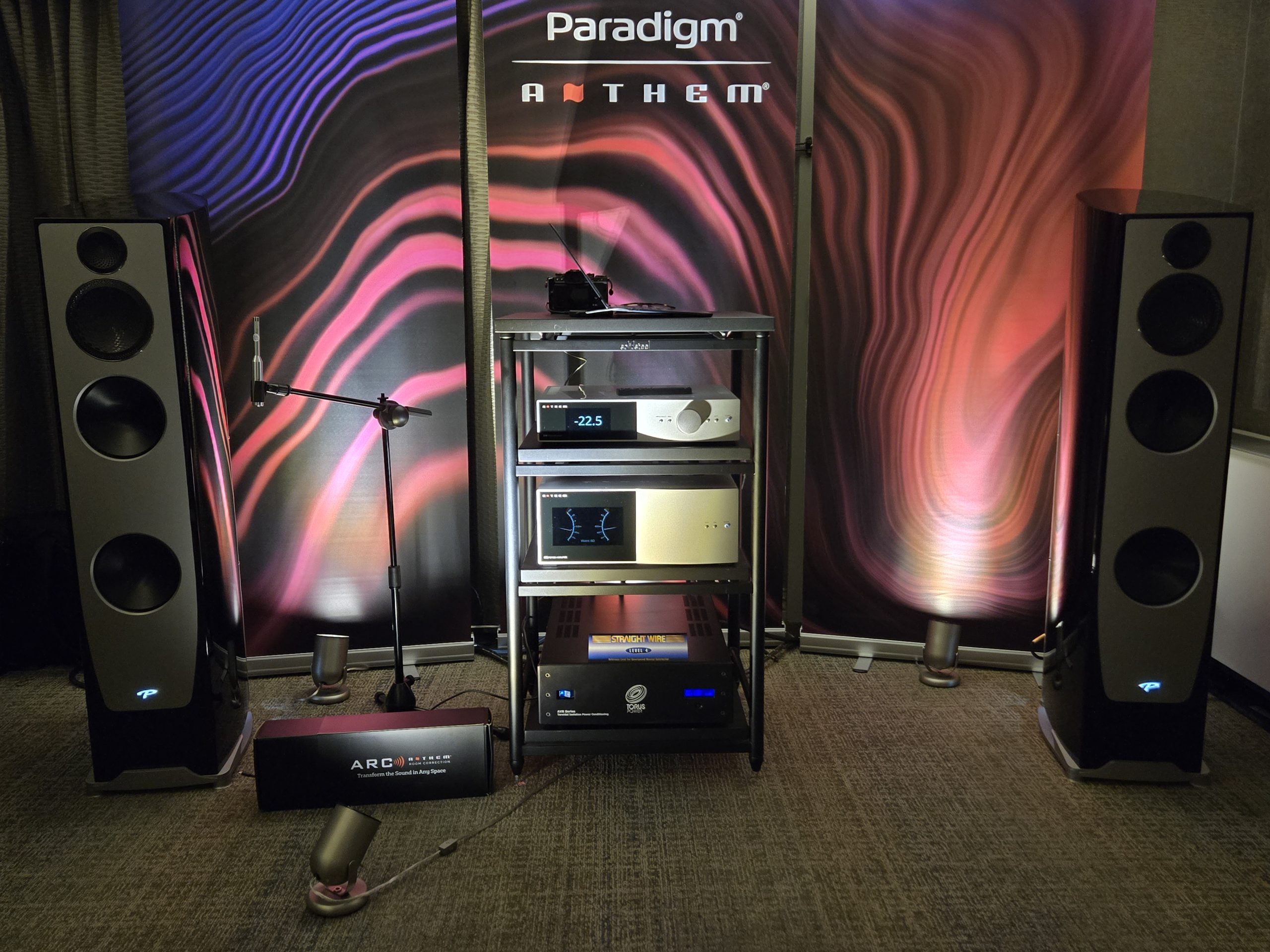 The Persona 9H towers feature quad 8.5-inch powered subwoofers which are rated to 19 Hz free space (-2 dB), a 7-inch Beryllium midrange, and a 1-inch Beryllium dome tweeter. Standing 52 inches tall and weighing 190 pounds each, the Persona 9H is designed to compete with cost-no-object loudspeakers.
The Persona 9H towers feature quad 8.5-inch powered subwoofers which are rated to 19 Hz free space (-2 dB), a 7-inch Beryllium midrange, and a 1-inch Beryllium dome tweeter. Standing 52 inches tall and weighing 190 pounds each, the Persona 9H is designed to compete with cost-no-object loudspeakers.
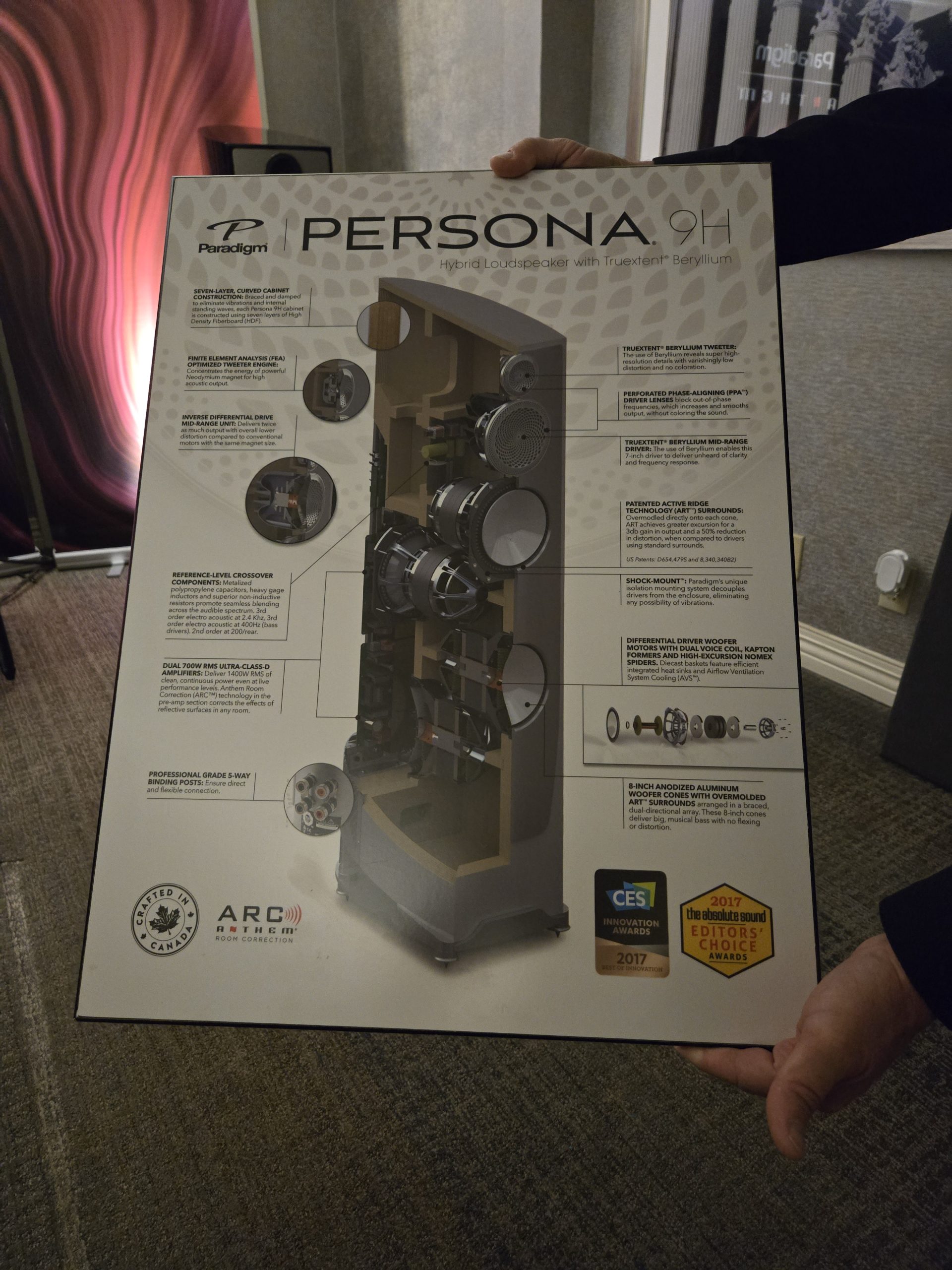 Even with a relatively affordable $10,800 pre-amp/power amp system driving them, the Paradigms were delivering true subwoofer-level bass and what felt like endless dynamics that felt like a system that was punching above its weight class in terms of price. Paradigm has been known for decades as a great value speaker company. Based on what these Persona 9H towers were delivering, one might just say great without the caveat of price.
Even with a relatively affordable $10,800 pre-amp/power amp system driving them, the Paradigms were delivering true subwoofer-level bass and what felt like endless dynamics that felt like a system that was punching above its weight class in terms of price. Paradigm has been known for decades as a great value speaker company. Based on what these Persona 9H towers were delivering, one might just say great without the caveat of price.
Audio Group Denmark / Axxess Audio
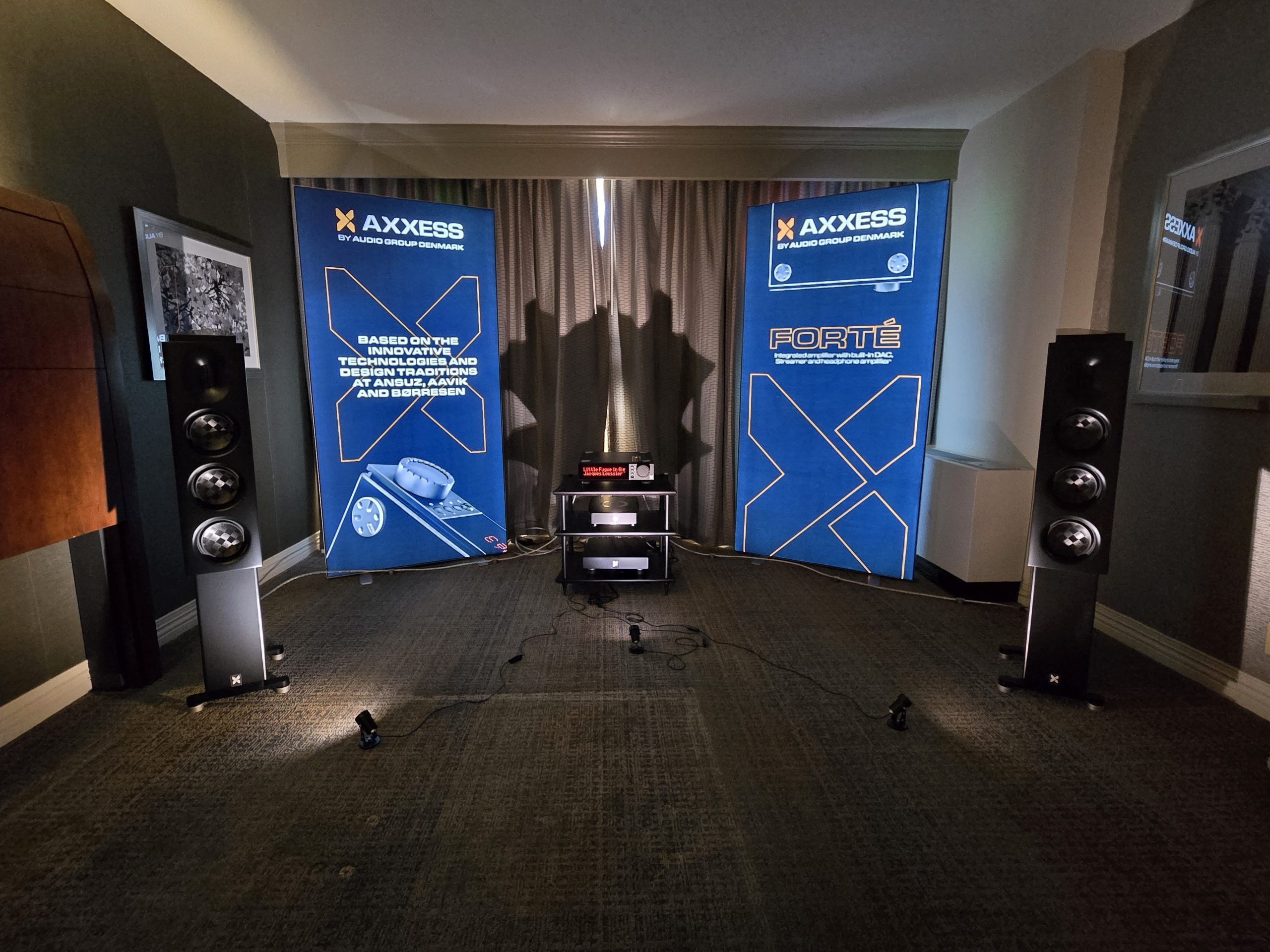 Walking into the Axxess Audio room, one is immediately struck with the thought that there isn’t a lot there. There was one ‘box’ hooked up to two speakers.
Walking into the Axxess Audio room, one is immediately struck with the thought that there isn’t a lot there. There was one ‘box’ hooked up to two speakers.
That box is the $5500 Axxess Audio Forte 1 streaming integrated amplifier. The Forte 1 can stream from almost any source and provides 100 watts per channel into an 8-ohm load. It was connected to the Axxess L3 tower speakers, also priced at $5500 – leading to a system price of $11,000 plus speaker cables.
The L3 speakers are 49-inch-tall towers that weigh in at 67 pounds. The woofers are comprised of carbon fiber membranes stretched over a honeycomb interior, and measure 4.5 inches in diameter. They hand off to a 4.5-inch midrange which in turn gives way to a planar ribbon tweeter. All drivers are designed in-house.
These speakers may be a poster child for blind tests. When Johnny Cash’s rendition of ‘Sound of Silence’ was fired up at a pretty stout level of SPL, my jaw dropped. The depth of his voice was nothing short of inspiring. This led to listening to a variety of tracks featuring female vocals, small jazz, well recorded rock and synthesized bass. These unassuming speakers delivered on everything and are definitely on the radar and worthy of an audition.
Advance Paris and PMC
PMC loudspeakers are not an unknown in the USA, but Advance Paris is a newcomer. This may change soon based on their product offerings. While several products were on display, the exceptionally clever Advance Paris MyConnect 250 Tuner, CD Player, Streamer and high-end pre-amp/power amp was connected to a pair of PMC Prodigy loudspeakers. The Advance Paris MyConnect 250 retails for $4300 and the PMC Prodigy 5 speakers are $2800 per pair.
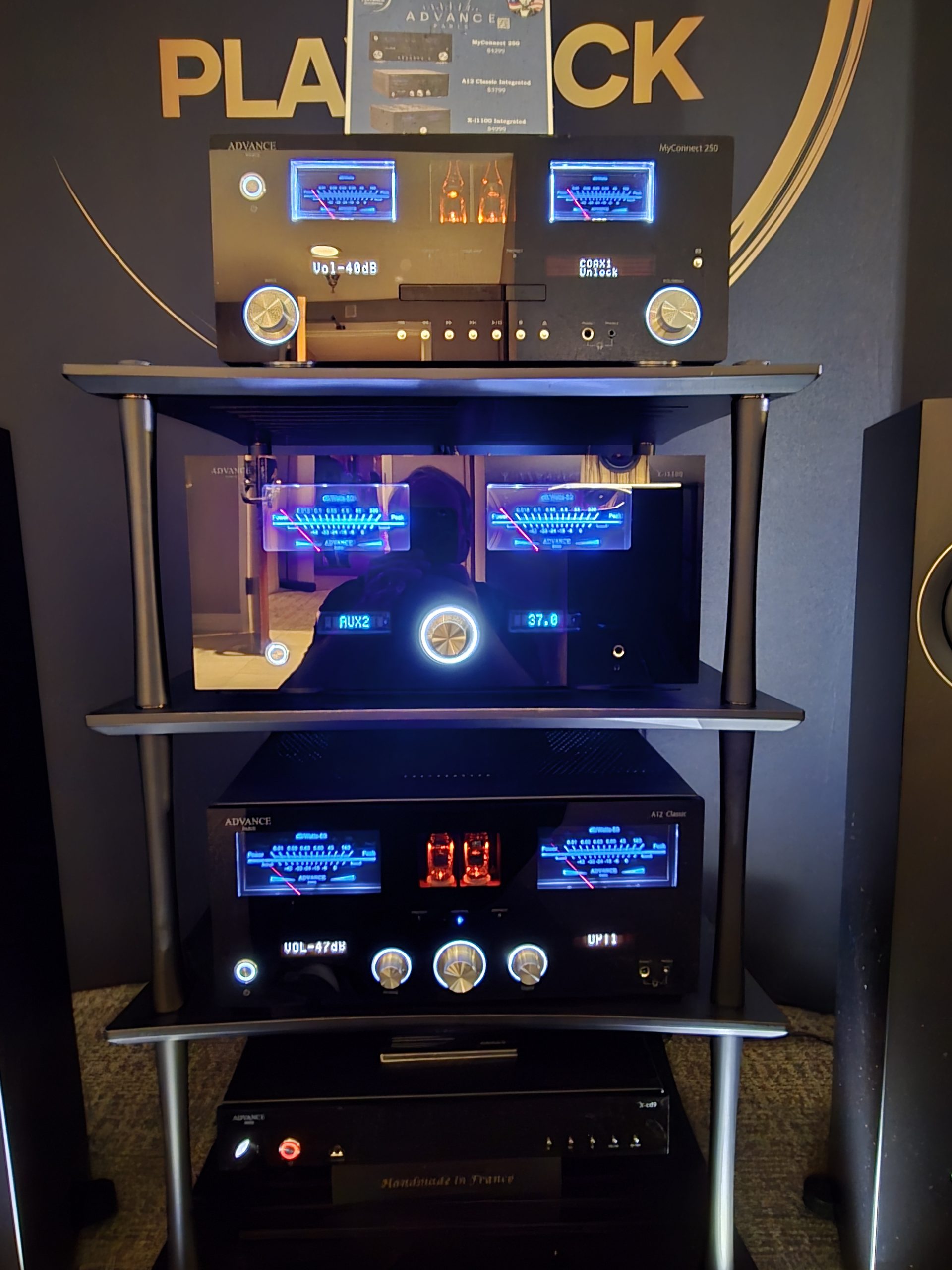 This is not a typo – the entire system, including CD player, is $7100 plus speaker cables. The MyConnect 250 is anchored by a 190 WPC (8 ohms) power amplifier. The PMC Prodigy 5’s are a 35-inch-tall tower with a 5.25-inch-long throw woofer with a proprietary venting system that delivers a solid bass floor well into the 35 Hz range. This is the type of system that is not just affordable, it is affordable excellence.
This is not a typo – the entire system, including CD player, is $7100 plus speaker cables. The MyConnect 250 is anchored by a 190 WPC (8 ohms) power amplifier. The PMC Prodigy 5’s are a 35-inch-tall tower with a 5.25-inch-long throw woofer with a proprietary venting system that delivers a solid bass floor well into the 35 Hz range. This is the type of system that is not just affordable, it is affordable excellence.
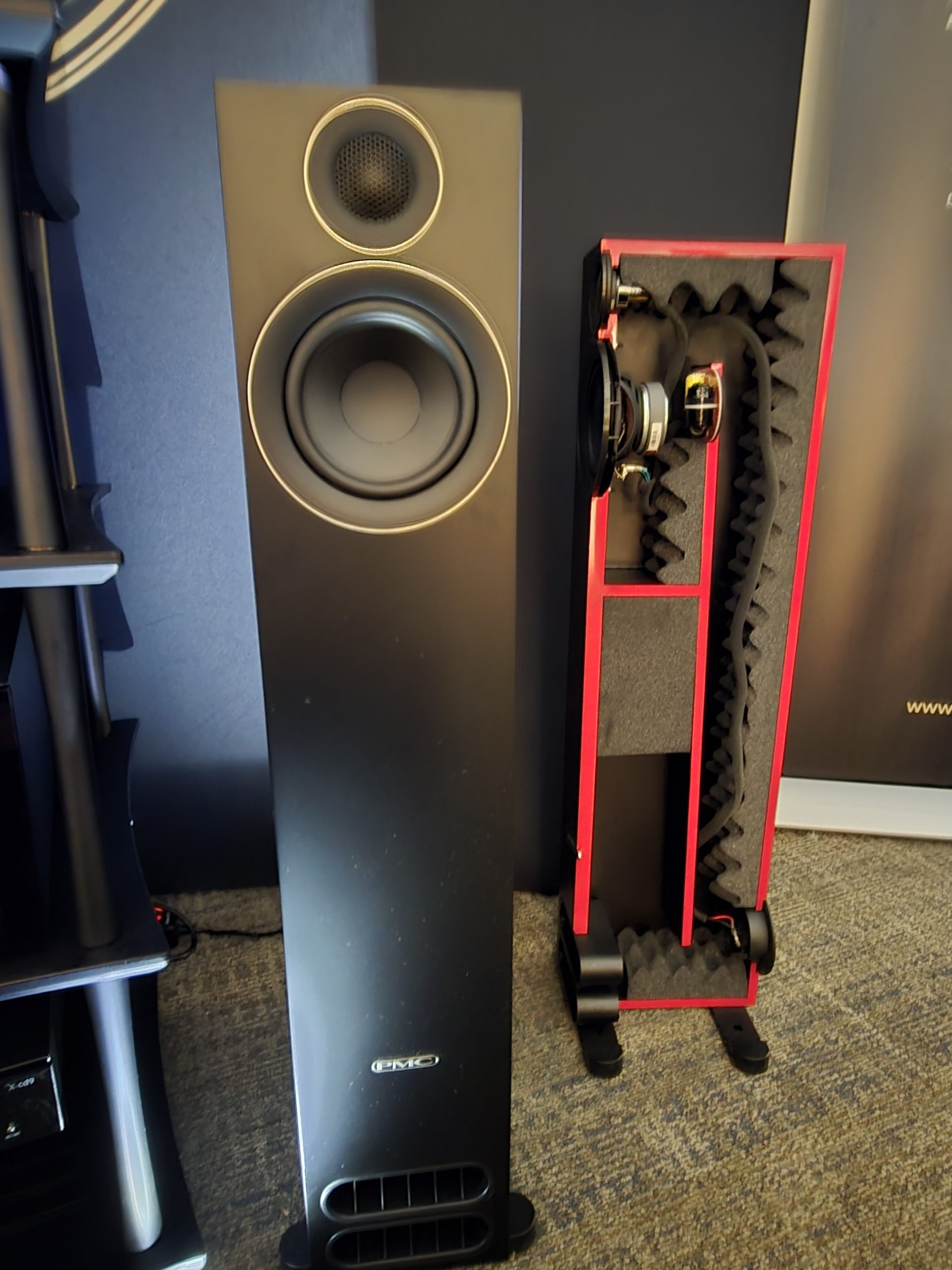 One could easily expand this system in the future thanks to the dedicated subwoofer outputs on the MyConnect 250 plus its pre-amp outputs (both XLR and RCA). Even with the simple system as configured, bass response was excellent and tuneful, and the Prodigy 5’s seemed to love the warmth of the class AB amp from the MyConnect. It’s great to experience a simple system that delivers on music.
One could easily expand this system in the future thanks to the dedicated subwoofer outputs on the MyConnect 250 plus its pre-amp outputs (both XLR and RCA). Even with the simple system as configured, bass response was excellent and tuneful, and the Prodigy 5’s seemed to love the warmth of the class AB amp from the MyConnect. It’s great to experience a simple system that delivers on music.
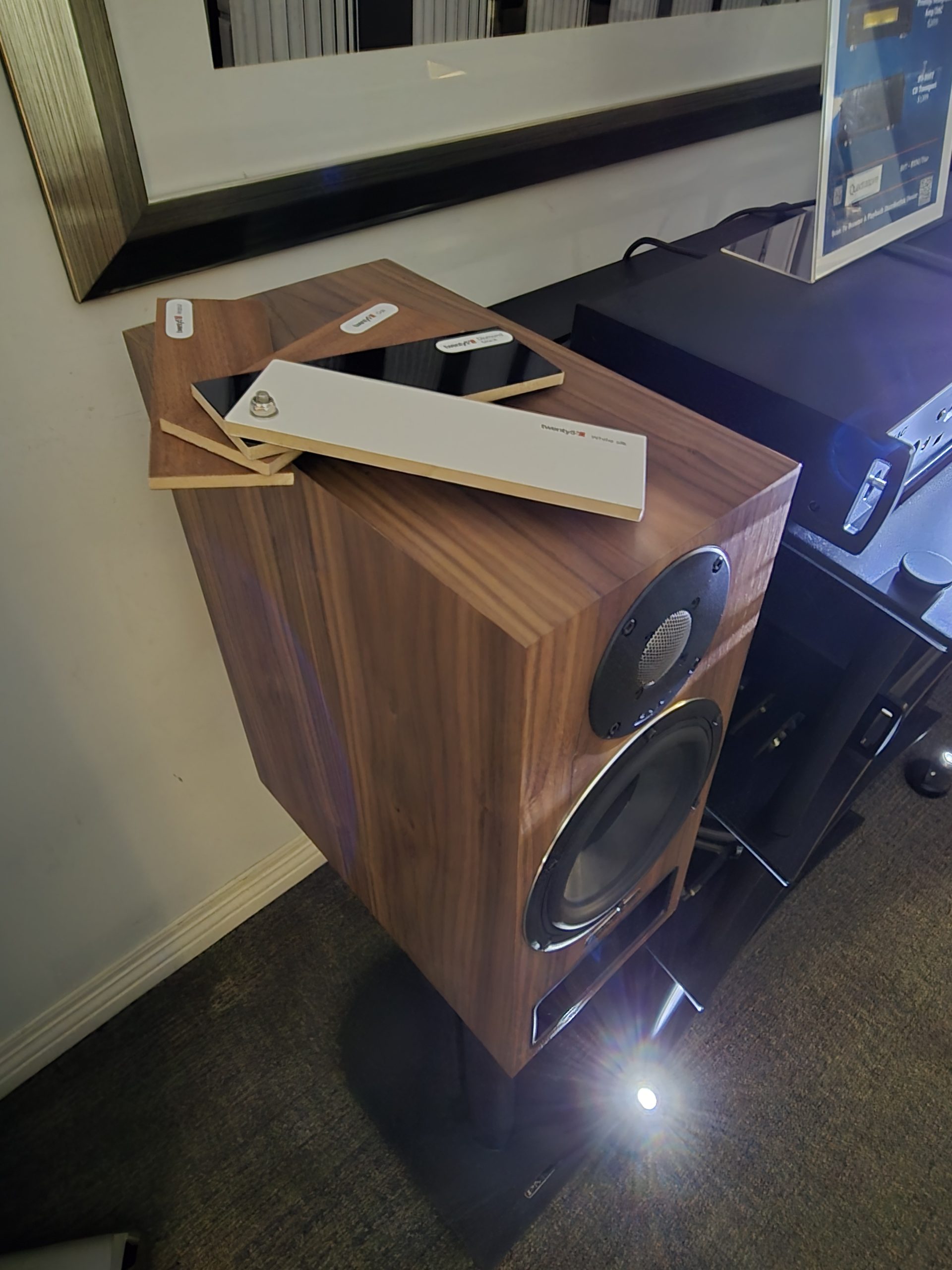 Also of note, even though they were not hooked up, were the PMC 22i Active monitors. At $7000 per pair, they show another entry into a high-end system, all one needs to do is add a streamer.
Also of note, even though they were not hooked up, were the PMC 22i Active monitors. At $7000 per pair, they show another entry into a high-end system, all one needs to do is add a streamer.
Vienna Acoustics and Java
 Vienna Acoustics brought the limited edition (meaning when the current production is sold out, they are gone) Bach Ultimate SE towers. Retailing for $6000 per pair, they contain a proprietary 7-inch X3P mid woofer which, in concert with the rear port, claim to offer bass that extends to 35 Hz free space at -3 dB. The Bach SE’s are rated at 4 ohms, which is a sweet spot for the type of high-quality amplifier that one expects to use with these surprisingly potent towers.
Vienna Acoustics brought the limited edition (meaning when the current production is sold out, they are gone) Bach Ultimate SE towers. Retailing for $6000 per pair, they contain a proprietary 7-inch X3P mid woofer which, in concert with the rear port, claim to offer bass that extends to 35 Hz free space at -3 dB. The Bach SE’s are rated at 4 ohms, which is a sweet spot for the type of high-quality amplifier that one expects to use with these surprisingly potent towers.
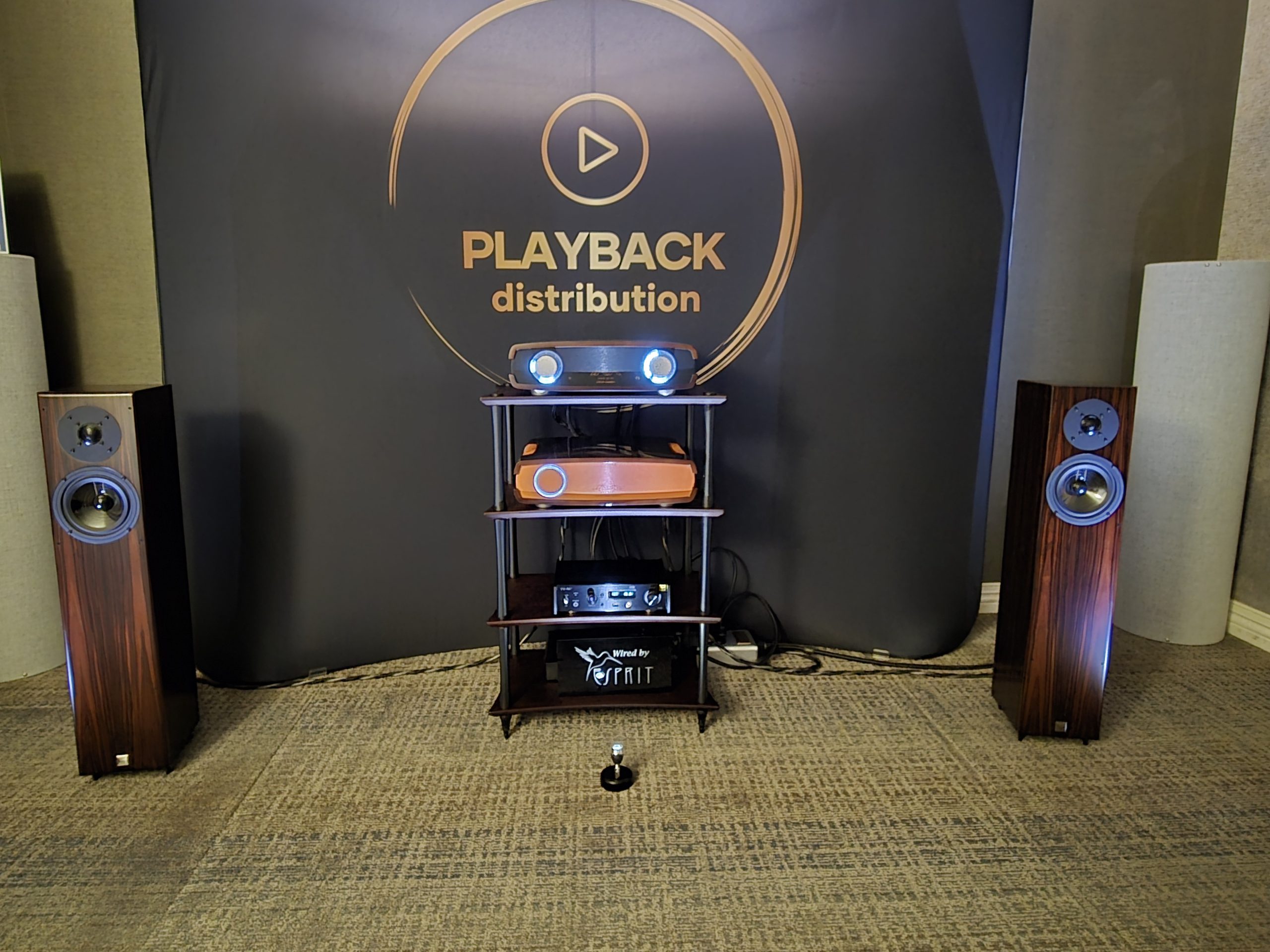 The finish is beautiful rosewood, and the Bach SE’s are without a doubt a high-end product. Even though they don’t need anything quite this powerful, for this demo, they were driven by a $15,000 combination of Java’s Double Shot pre-amp ($5995) and Double Shot power amp ($8995). The Double Shot (in all its orange finish glory) can deliver 400 WPC into 8 ohms and 800 into 4 ohms. Java’s own Single shot integrated amp could also wring out all the performance of the Vienna Acoustics Bach SE’s for $8995, so don’t let budget stop you.
The finish is beautiful rosewood, and the Bach SE’s are without a doubt a high-end product. Even though they don’t need anything quite this powerful, for this demo, they were driven by a $15,000 combination of Java’s Double Shot pre-amp ($5995) and Double Shot power amp ($8995). The Double Shot (in all its orange finish glory) can deliver 400 WPC into 8 ohms and 800 into 4 ohms. Java’s own Single shot integrated amp could also wring out all the performance of the Vienna Acoustics Bach SE’s for $8995, so don’t let budget stop you.
The performance was another showstopper. Several people who were in the room insisted that there HAD to be a subwoofer hidden somewhere. Two gents even went to look behind the audio rack to satisfy their own disbelief that these modest sized towers were shaking the room with deep bass. We were treated to men with baritone deep vocals, lovely female vocals, driving guitar (including a cover of Led Zeppelin’s ‘Whole Lotta Love’ that extended a full octave below Zep’s 54-year-old masterpiece), kick drums and even pipe organ. These modest towers were delivering a 32 Hz fundamental that seemed impossible. Vienna Acoustics definitely warrants more attention in the USA.
Espirit Speakers meet Esoteric Electronics
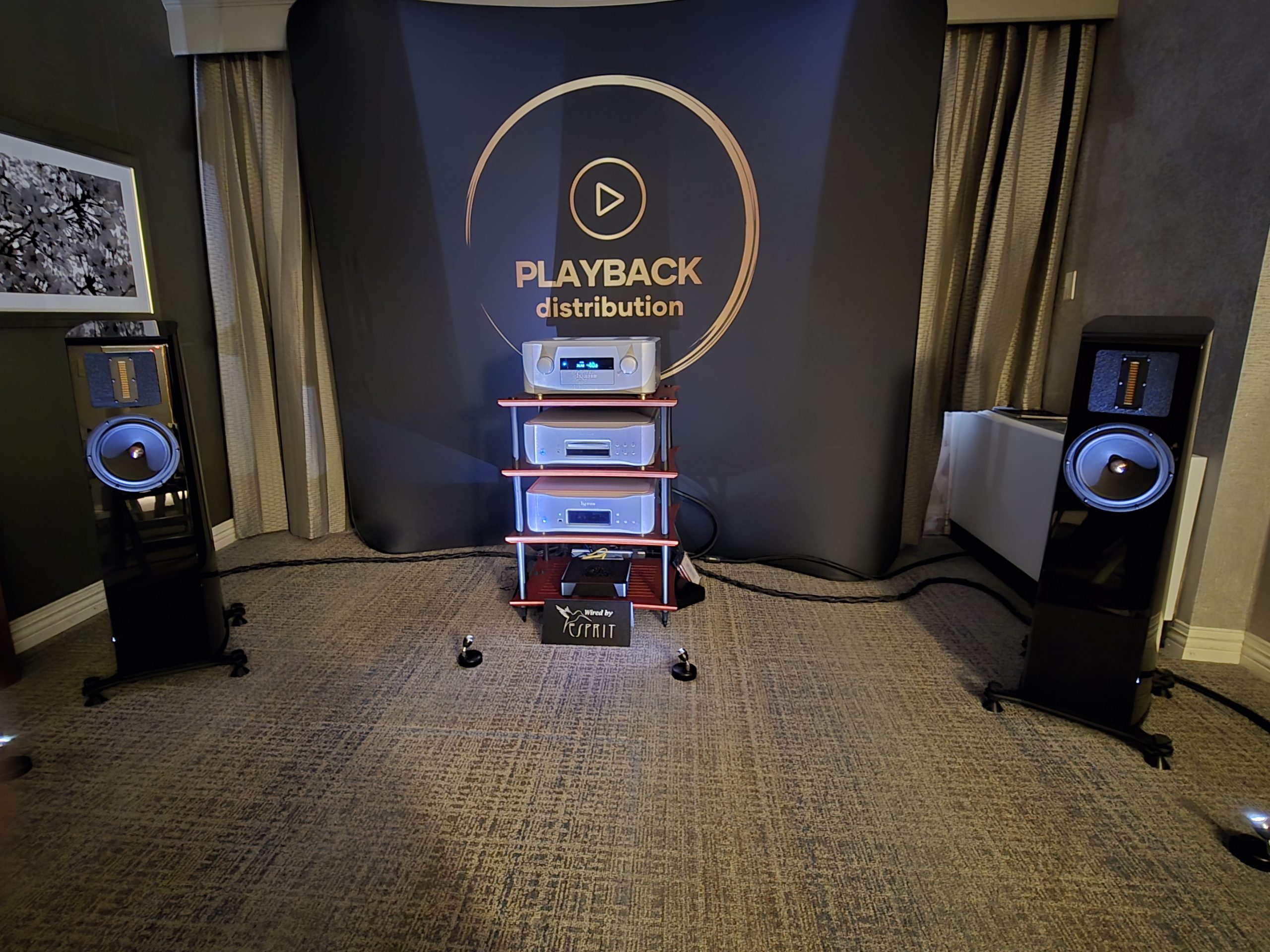 Today’s final listening room re-entered a more high-end territory. The main event was a pair of $20,000 Espirit Amelia floor-standing loudspeakers driven by the Esoteric F-01 Class ‘A’ integrated amp ($18,000) which was fed by the $25,000 Esoteric K-01XD SACD player,
Today’s final listening room re-entered a more high-end territory. The main event was a pair of $20,000 Espirit Amelia floor-standing loudspeakers driven by the Esoteric F-01 Class ‘A’ integrated amp ($18,000) which was fed by the $25,000 Esoteric K-01XD SACD player,
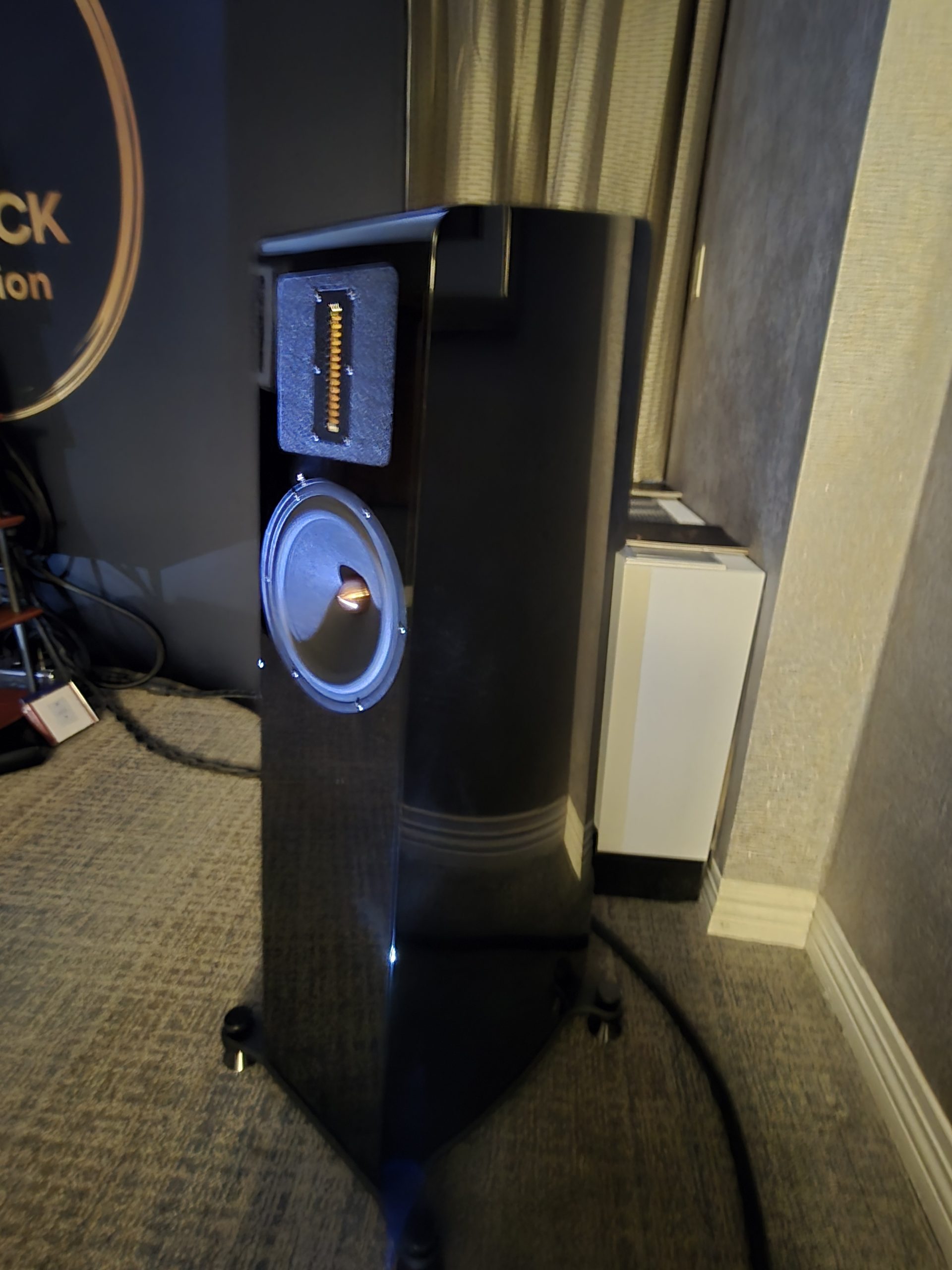 The Amelia floor standers offer an 8-inch woofer that hands off to an Air Motion tweeter. The woofer utilizes an ALNICO magnet, and the crossover is a 6 dB per octave design meant to keep distortion at a minimum and cohesion to a maximum.
The Amelia floor standers offer an 8-inch woofer that hands off to an Air Motion tweeter. The woofer utilizes an ALNICO magnet, and the crossover is a 6 dB per octave design meant to keep distortion at a minimum and cohesion to a maximum.
The Esoteric F-01 is rated at 30 watts of pure class A power (8 ohms) and 60 watts into the Amelia’s 4-ohm load. The sound coming from this speaker and amp system was see through, with a remarkable ability of the speakers to totally disappear. One got the feeling that one was experiencing an ‘adult’ system, as the system got out of the way and let the music happen. It was a tremendous way to end the day!
Day Three: Sunday
Day 3 continued with the quest of ‘quality over quantity.’ With over 200 rooms, and being only one person, there was no way to visit them all in the 22 total hours available over the three days. There is no doubt some fine rooms were missed, but there is also no doubt that the systems on which reports were made were all fine systems across a variety of budgets. Let’s see what was done on day 3.
Linear Tube Audio – Dr. Vinyl – Sound Lab
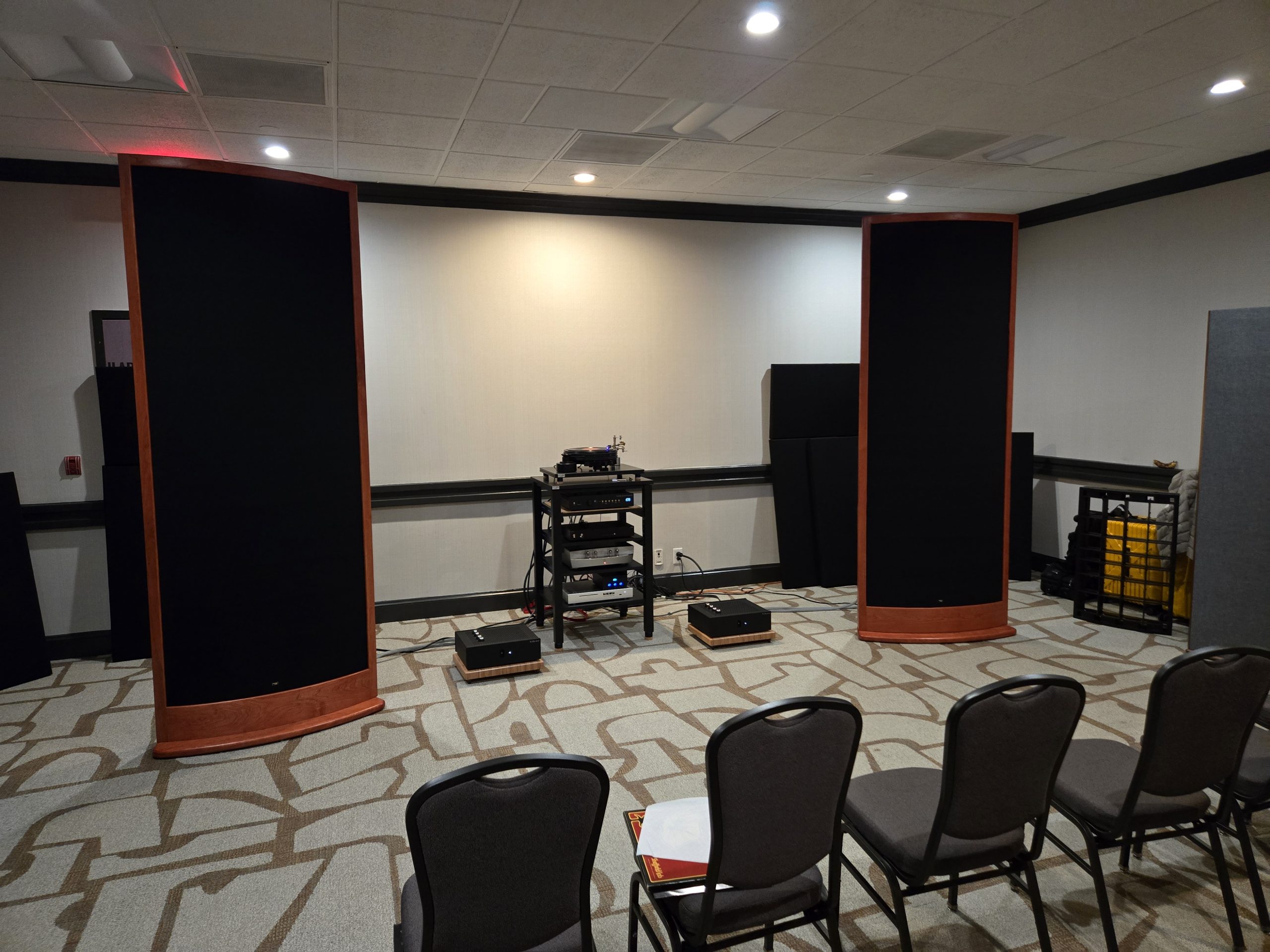 Entering the medium sized ballroom (roughly 30 x 40 feet with 10-foot ceilings), the Sound Lab G9-7C Electrostatic Towers immediately took over one’s visual sense. They stand NINE FEET tall and almost four feet wide, and absolutely DOMINATE the room.
Entering the medium sized ballroom (roughly 30 x 40 feet with 10-foot ceilings), the Sound Lab G9-7C Electrostatic Towers immediately took over one’s visual sense. They stand NINE FEET tall and almost four feet wide, and absolutely DOMINATE the room.
The system as being demonstrated today was a 432 EVO streamer ($7500), Linear Tube Audio’s Aero DAC ($3950), MicroZOTL Preamplifier ($5950) and ZOTL40 Reference + Monoblocks ($13,600 for the pair) plus the Sound Lab G9-7C Towers @ $65,900. This brings the total system price to $96,900 plus the cables of one’s choice.
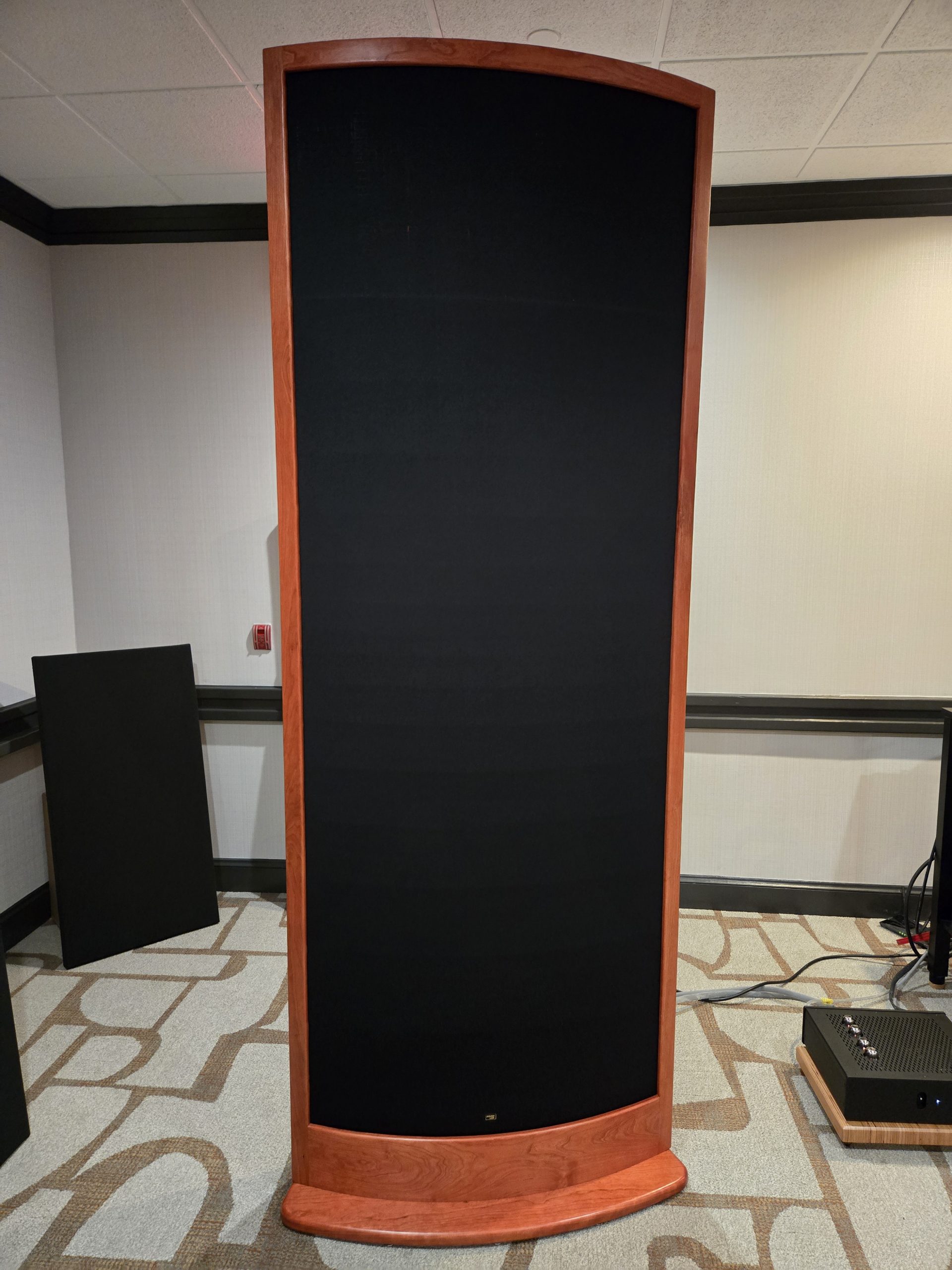 The system itself was nothing short of awe inspiring. These huge Electrostatic towers started with some live piano, and it is almost impossible to remember a speaker that reproduced piano with such ease and authority. The piano was alive in the room, and it was the stuff of which smiles are made. Then we moved on to a variety of additional tracks. There was synthesized bass in various rock music tracks that was lightning-fast while being authoritative and deep. A female trio harmonizing together with each being distinct and well placed. It was over an hour of sheer bliss, and leaving this audition was no easy task.
The system itself was nothing short of awe inspiring. These huge Electrostatic towers started with some live piano, and it is almost impossible to remember a speaker that reproduced piano with such ease and authority. The piano was alive in the room, and it was the stuff of which smiles are made. Then we moved on to a variety of additional tracks. There was synthesized bass in various rock music tracks that was lightning-fast while being authoritative and deep. A female trio harmonizing together with each being distinct and well placed. It was over an hour of sheer bliss, and leaving this audition was no easy task.
If this was a game of Jeopardy, the answer would be: A Sound Lab G9-7C Electrostatic based system. The question would be: “Alex, what is a bargain speaker for under $66,000?” Of course, the fact that $30,000 in mostly tube gear was capable of driving this magnificent system was also a note worthy accomplishment, and this room was the first of several surprises today.
IsoAcoustics and Direct Comparison
The next stop was a completely different experience, but in no way a lesser one. The Iso-Acoustics room featured products which (as the name suggests) are designed to ISOlate one’s speakers (and subwoofers) from one’s room, in terms of direct energy from the room boundaries getting back into the transducers (which is what speakers are) and muddying the sound.
The demonstration was rather easy: One gets to hold a remote and flip back and forth between a pair of Monitor Audio floor stander speakers which were identical with the exception of the ‘feet’ which are designed to replace the feet which come standard with one’s speakers.
A simple push of a button switched from the speaker pair without and with the IsoAcoustics ‘GAIA’ Isolation feet. After flipping between the two speakers and noting the differences between ‘A’ and ‘B,’ I asked if ‘A’ was accidentally wired out of phase. The answer came in the form of a smile, and a question of ‘no, why do you ask?’ The reason was ‘A,’ which sounded simply fine at first, became increasingly less focused than ‘B’ on the variety of music tracks, almost sounding out of phase.
This led to a half hour conversation about the science behind the GAIA feet, and a decision to order some to try out in the various reviews slated over the winter. It would take too long to get into here, plus the entire audition was about 30 minutes. With that in mind, there was enough difference to warrant a fully vetted review of the GAIA line on some very high end, and not so high end, speakers at our place.
Angel City Audio
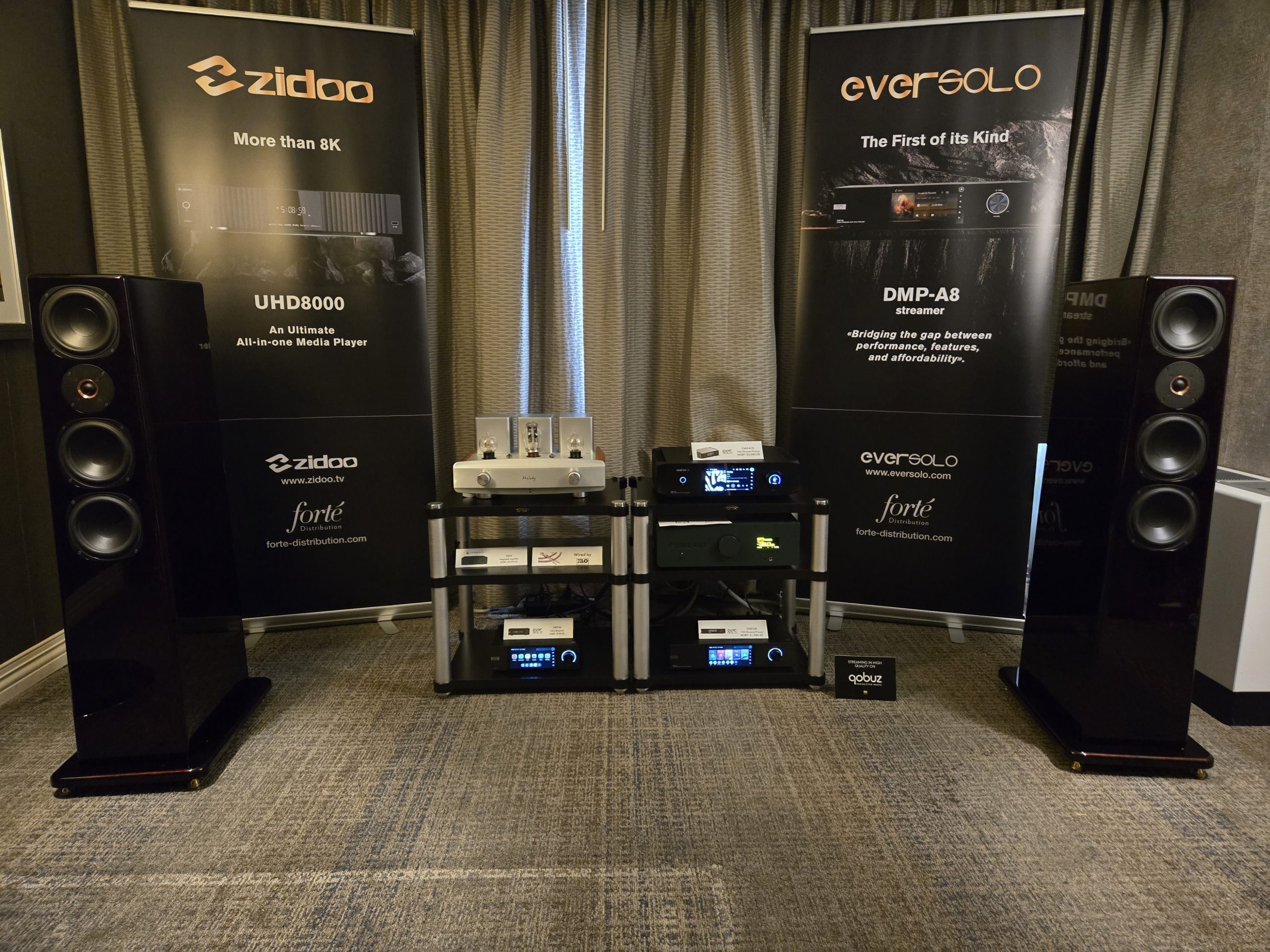 The next room ultimately ended up being another high value room that brought a lot of music for a reasonable investment in today’s high-end world. Angel City Audio sells direct to consumers, and they were featuring three products today.
The next room ultimately ended up being another high value room that brought a lot of music for a reasonable investment in today’s high-end world. Angel City Audio sells direct to consumers, and they were featuring three products today.
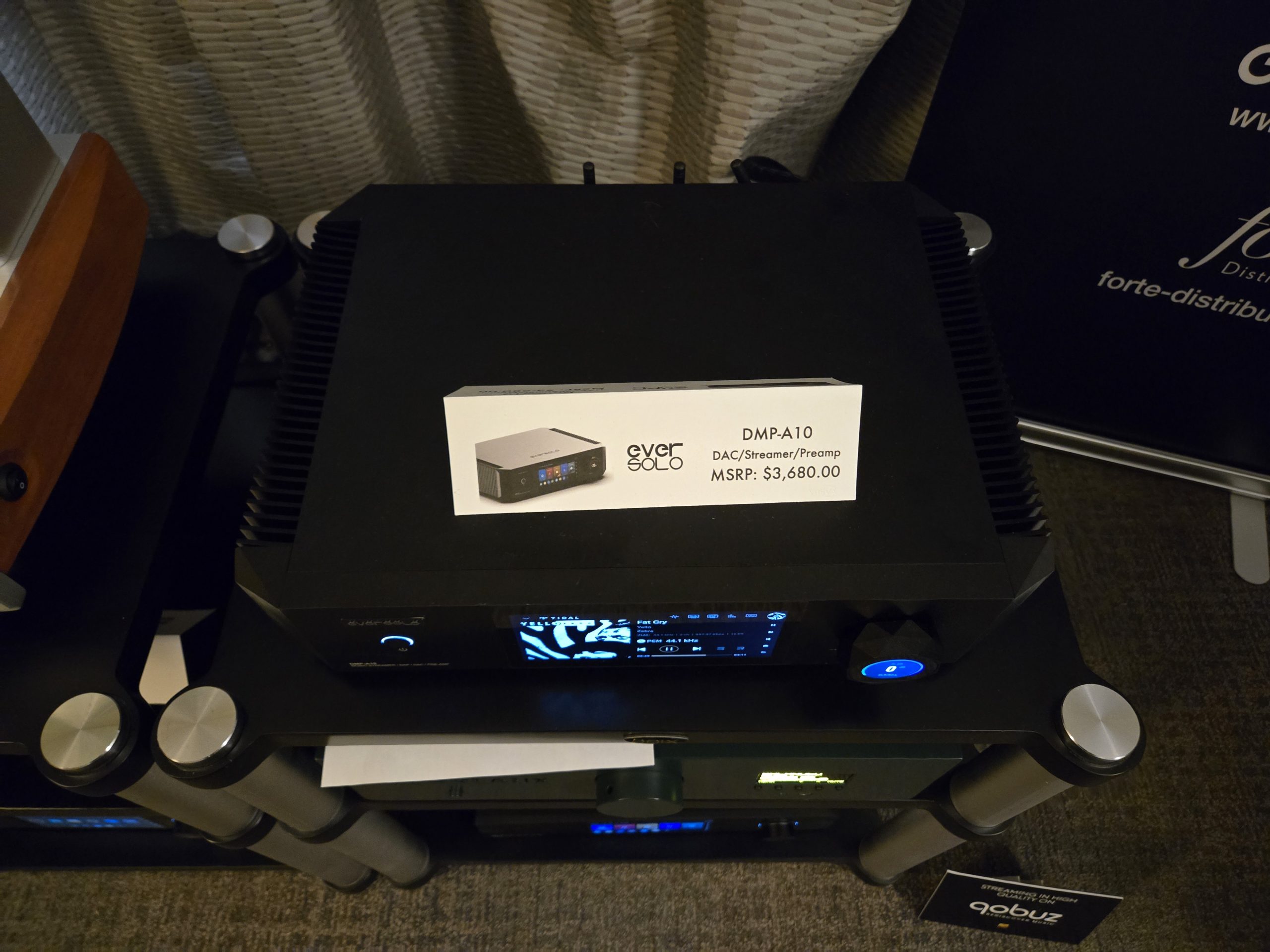
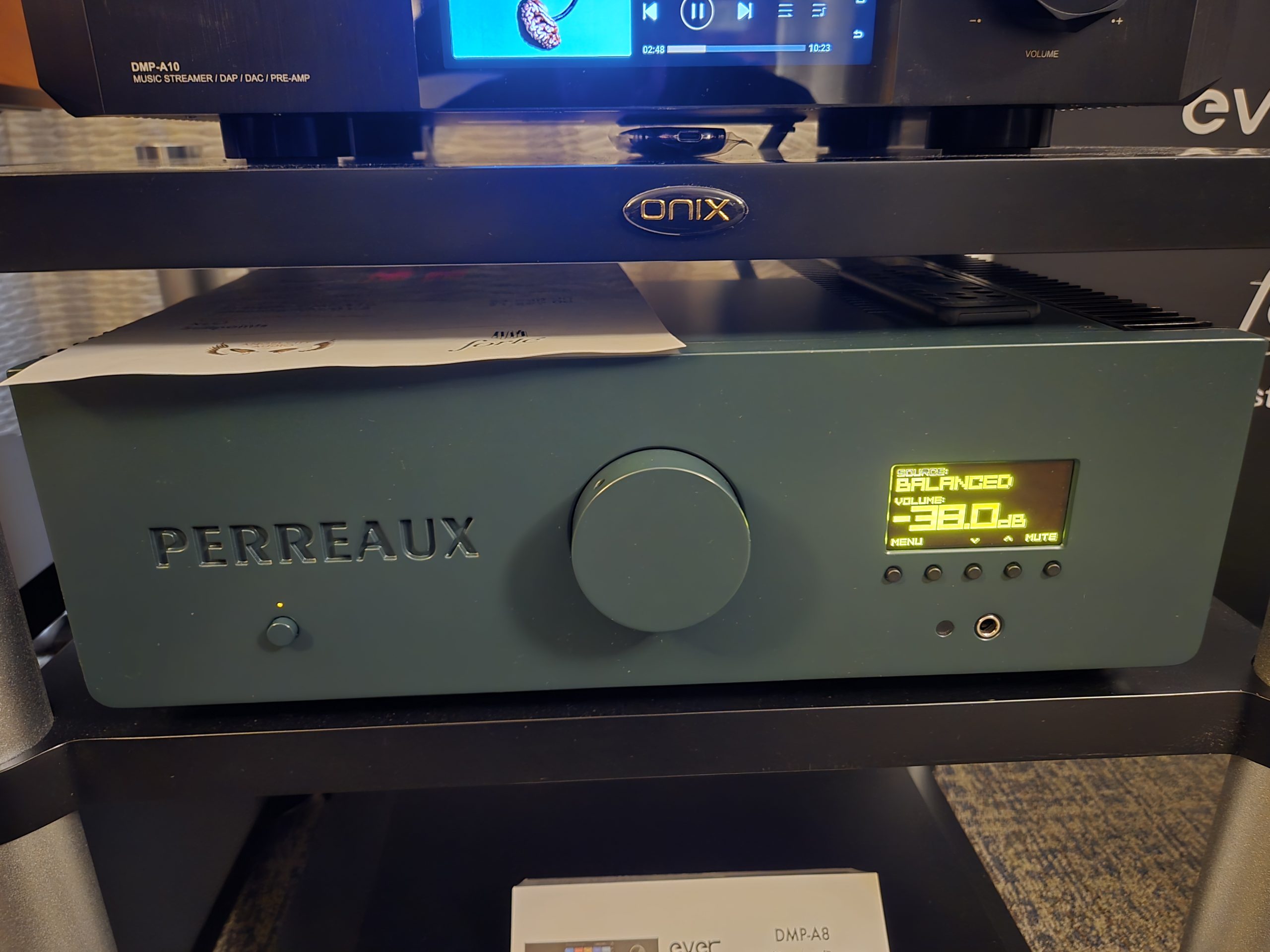 An Eversolo A10 streamer – DAC – Preamplifier ($3650) was driving a Perreaux power amp ($10,000) which in turn was powering a pair $16,000 Angel City Audio Seraphim loudspeakers. The Seraphim speakers are a 4-foot-tall tower using a pair of 7-inch proprietary woofers in a vented cabinet, a single proprietary 7-inch midrange and a SEAS 1-inch dome tweeter. EACH of these products deserves a review of its own, as all three gave the impression of products designed to compete with the best available while keeping a total system price of under $30,000 (plus cables).
An Eversolo A10 streamer – DAC – Preamplifier ($3650) was driving a Perreaux power amp ($10,000) which in turn was powering a pair $16,000 Angel City Audio Seraphim loudspeakers. The Seraphim speakers are a 4-foot-tall tower using a pair of 7-inch proprietary woofers in a vented cabinet, a single proprietary 7-inch midrange and a SEAS 1-inch dome tweeter. EACH of these products deserves a review of its own, as all three gave the impression of products designed to compete with the best available while keeping a total system price of under $30,000 (plus cables).
The Eversolo pre-amp is a terrific bargain, with all the features one expects in a full featured pre-amp (even subwoofer outputs) with the addition of an excellent streamer and DAC.
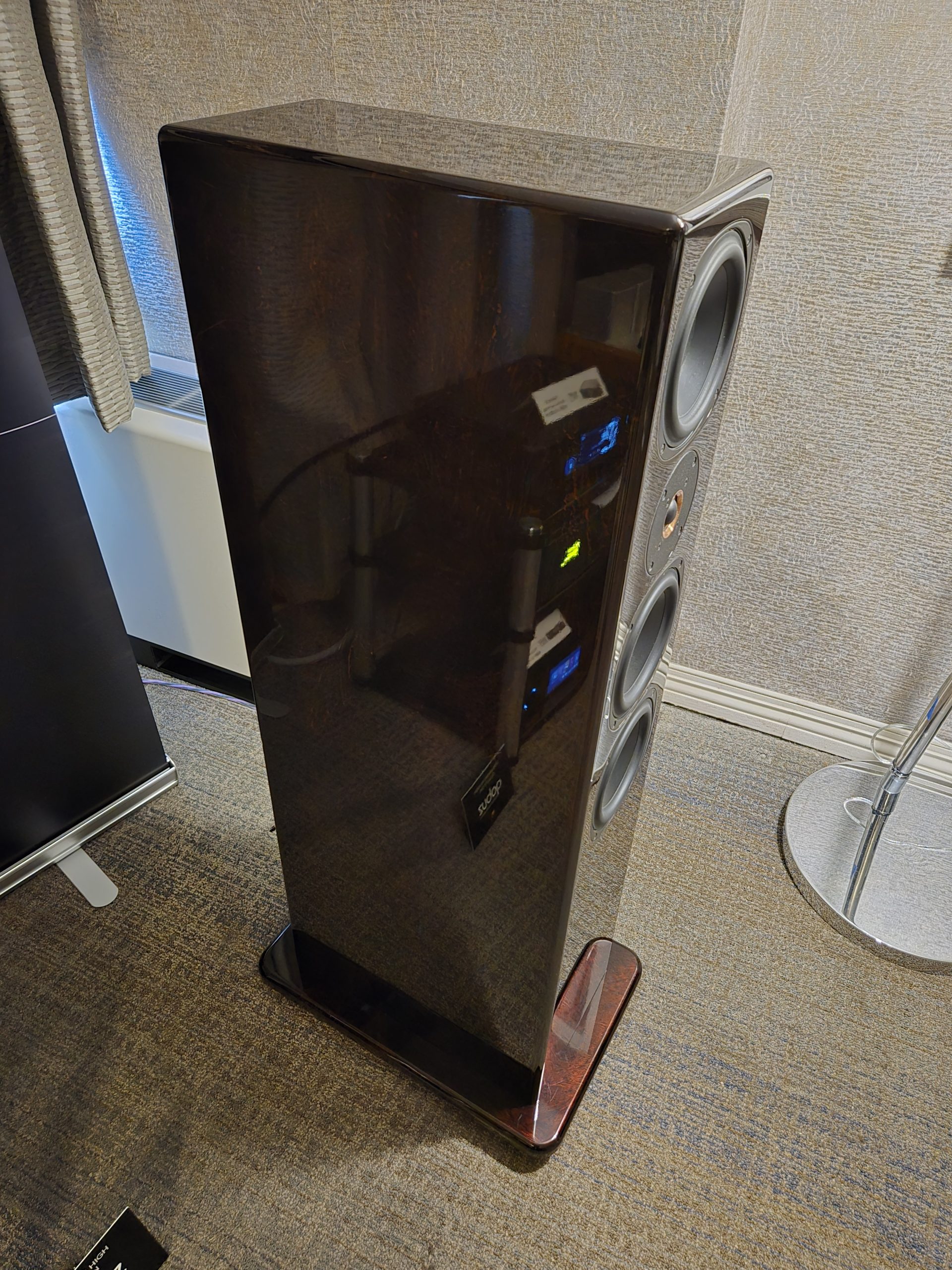 The system was one of the more pleasant surprises of the show. The speakers managed to both disappear while being musical across the bandwidth (+/- 2 dB from 28 Hz – 21kHz anechoic, in room extension to 22 Hz) at all volume levels. One aspect that stood out was the clarity at low volume levels. This speaks to an excellent crossover network and set the Seraphim towers apart as a true high-end speaker. They also handled a variety of genres with an almost liquid presentation, yet nothing in detail was lacking. It was another audition in which almost an hour was lost before pulling away to head to the next suite. Secrets definitely needs to review all three of these products.
The system was one of the more pleasant surprises of the show. The speakers managed to both disappear while being musical across the bandwidth (+/- 2 dB from 28 Hz – 21kHz anechoic, in room extension to 22 Hz) at all volume levels. One aspect that stood out was the clarity at low volume levels. This speaks to an excellent crossover network and set the Seraphim towers apart as a true high-end speaker. They also handled a variety of genres with an almost liquid presentation, yet nothing in detail was lacking. It was another audition in which almost an hour was lost before pulling away to head to the next suite. Secrets definitely needs to review all three of these products.
Fidelis Distribution
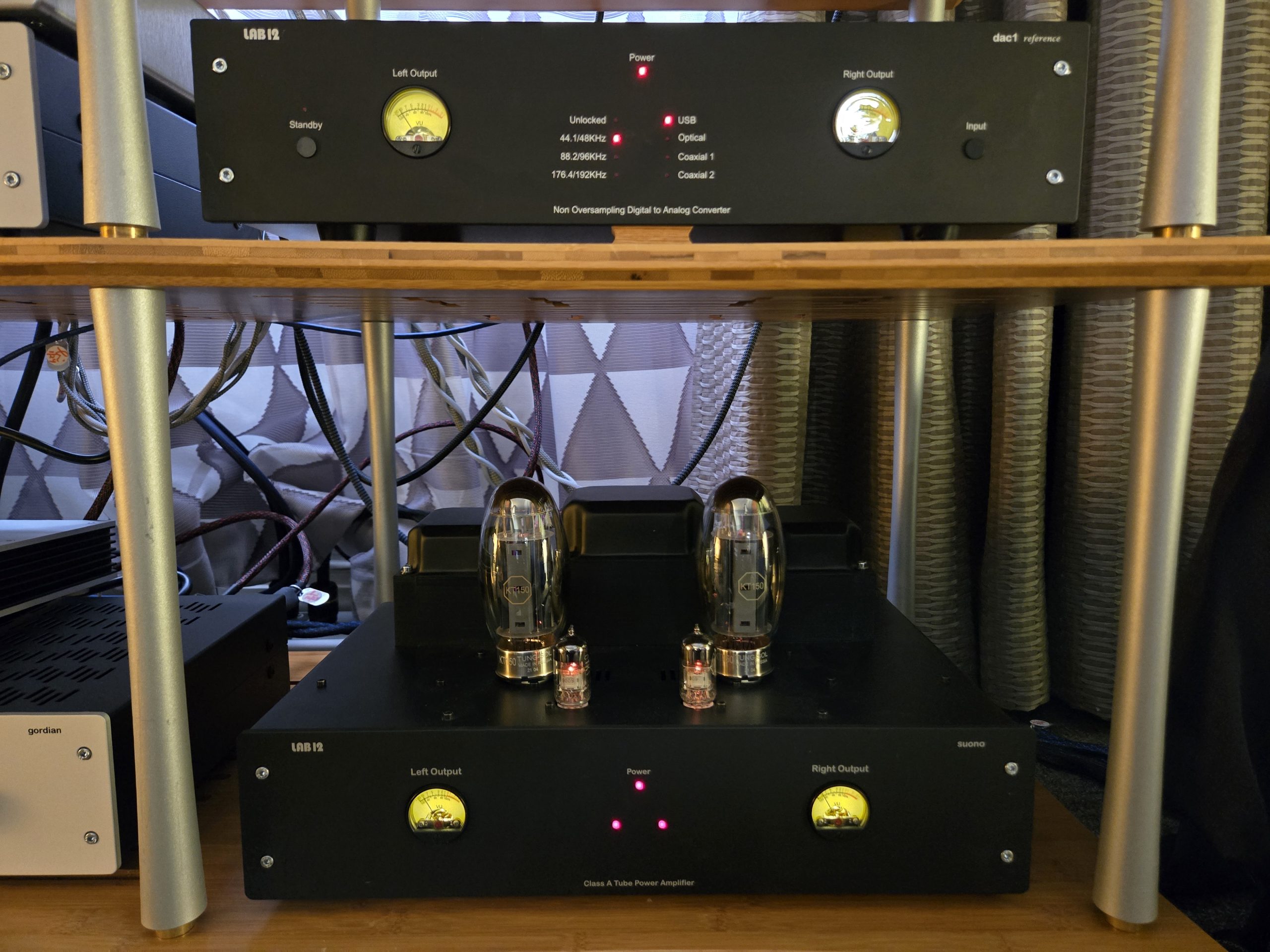 Fidelis Distribution is owned by industry veteran Walter Swanbon, and Walter brought a fantastic bargain of a system set up to the show. The feature system totaled about $15,000 for a pair of Falcon LS3/5A Gold Badge monitors (the one genuine LS3/5A speakers still available) for $3950 for the pair.
Fidelis Distribution is owned by industry veteran Walter Swanbon, and Walter brought a fantastic bargain of a system set up to the show. The feature system totaled about $15,000 for a pair of Falcon LS3/5A Gold Badge monitors (the one genuine LS3/5A speakers still available) for $3950 for the pair.
A LAB 12 Suono tube amplifer was feeding the Falcon speakers all the power they needed to bring music into the suite. The total system with streamer, cables, amp and speakers would run between $14,000 and $16,000, depending on options that one selected.
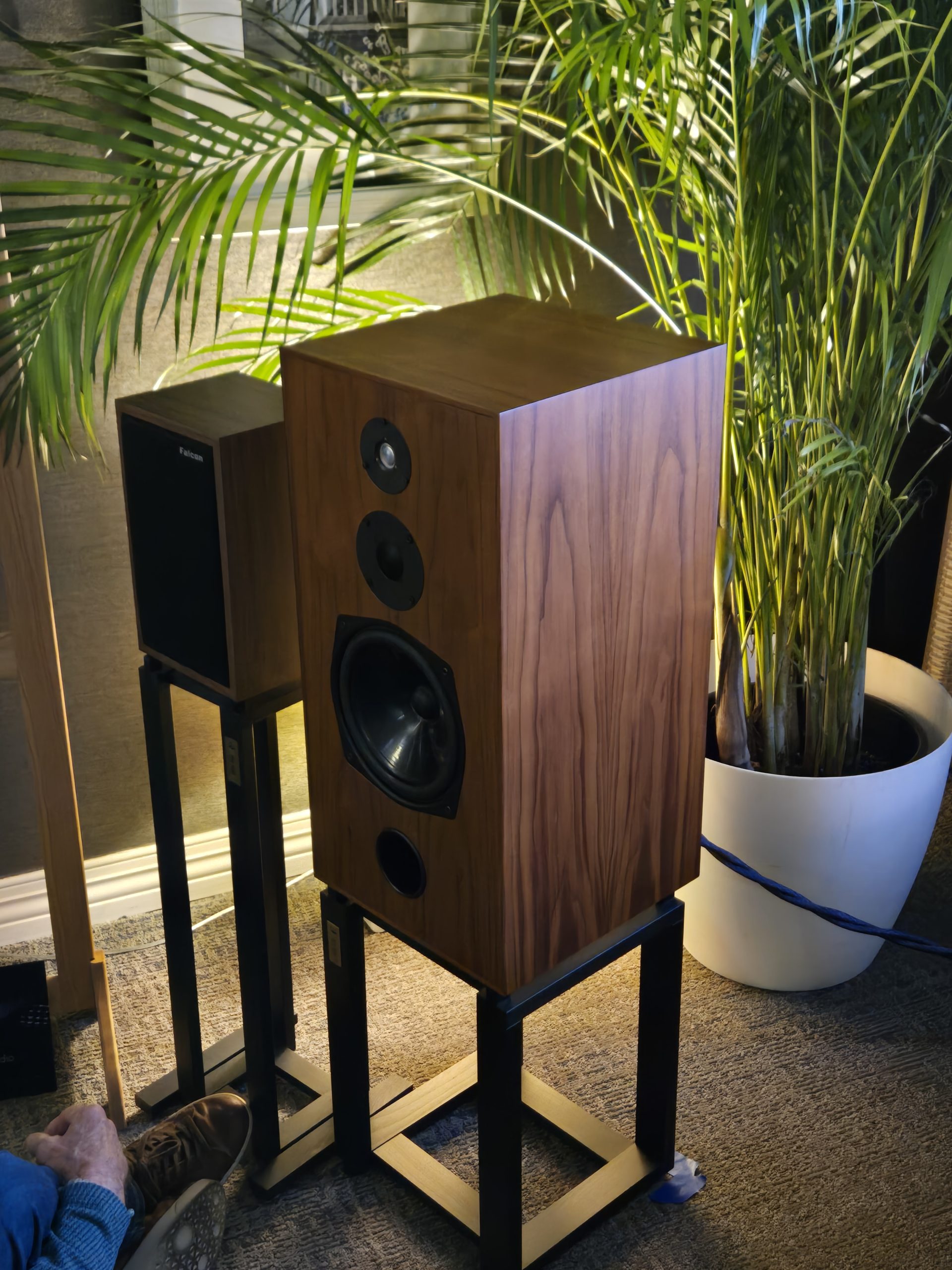 During the audition period, several show attendees entered the suite, and all were QUITE sure that the speakers playing MUST be the much larger ($6000 per pair) Falcon M30’s which were next to the L3/5A monitors. At least two had to walk behind the speakers so satisfy himself that the speakers were, in fact, the smaller monitors.
During the audition period, several show attendees entered the suite, and all were QUITE sure that the speakers playing MUST be the much larger ($6000 per pair) Falcon M30’s which were next to the L3/5A monitors. At least two had to walk behind the speakers so satisfy himself that the speakers were, in fact, the smaller monitors.
The sound was satisfyingly robust, with solid bass and exceptional articulation. It was the type of high end with style that harkens back to the 70’s, but with all the additional performance of the modern touches. The last day of the show continues the winning streak!
Audio Group Denmark
On day 2 of the show, Audio Group Denmark amazed with an $11,000 system featuring AXXESS products. Day 3 brought a new level of performance in a full size (60x50x12 feet) ball room. 36,000 cubic foot of party room is not an easy task into which good sound can be delivered, but success was had.
It was a relatively simple system consisting of a pair of (newly released) Børresen C3 loudspeakers and an AAVIK I-580 integrated amp and streamer. The AAVIK I-580 is rated to deliver 300 watts per channel (8 Ohms) and is a powerful beast of a component in every sense. The Børresen C3 speakers are so new that they are not even on the company’s website as of this writing.
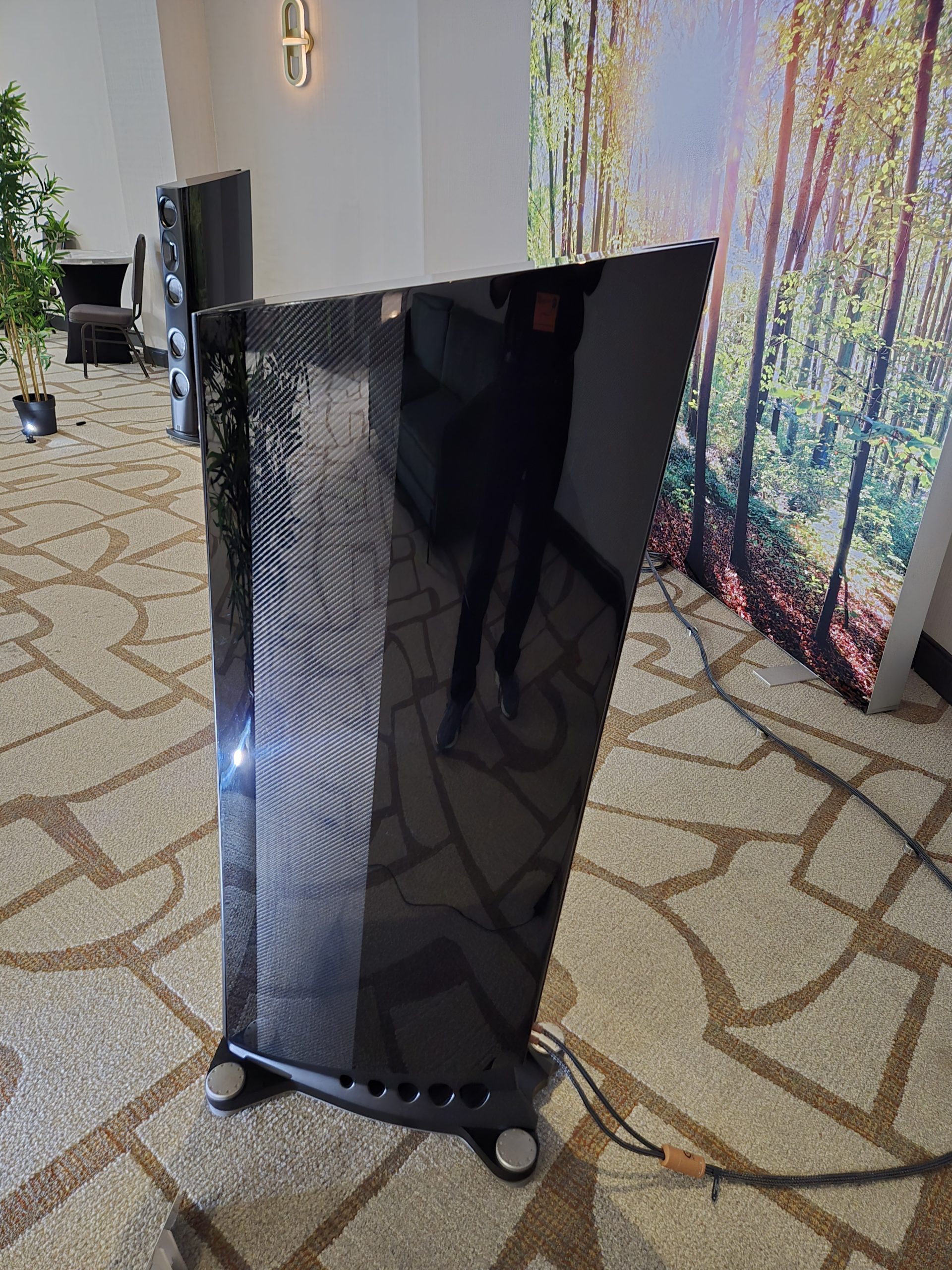 The speakers are moderately large towers, and retail for $38,000 USD per pair, while the AAVIK retails for $30,000. All one needs to do is add speaker cables, and the system is complete. The team at Audio Group Denmark only asked for one thing at this point: listen to the performance, and report on that experience. That seemed a reasonable request!
The speakers are moderately large towers, and retail for $38,000 USD per pair, while the AAVIK retails for $30,000. All one needs to do is add speaker cables, and the system is complete. The team at Audio Group Denmark only asked for one thing at this point: listen to the performance, and report on that experience. That seemed a reasonable request!
They opened with a rendition of ‘Sunshine of Your Love’ which was NOT the Cream circa 1967 version. It had a bass track and driving guitar that had the room shaking, and everyone there smiling. They moved on to a series of difficult tracks that ranged from male tenors, baritones, female sopranos and altos. Full scale orchestral music was also presented, and a drum track I had never heard, but want to find out where it is available. This demo kept in the tradition of today’s listening experiences: awe inspiring. Audio Group Denmark has something special going on with their line ups. The Børresen team asked if I had had a chance to hear the AXXESS speakers which were located 3 floors up, and they were all smiles when the answer was in the affirmative. They, as a group, seem well positioned to offer tremendous sound at almost any budget.
VPI-Pure Audio Project-Audio Research
Today’s final audition was in an equally large (to the Audio Group Denmark) room and was hosted by ‘Mat and Harry,’ the son-father ownership team at VPI who are to the turntable industry what Hope and Crosby were to entertainment.
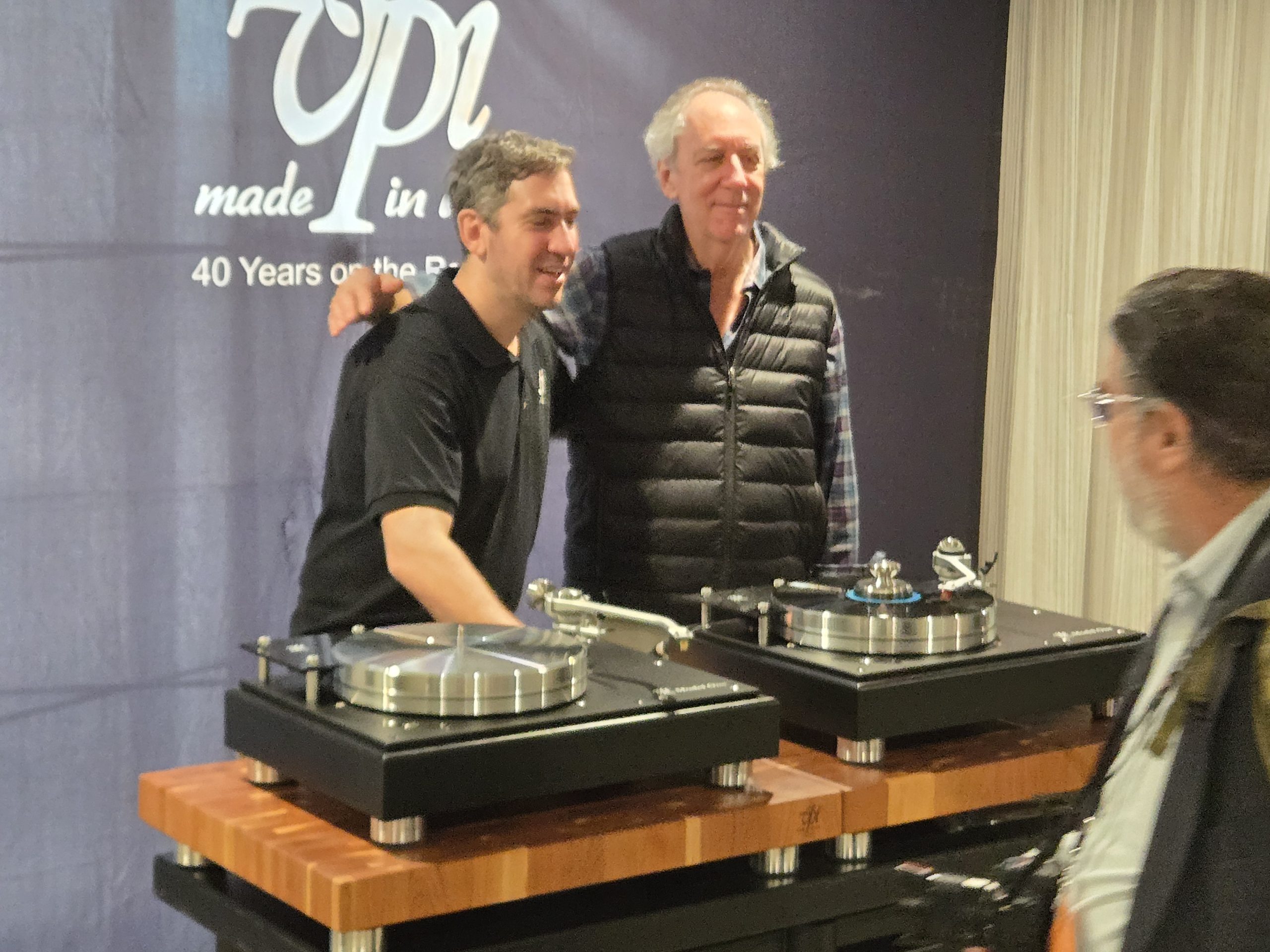
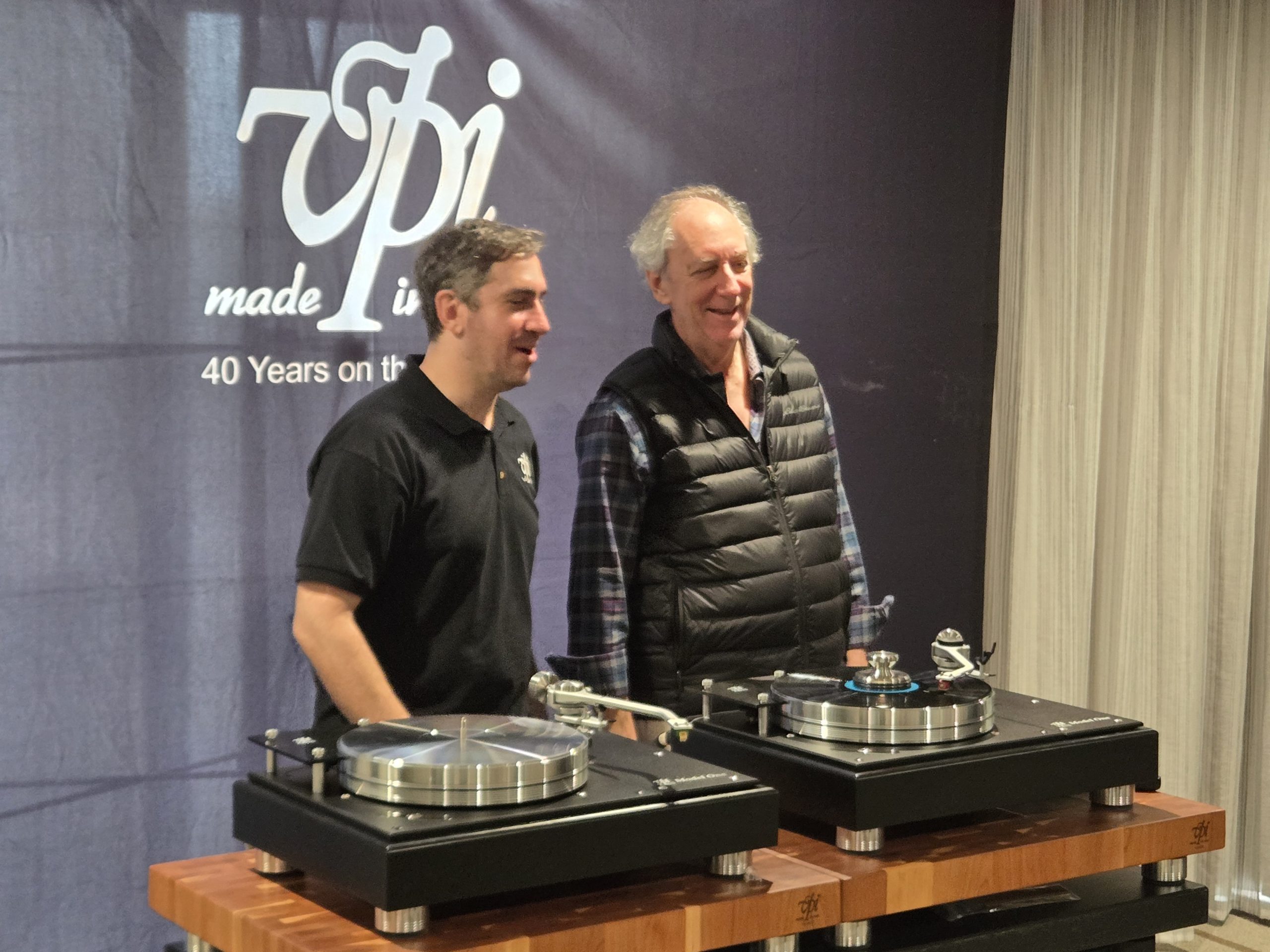 When entering the room, those two gents were posing for pictures while framed by the featured system. They were all smiles, showing NO wear after all the travel and 3 days of the show.
When entering the room, those two gents were posing for pictures while framed by the featured system. They were all smiles, showing NO wear after all the travel and 3 days of the show.
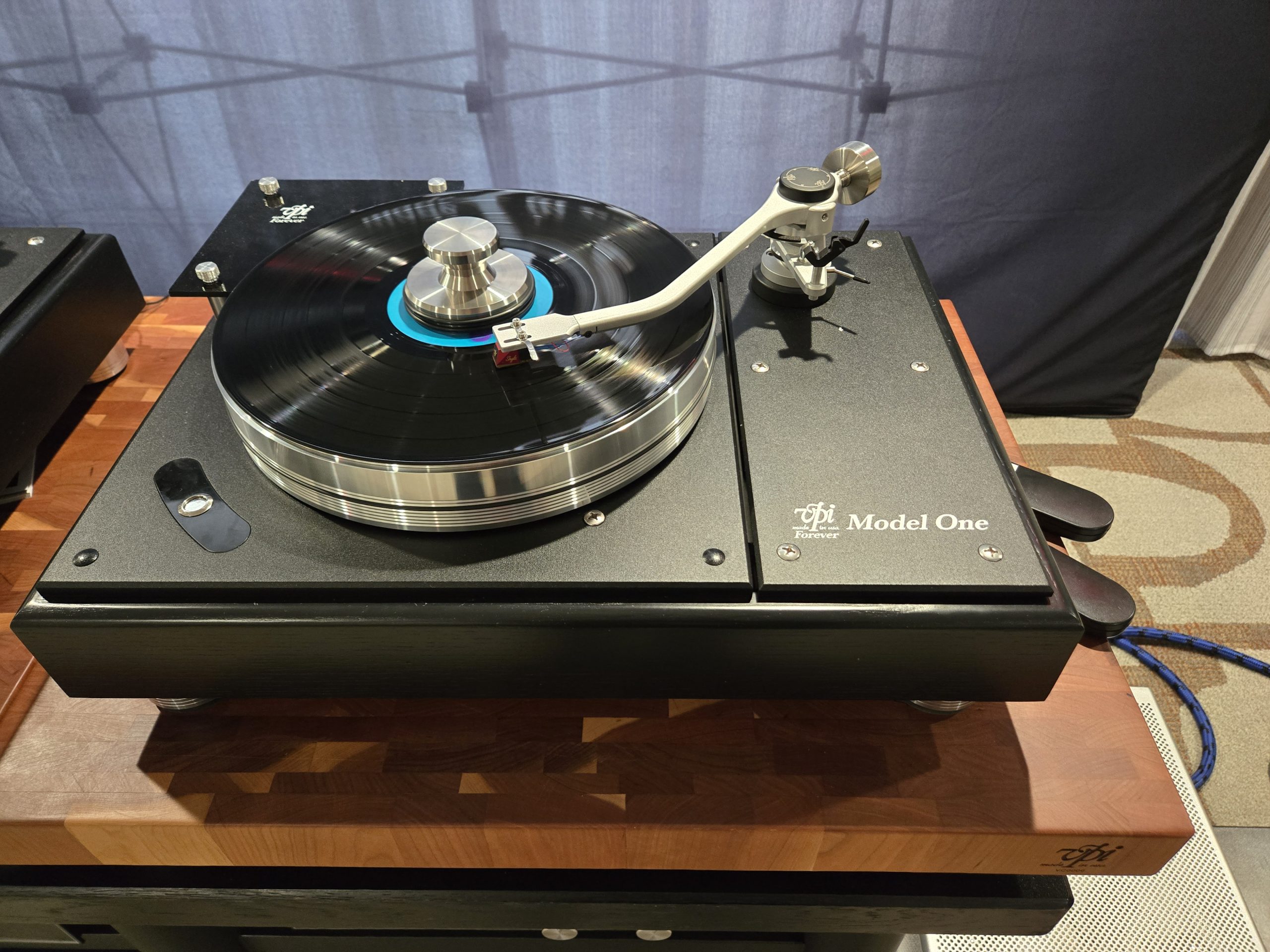
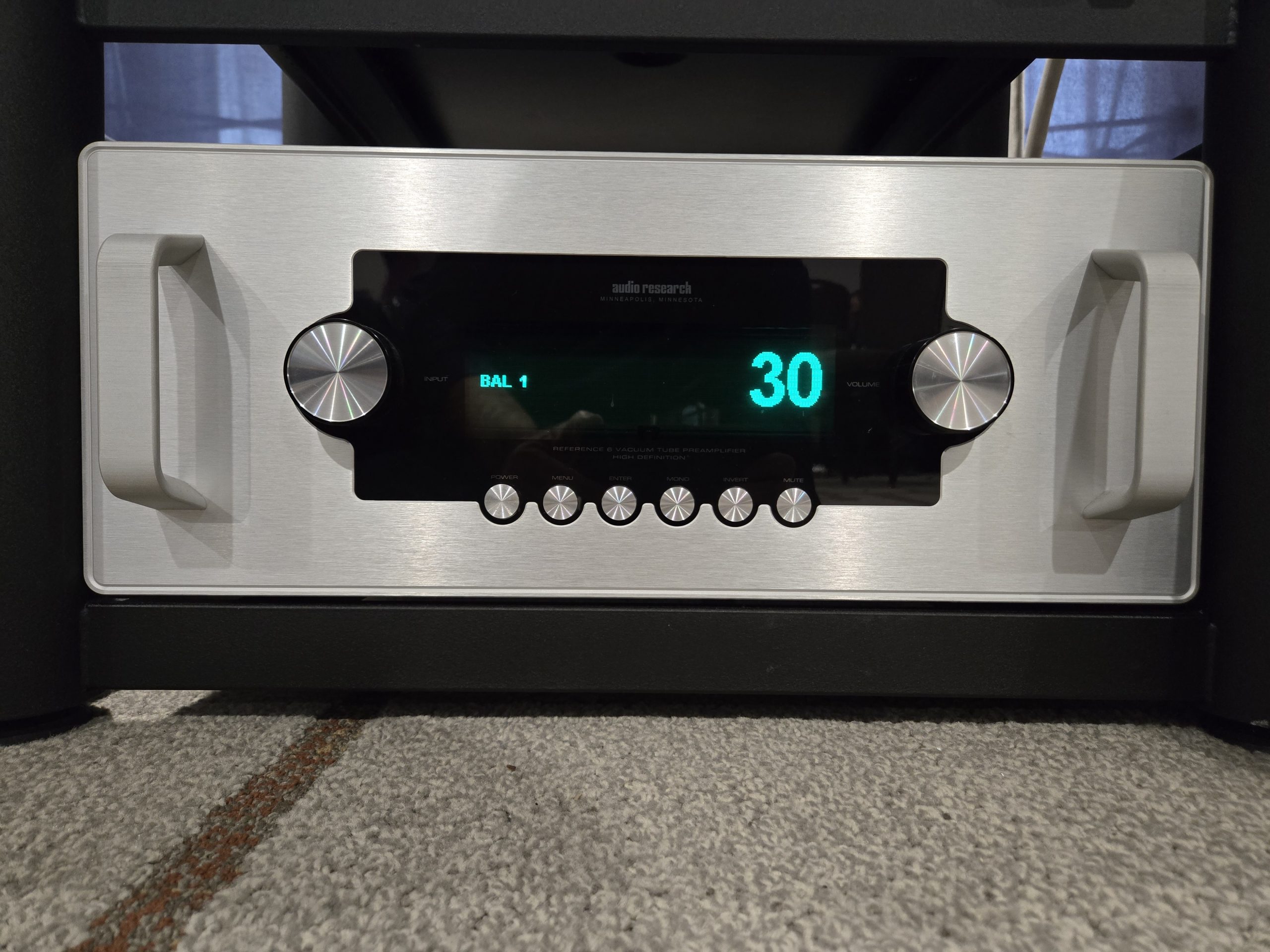
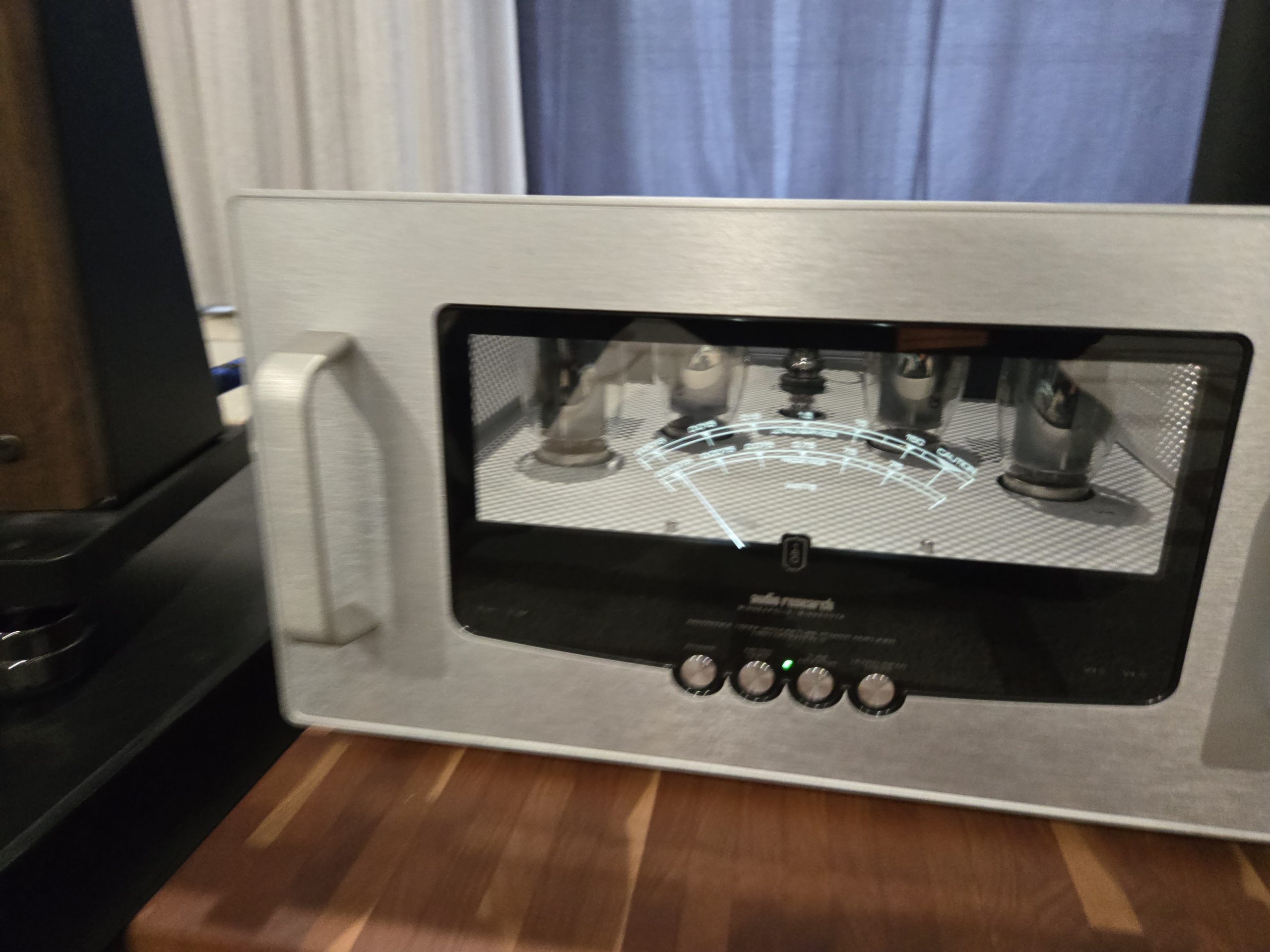
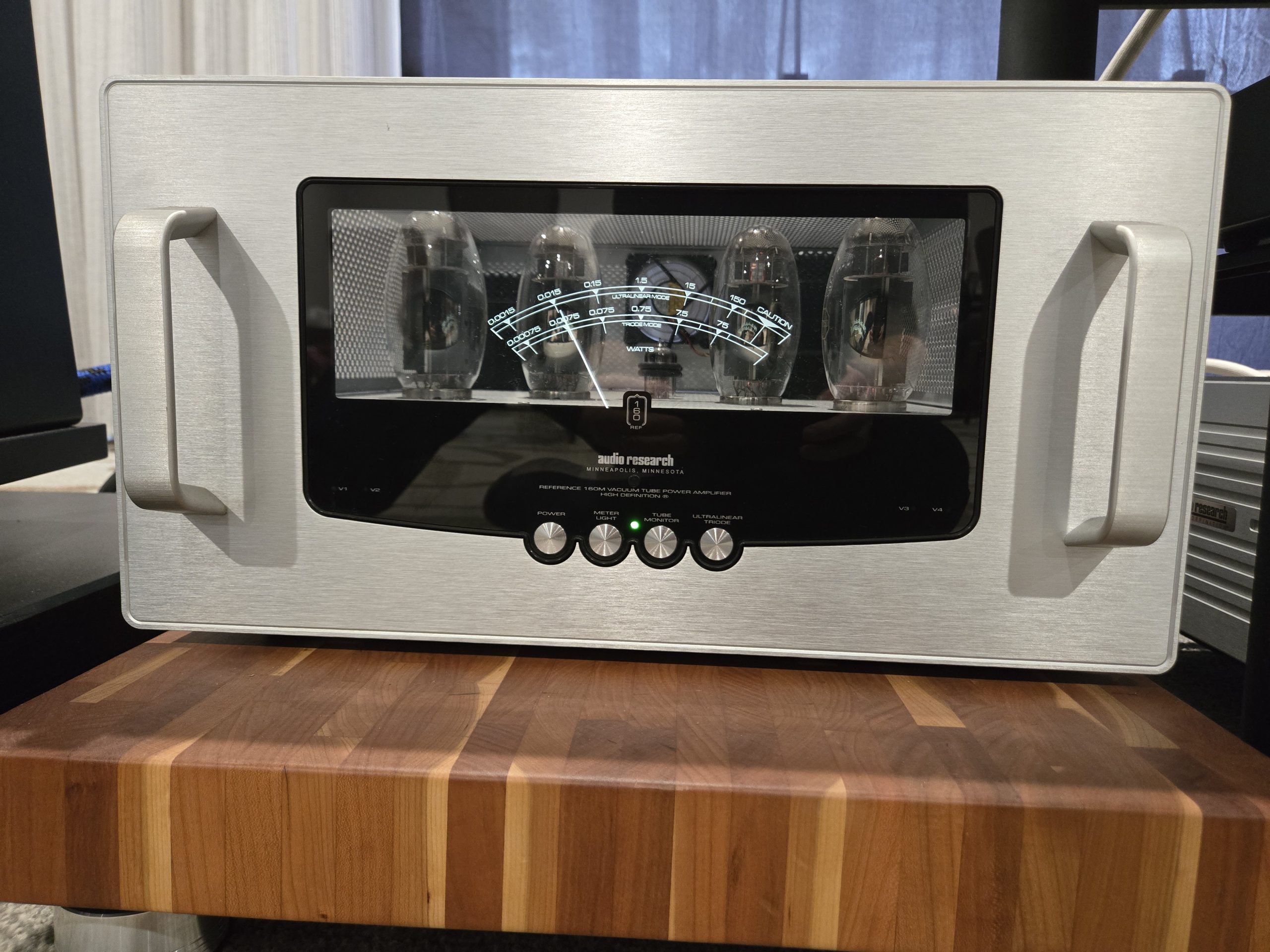 The system itself consisted of the VPI Model One turntable, which looks like $20,000 but only retails for $5250. The electronics were provided by Audio Research’s Ref 6 preamp ($22,500) and M160 Mono Blocks ($38,000 per pair). Pure Audio Project provided the speakers with their Trio 15, an open baffle speaker with a horn tweeter and ultra efficient base drivers. The speakers have a sensitivity rating of 96 dB (2.83 Volts/one meter), so it is only proper to point out that in most homes, one will not need to spend $60,500 on tube electronics in order to drive these speakers.
The system itself consisted of the VPI Model One turntable, which looks like $20,000 but only retails for $5250. The electronics were provided by Audio Research’s Ref 6 preamp ($22,500) and M160 Mono Blocks ($38,000 per pair). Pure Audio Project provided the speakers with their Trio 15, an open baffle speaker with a horn tweeter and ultra efficient base drivers. The speakers have a sensitivity rating of 96 dB (2.83 Volts/one meter), so it is only proper to point out that in most homes, one will not need to spend $60,500 on tube electronics in order to drive these speakers.
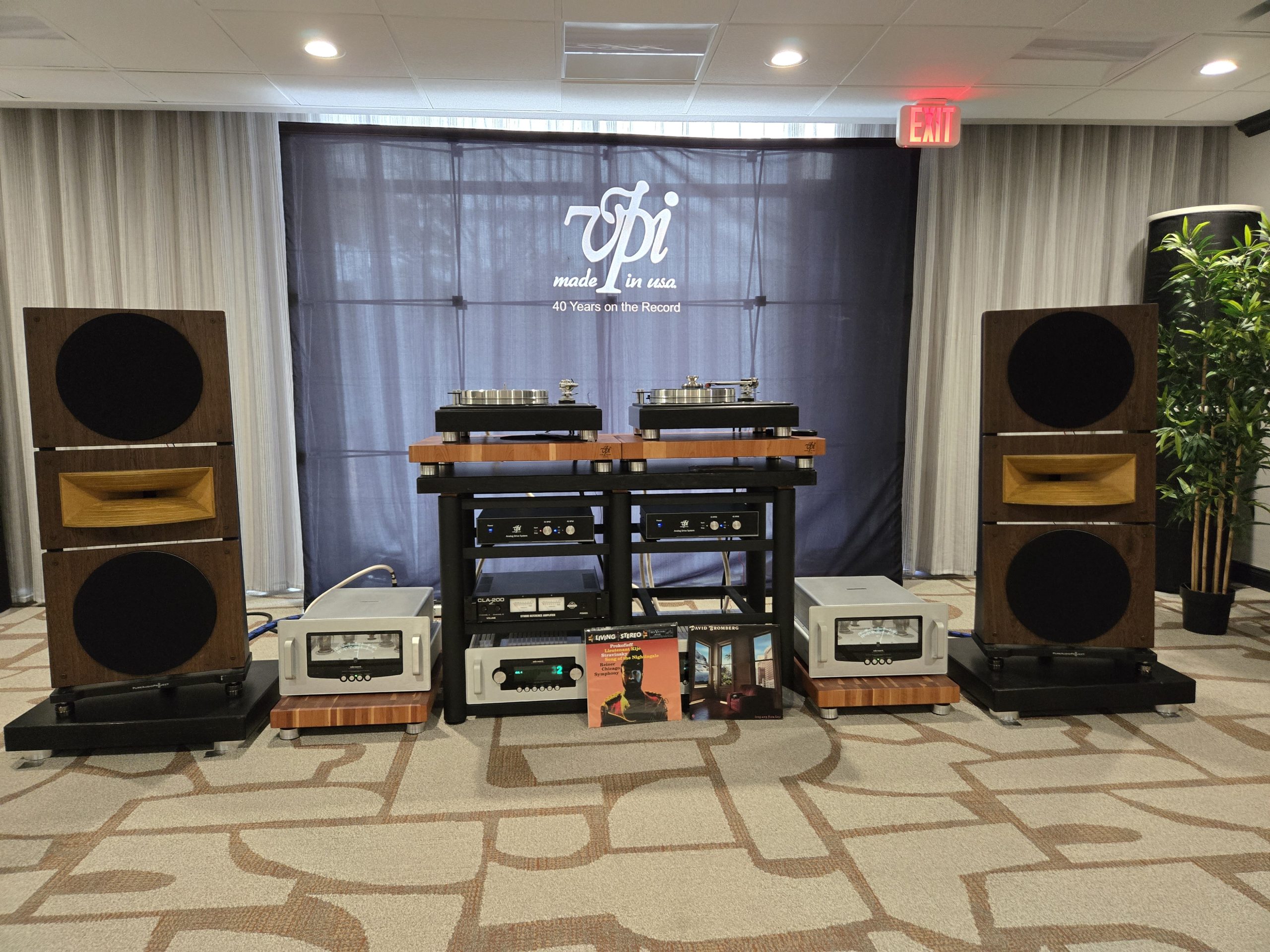
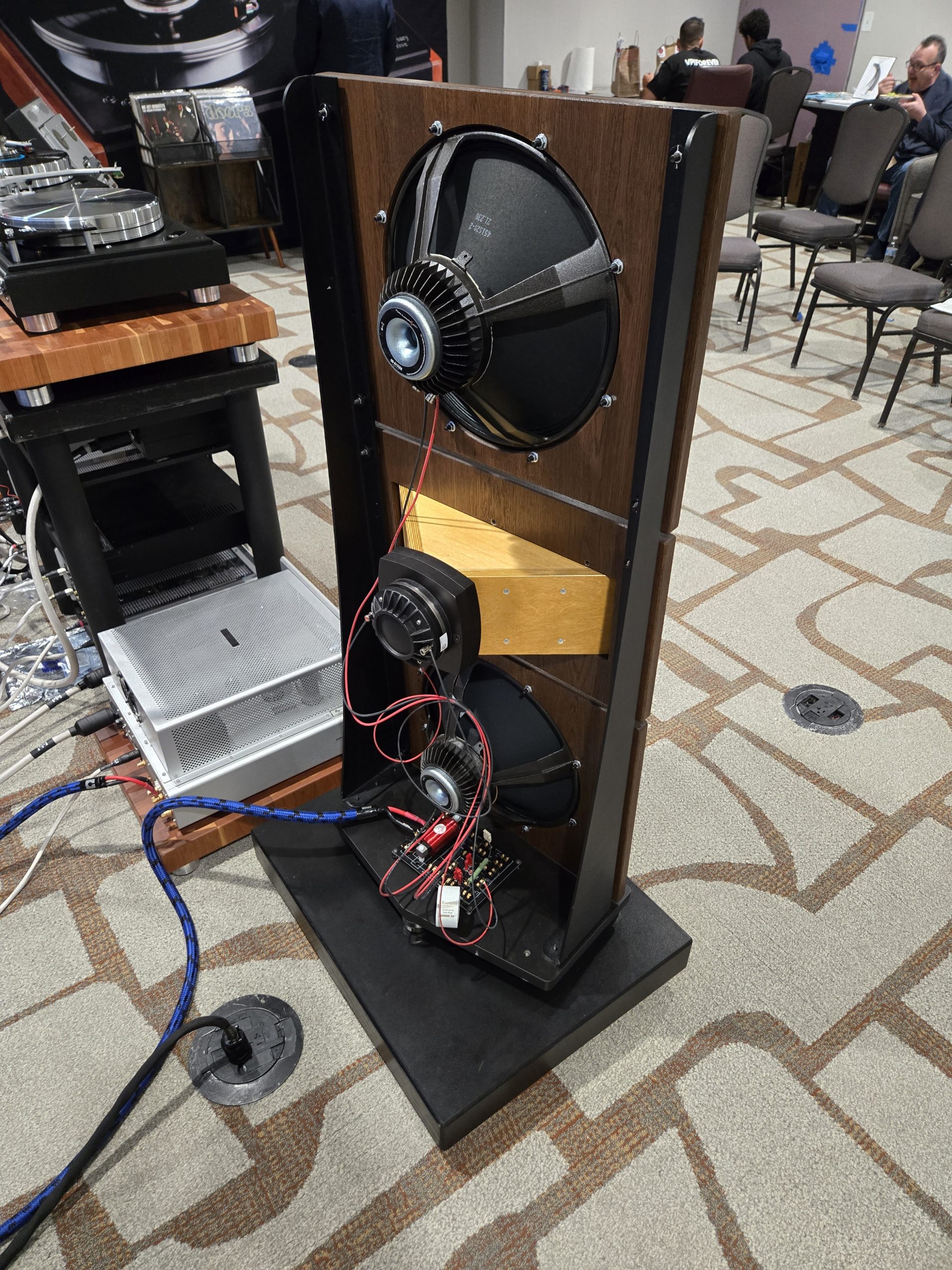
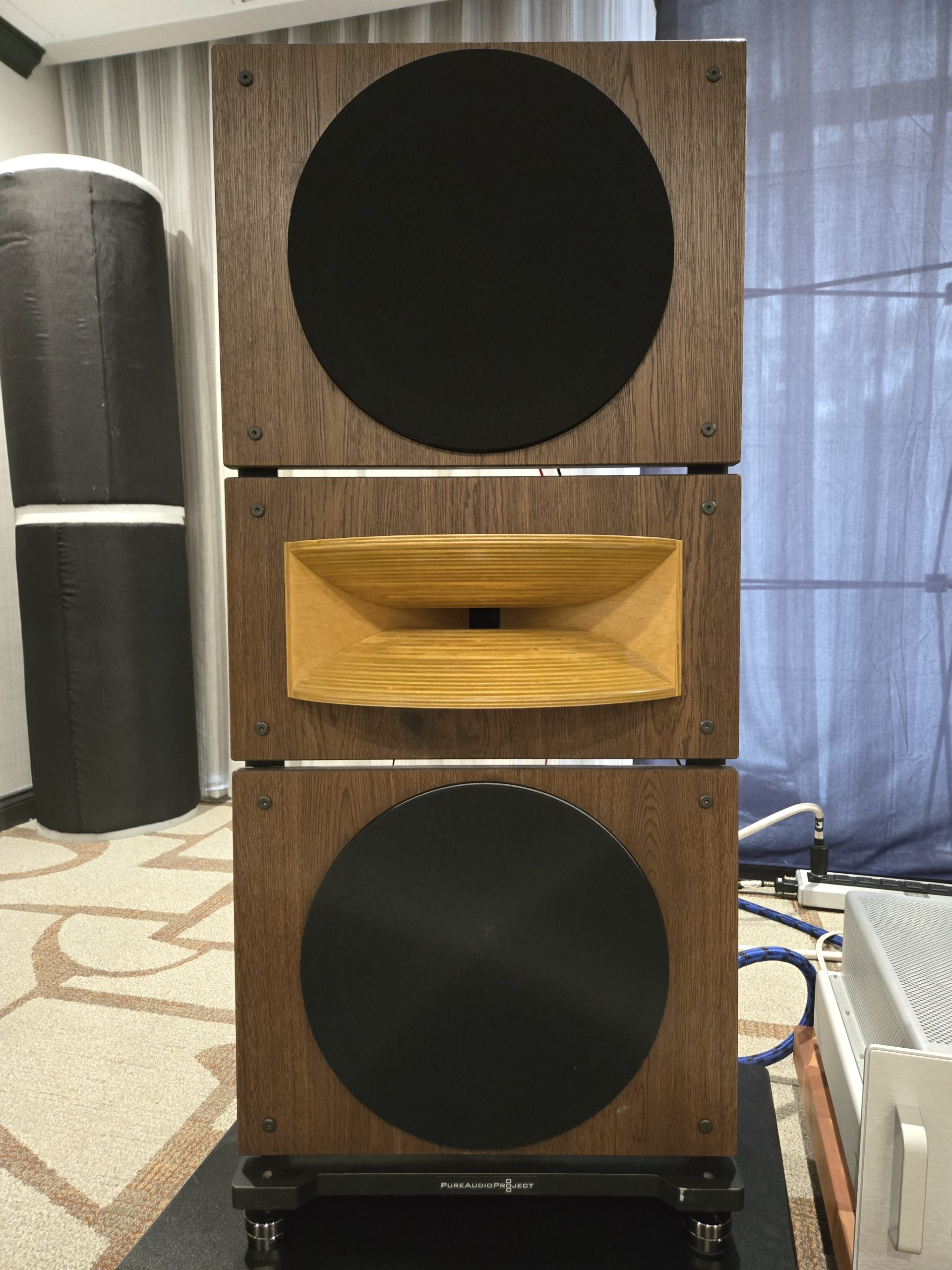 Why is that an important point? The Pure Audio Project Trio 15 start at $7900 per pair and were $9610 total for the speakers in the demo room. This includes IsoAcoustic GAIA feet, shipping and several other upgrades. There are a variety of tube amps in the 4-digit cost range which will deliver excellent results with these speakers.
Why is that an important point? The Pure Audio Project Trio 15 start at $7900 per pair and were $9610 total for the speakers in the demo room. This includes IsoAcoustic GAIA feet, shipping and several other upgrades. There are a variety of tube amps in the 4-digit cost range which will deliver excellent results with these speakers.
Once again, a variety of music was presented on this system, including a master vinyl of Supertramp’s ‘Crime of the Century’ along with live acoustic guitar tracks from unknown artists with a lot of talent. It was another hour of relaxing and hearing wonderful music. Secrets of Home Theater and High Fidelity has reviewed multiple VPI turntables over the years, and today shored up why their products always get great reviews. A special thanks to Mat and Harry for organizing several rooms, each with fantastic systems fronted by their turntables. As for Pure Audio Project and their speakers, their easy to drive speakers at real world prices put the cherry on today’s musical Sunday! To our Editor-in-Chief, we need to get a review pair!


